

FREE AND FREAKY SINCE 1971 | OCTOBER 13, 2022 One Chicagoan’s pandemic lockdown project turned into a time capsule of the city’s moviegoing past. By YOLANDA PERDOMO 38 historyChicago’s in movie ads NOW PL AYI NG ! NOW PL AYI NG ! Mental Health & Police 18 and 26 | Snakesploitation 43 | Podlasie Club 46
CITY LIFE
04 Street View Ray St. Ray, the Singing Cab Driver, is a Chicago legend.
FOOD & DRINK
06 Feature From Abby Pucker and community venture Gertie comes (A)Part, Chicago’s combination foodie guide, city map, and cultural experiment.
COMMENTARY
08 Joravsky | Politics MAGA men from Blago to Bolduc are trying to sing a new song.
10 Isaacs | Culture A historian on the escalating threat of white supremacist terrorism
12 Phone Call The new consent decree ending incommunicado detention is a victory over CPD abuse that was years in the making.
NEWS & POLITICS
16 Prisons Chicago Books to Women in Prison partners with Women and Children First to get books behind bars.
18 Police Significant issues remain around central Illinois police’s use of involuntary commitments for people experiencing mental health crises.
24 Brown | Sports A Step Ahead
Chess brings kids together online and in person.
26 Prout | Mental Health When the police bring too many risks with them, where can you turn in a crisis?
ARTS & CULTURE
28 Review Two exhibitions aim to repair broken connections.
30 Visual Arts Jeanne Dunning looks at what’s le behind.
THEATER
32 Destinos Festival Ricardo Gamboa talks about The Wizards white supremacy, and spooky stories.
34 Review Tiger Style! tries to overcome Asian stereotypes by leaning into them.
36 Plays of Note Theatre Above the Law revisits the Grimm Brothers; 1919 at Steppenwolf for Young Adults is galvanizing and poetic; Sancocho is a heartwarming story of Puerto Rican sisters.
FILM
38 Now Playing! One Chicagoan’s pandemic lockdown project turned into a time capsule of the city’s moviegoing past.
40 Indie Rock Local filmmaker Dan Stewart spent the summer shooting
Local Band, a film dedicated to Chicago’s DIY music scene.
42 Podcast Is Scream overrated? That Horrorcast documents a friendship built on questions like this.
43 ‘Snakies’ The horror microgenre of snake-centered B movies—or, snakesploitation cinema—is a serendipitous passion of mine.
44 Pride Film Festival Black queer love, trans Iranian justice, asexual visibility, and more
45 Movies of Note Till struggles to tiptoe between inspirational story and trauma fetish, Decision to Leave braids a heart-stirring tenderness into a murderous thriller, and Hocus Pocus 2 finally grants audiences their wish for a sequel.
MUSIC & NIGHTLIFE
46 Caporale | Feature Last year a new dance party turned a sleepy Polish bar into a hot spot—and prompted a gut rehab of the space. Now that Podlasie Club is open again, will it recapture that magic?
52 The Secret History of Chicago Music In a scene full of big personalities, Jim Post was a giant.
54 Shows and Records of
CHICAGO READER | OCTOBER 13, 2022 | VOLUME 52, NUMBER 1
TO CONTACT ANY READER EMPLOYEE, EMAIL: (FIRST INITIAL)(LAST NAME) @CHICAGOREADER.COM
Note Previews of concerts by the Superjane DJ collective, Patricia La Barbara, Algernon Cadwallader, and more, plus reviews of releases by the Christian Tabernacle Concert Choir with Pastor DeAndre Patterson, Freddie Gibbs, and Ariel Zetina
59 Early Warnings New concerts and other updated listings
59 Gossip Wolf Rapper-singer Angelenah makes her R&B debut with I Don’t Regret a Thing, Darkwave maestro Panic Priest drops a new album just in time for spooky season, and Matt Clark’s Otherpeace project covers six songs about LA.
SAVAGE LOVE
61 Knots Landing Dan Savage offers advice on why some who have submissive desires and traumatic sexual histories find BDSM therapeutic.
CLASSIFIEDS
60 Jobs, research, and more
ON THE COVER: PHOTO BY YIJUN PAN. FOR MORE OF PAN’S WORK, GO TO YIJUNPAN.COM.
A NOTE FROM THE EDITOR
Enrique Limón SARAH JOYCE/GLITTERGUTS
“GOOD THINGS COME to those who wait,” the adage goes. Back in the summer of 2009, I found myself in Chicago as an alternative journalism fellow at Medill, and I quickly fell in love with the city, its people, culture, and greasy spoons (if I close my eyes and concentrate hard enough, I can still taste the chili at Ramova Grill). Around the same time, I also started a one-sided love affair with the Reader.
Armed with the vim and vigor only a self-assured freelancer can possess, I transformed some of my big city exploits into would-be Best of Chicago blurbs I pitched to the then-editor. The entries encompassed topics such as “Best non-Latin neighborhood display of copyright infringement” and “Best place to get co ee and potentially pick up a foreign STI along the way.” I never heard back.
A few years later, my upward masthead journey landed me at the alt-weekly in Santa Fe, New Mexico, where I started as arts and culture editor, and was later promoted to deputy editor. Admiring from afar the quality content the Reader was producing, and with my unrequited relationship still going strong, I jumped at the opportunity to apply for the managing editor position—a big leap for me at the time, that I felt I was ready for. I was interviewed, but ultimately it wasn’t my turn, and the position was filled by someone more qualified. My dream job at my dream outlet, all while living in my dream apartment (atop Cafe Jumping Bean in Pilsen) would have to wait.
A stint as managing editor and later editor in chief at the alternative publication in Salt Lake City, Utah, as well as helming the launch of an international news startup followed. All the while, I kept thinking of the one that got away.
That all changed this month.
Shaping the Reader’s latest incarnation as a full-fledged nonprofit newsroom is not a responsibility I take lightly. The storied publication and its talented staff continue to be a force, and it’s my pleasure to usher in what its next 50 years in the community will look like.
The road might have been long, but trust me when I say the prize is oh so sweet. Cheers to what lies ahead! (Oh, and if anyone has leads on that apartment, please let me know.)
ENRIQUE LIMÓN, EDITOR IN CHIEF
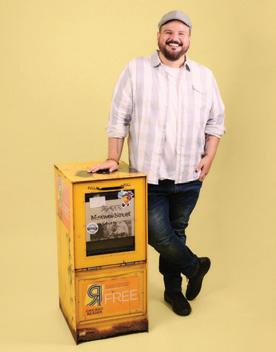
PUBLISHER AND PRESIDENT TRACY BAIM EDITOR IN CHIEF ENRIQUE LIMÓN MANAGING EDITOR SALEM COLLO-JULIN PRODUCTION MANAGER KIRK WILLIAMSON SENIOR GRAPHIC DESIGNER AMBER HUFF STORY EDITOR SUJAY KUMAR NEWS EDITOR JIM DALEY THEATER AND DANCE EDITOR KERRY REID MUSIC EDITOR PHILIP MONTORO CULTURE EDITOR: FILM, MEDIA, FOOD & DRINK TARYN ALLEN ASSOCIATE EDITOR AND BRANDED CONTENT SPECIALIST JAMIE LUDWIG SENIOR WRITERS LEOR GALIL, DEANNA ISAACS, BEN JORAVSKY, MIKE SULA STAFF WRITERS DEBBIE-MARIE BROWN, KELLY GARCIA, KATIE PROUT LISTINGS COORDINATOR MICCO CAPORALE
VICE PRESIDENT OF OPERATIONS ANN SCHOLHAMER
DIRECTOR OF DIGITAL JOHN DUNLEVY
DIRECTOR OF MARKETING VIVIAN GONZALEZ MARKETING PROJECT STRATEGIST SHAWNEE DAY
DIRECTORS OF CIMA SAVANNAH HUGUELEY, YAZMIN DOMINGUEZ
EXECUTIVE ASSISTANT SANDRA L. KLEIN
SENIOR VICE PRESIDENT OF GROWTH AND STRATEGY AMBER NETTLES VICE PRESIDENT OF SALES AMY MATHENY SALES TEAM VANESSA FLEMING, TIM OGDEN, TED PIEKARZ, WILL ROGERS DIGITAL SALES ASSOCIATE AYANA ROLLING
ADVERTISING
312-392-2970, ADS@CHICAGOREADER.COM CLASSIFIEDS: CLASSIFIED-ADS@CHICAGOREADER.COM
NATIONAL ADVERTISING
VOICE MEDIA GROUP 1-888-278-9866
VMGADVERTISING.COM JOE LARKIN AND SUE BELAIR
DISTRIBUTION CONCERNS distributionissues@chicagoreader.com 312-392-2970
READER INSTITUTE FOR COMMUNITY JOURNALISM, INC.
CHAIRWOMAN EILEEN RHODES
ACTING SECRETARY KIM L. HUNT DIRECTORS ALISON CUDDY, VANESSA FERNANDEZ, ROBERT REITER
READER (ISSN 1096-6919) IS PUBLISHED BIWEEKLY BY THE READER INSTITUTE FOR COMMUNITY JOURNALISM 2930 S. MICHIGAN, SUITE 102 CHICAGO, IL 60616 312-392-2934, CHICAGOREADER.COM
COPYRIGHT © 2022 CHICAGO READER PERIODICAL POSTAGE PAID AT CHICAGO, IL
ALL RIGHTS RESERVED. CHICAGO READER, READER, AND REVERSED R: REGISTERED TRADEMARKS ®
2 CHICAGO READER - OCTOBER 13, 2022 ll
THIS WEEK
IN THIS ISSUE
Bold Stories, Bold Voices, Our Bold Library









What happens when award-winning playwright Tony Kushner, Top Chef Rick Bayless, and TikTok sensation Shermann “Dilla” Thomas walk into the room? Join us on October 19 to find out.

The Chicago Public Library Foundation Awards are back for another year of celebration! We are bringing bold storytelling—from our tables to TikToks to theaters—and the powerful ways stories can nourish, connect, and inspire us to act. Join us for a free YouTube broadcast of the Awards on Wednesday, October 19 at 6:00 pm CST. Everyone is welcome to tune in and no ticket is required.
Every year, the Foundation presents the Carl Sandburg Literary Award to an esteemed author. Acclaimed playwright, screenwriter, and activist Tony Kushner will receive the 2022 Carl Sandburg Literary Award. Best known for his two-part epic Angels in America: A Gay Fantasia on National Themes and the musical Caroline, or Change, Kushner also has numerous screenwriting credits including the screenplays for Mike Nichols’ adaptation of Angels in America, and Steven Spielberg’s Munich, Lincoln, and West Side Story.

The broadcast, hosted by legendary Chicago newscaster Bill Kurtis, will feature an intimate conversation with Kushner and best-selling author and National Public Radio (NPR) host Sco Simon filmed in front of a live audience.








The Arts Award, celebrating the power and impact of Chicago’s artistic community, will be presented to the globally recognized chef, restaurateur, and philanthropist Rick Bayless. With nine award-winning cookbooks to his name, Bayless is celebrated for his culinary prowess as well as his innovative approach to foodcentric storytelling with plays like Cascabel and Recipe for Disaster, an immersive food-filled farce that le audiences howling.
TikTok sensation, urban historian, and lifelong Chicagoan Shermann “Dilla” Thomas will receive the 21st Century Award, which honors significant recent achievements by a creator with ties to Chicago—marking the first time this award goes to a digital artist. Through his social media accounts, Dilla preserves and shares the history and culture of Chicago, highlighting its people, architecture, and impact on the world. His creativity makes Chicago’s rich history accessible and engaging to a broad audience.

In 2021, over 8,500 participants worldwide experienced the 2021 Library Foundation Awards and contributed $1.5 million to advance the Library’s accessible and high-impact programs like free homework help, digital courses for adults, and creative opportunities for teens.
“What an incredible honor to be an innovation lever for Chicago Public Library for more than 36 years – investing resources in groundbreaking programs and initiatives that transformed lives and communities. The Library Foundation will continue to be a partner to the Library in finding new ways to serve Chicago communities,” said Brenda Langstraat Bui, President & CEO of the Chicago Public Library Foundation.
The event’s Presenting Sponsor is BMO. Mayor Lori Lightfoot & First Lady Amy Eshleman, Governor JB Pritzker & First Lady MK Pritzker are honorary chairs.



Tune in to the Awards for free at cplfoundation.org/awards.
Donations at every level to the Library Foundation Awards support free lifelong learning programs and resources for all at Chicago Public Library.
OCTOBER 13, 2022 - CHICAGO READER 3 Paid Sponsored Content
CITY LIFE
Street View
years. When the band broke up ten years ago, he decided to pursue a solo career as the Singing Cab Driver.
By ISA GIALLORENZO
“Entertainer, street philosopher, raconteur. I cruise the streets like a wandering knight seeking people to save from time and space, and perhaps life itself,” says Ray St. Ray, 70, accurately describing his iconic persona. “I’m in the business of creating the legend of ‘the Singing Cab Driver’ for people to cash in on with an interesting story to tell. That makes your life more interesting—now what you do with that is up to you,” he adds.
E lusive as legends should be, St. Ray is not available upon demand: “If you already know about me, you’re already in the club. I got to find people who don’t,” he says. To add to his aura of mystery, St. Ray doesn’t allow recordings of his cab performances; as he explains, “When you record something, you’re not experiencing the thing, you’re experiencing recording something.”
In that same vein, St. Ray is not a huge fan of social media, stating that he is a “one-onone, real-life kind of person.”
S t. Ray claims to have entertained an audience of more than 100,000 passengers since he started driving his cab in 1991. It all started when he “got a kick” out of singing during a New Year’s Eve gig, making him realize he wanted a career in showbiz. “At that point in my life, I was already almost 40. I had to pay child support to two ex-wives for two little daughters I loved very much who lived in two suburbs far from each other and from where I lived. I was unemployed, I couldn’t play any instruments, and had never been in a band before the evening I made this decision. I’m not gay, not Jewish, I’m not even Canadian. Under these circumstances, success in American showbiz ain’t happening overnight. I need a plan, and that plan better include a day job with flexible hours, no career commitment, daily cash flow, and a large insured company car to go see the kids in,” St. Ray reminisces.
At first, he started singing to his passengers to promote the shows with Chameleon World, the band he played with for over 20
St. Ray considers his songs to be “the yellows—the opposite of the blues. Happy, snappy, up-tempo music for people who can still think and hear, or at least dance,” he says. “I just write songs in whatever style fits, but my influences are 60s pop and old movie music, like James Bond themes.” He writes about “love, sex, social significance, and dreams,” which he calls the four topics of life.
H e is currently writing a script for an upcoming podcast called Future Man Versus The Wrong Side of Enough , “a musical manifesto about the theft of our future. We used to be people who shared and achieved dreams. Now we spend much of our time arguing over which nightmares are more worthy of attention. Our future has been hijacked. Basically big money has been buying the governments and changing the rules in their favor. Both parties are working for the same groups of people competing for control of our society,” he says.
To deal with the ways of the world, he adopts the philosophy of “riding the razor’s edge of giving a shit.” “If you care too much, there will never be a shortage of people who need you, your money, your attention, your help. But if you don’t give a shit, you are an asshole, and you’re just adding to the misery of the universe. I think the secret of happiness and living a long life is to ride the razor’s edge between the two.”
This attitude might have helped during some reversals of fortune St. Ray has encountered, such as the advent of ride-hailing apps (just before COVID hit, he was making so little money he thought he would have to quit driving). Still, he always looks impeccable, like a modern dandy superhero with plenty of flair.

“It’s my effort to make yours a more beautiful world, starting with my image in the mirror,” he says. St. Ray thrifts most of his garments, but he always looks for quality, yet costumey stuff.
“ I enjoy an anachronistic look—something like in the 1920s, or from an old cowboy movie, or detective novels, like pulp fiction,” he says. “My purpose is to live the life that I would want to read a book or see a movie about. I’m living that life, and it’s a musical—which is even better.” v

@chicagolooks
4 CHICAGO READER - OCTOBER 13, 2022 ll
His name is RayRay St. Ray, the Singing Cab Driver, is a Chicago legend.
Find more music and info at singingcabdriver.com
Ray St. Ray ISA GIALLORENZO




OCTOBER 13, 2022 - CHICAGO READER 5 Museum of contemporary art Wednesday, November 30, 2022 VIP RECEPTION 6:00 - 7:00 PM + GENERAL 7:00 - 11:30 PM Museum of Contemporary art chicago 220 e. chicago ave. Chicago, IL FOR MORE INFORMATION + TICKETS SCAN THE QR CODE OR VISIT chicagoreader.com/50ish
FEATURE
A new kind of recipe book

From Abby Pucker and community venture Gertie comes (A)Part, Chicago’s combination foodie guide, city map, and cultural experiment.
By COURTNEY SPREWER
Can we be honest with each other? (It’s kind of required for this reading exercise and the book review that’s hidden in here somewhere.) OK. Ready?
Neighborhoods in Chicago can be dog whistle terms. It’s all right to admit that many of you are much more interested in a new bar, club, or restaurant opening in one of the Loops (South and West, respectively) than you are in a new bar, club, or restaurant opening in one of the ’woods (Engel, Ravens) or the Parks (Hyde, Garfield, Humboldt, etc.). But what if we redefined those arbitrary borders that make up the different Chicago neighborhoods and often subconsciously drive our choices when it comes to deciding where or where not to visit?
Enter Abby Pucker and her new community venture, Gertie. Gertie is described as a “sports team for arts and culture,” if you will. Its mission is to build a community of young professionals in Chicago (both transplants and natives) who are ready to engage with the city and each other in new ways. And (A)Part: A Recipe Guide-book to Chicago (if you will) is the companion piece to the new venture—meant to introduce the reader to di erent restaurants, recipes, neighborhoods, and cultural landmarks through the eyes of 27 di erent Chicagoans.
Just to note a few members of the well-rounded cohort of Chicagoans hailing from a variety of sectors, ages, races, and com-
munity a liations, contributors include some names you may know: rapper, actor, and cannabis entrepreneur Vic Mensa; photographer, director, and owner of Monday Co ee Felton Kizer; chef/co-owner of Thattu Margaret Pak; and now, community organizer Abby Pucker. And then there are some you don’t know but will be introduced to. The book is intended for “anyone willing to be curious.” So while more than 40 different traditionally defined neighborhoods are technically represented, all of the cultural maps are drawn without identifying neighborhoods. They’re simply plotted on a grid with guideposts that mark the four “directions” of the city. In Abby’s own words, the book is meant to be “an experiment in retracing and redefining community through aligned cultural interests and passions, rather than ZIP code.”
The book is short and sweet, just like the perfect Chicago day—especially for this time of year, when the sun starts to set earlier and the windchill makes you want to go inside before dark anyway. Also much like Chicago, the book’s layout is inviting, but it makes absolutely no attempt to fit in. Highlighter-pink text matches a bright-fuschia plaid-printed cover, completely destroying any minimalist co ee-table decor plans you may have had for it. It is wire-bound and more akin to a field guide than a recipe book. I’d even recommend a pencil for note-taking, recipe conversions,
and Xs to mark spots that hit a specific place in your heart and stomach.
(A)Part wants you to explore the city, even the parts you may feel a bit hesitant to visit without a chaperone, a cosigner—hell, at least a regular’s go-to menu order. The book has taken into account the reader’s likely trepidation by ignoring it completely. Once you get past the first few pages of contributors, you’re greeted with a foreword that reminds you, “Trust—in institutions, government, and, frankly, each other—is at an all-time low.” That lack of trust often lends to isolationism and encourages people to turn inward, be it into themselves in the form of serial delivery-app orders, or be it inward to faces and places they know best, hyperlocal (and maybe a little exclusionary?) communities where diversity of thought, taste, and opinion are shunned. (A)Part reminds you: “Chicago has some trust issues, and they are warranted, but that doesn’t mean they’re inevitable.”
So the goal with this recipe book, if you will, is to bring together each contributor’s experiences in this city like di erent ingredients in a recipe, working together to create something deliciously greater than the sum of their parts. By the end of it, Abby and team hope to impress upon the reader the importance of community through an active exercise of reimagining those mental and geographic borders that keep us (a)part. (See what she did there?)
What secret spots could this book possibly reveal to me that my favorite viral TikTok or Chicago lifestyle site has yet to unearth, you ask? Well, here’s a quick sampling of the recommendations you’ll find in the pages of (A)Part:
• A former Best Buy turned beauty supply store mecca
• The urban ruins of what used to be a legal gra ti art gallery (It is now the back wall of a Target.)
• Intimate details of our very own inner-city chocolate factory (The chocolate cake in a bag recipe is included; the funny man in hat and Oompa Loompas are not.)
• A special family pizza recipe, the most Chicago-style you can get
• A Black- and queer-owned bar in Andersonville where the contributor often runs into north-siders, south-siders, west-siders, out-of-towners, and sometimes even their therapist
• A Ukrainian eatery and pastry shop with a highly recommended (by the contributor) brunch (and special mention to the tarragon pierogi in a light dijon cream sauce)
• More monuments, parks, and gardens than you can fit into your schedule before the weather breaks for good, and a variety of theaters, work-from-elsewhere spaces, restaurants, museums, and shops to visit once it does
• A Kenyan-Indian-Canadian-Chicagoan transplant immigrant’s guide to Chicago through their multicultural lens (This includes their mom’s goan prawn curry recipe.)
• An account of Cook County Jail—a place that, in my opinion, every Chicagoan should visit at least once (to volunteer, not by force or order of the court, hopefully)
• A flourless, eggless, sugar- and dairy-free “cookie” recipe from a Chicagoan with GI issues who reflects on his favorite meals that he’s no longer allowed to eat
• A family pu pu recipe and north-side guide to the African grocery and braiding shop, straight from the notes of a self-proclaimed Chigerian
• Basically, everything from Norwegian openfaced sandwiches to southern red beans and rice v
@EatDrinkDoWear
6 CHICAGO READER - OCTOBER 13, 2022 ll FOOD & DRINK
(A)Part: A Recipe Guide-book to Chicago (if you will) on a busy table CHASE BAXTER
Find more one-of-a-kind Chicago food and drink content at chicagoreader.com/food.




















































































OCTOBER 13, 2022 - CHICAGO READER 7 sites150+ 15 – 16 October neighborhoods20+ discoveriesENDLESS The Chicago Architecture Center app is your key to sites across the city during OHC weekend. Plus, programs and self-guided tours throughout the month. openhousechicago.orgGET IT ON
COMMENTARY
ON POLITICS
MAGA flip-flops
Men from Blago to Bolduc are trying to sing a new song.
By BEN JORAVSKY
Over the past few weeks, it’s becoming obvious that not all of MAGA actually believes the poison they’ve been peddling. Not that it makes that poison any less toxic, or harder to clean up.
Plenty of examples—with new ones popping up every day as we get closer to the midterms—but let’s start with a case closer to home, featuring our old friend Governor Blago.
Rod Blagojevich is, of course, our former governor who went to federal prison on corruption charges, including, though not limited to, trying to shake down the CEO of a children’s hospital for campaign contributions.
As part of its investigation, the feds tapped Blago’s phone, where they captured this immortal quote, which, I’m sure, will go down in history as his greatest single contribution to humanity.
“I’ve got this thing and it’s fucking golden.
I’m just not giving it up for fucking nothing.”
That “thing” he had was his authority to fill the Senate vacancy created when Barack Obama was elected president. Which Blago seemed determined to give to the highest bidder.
Eventually, Blago was sentenced to 14 years in prison (too long, in my opinion). He did about eight years, before President Trump commuted his sentence in 2020.
Blago returned to Chicago and became an enthusiastic MAGA man, railing against Democratic causes, including the SAFE-T Act, which, among other things, eliminates cash bail.
Now you’d think a felon who feels he was unfairly investigated, arrested, indicted, convicted, and sentenced would not sign on to MAGA policies that would give authorities even more authority to arrest people and throw them into jail—where they remain, guilty or not, because they can’t post bail.
But apparently, Blago, like his hero Trump, is more of a do-as-I-say-not-as-I-do kind of guy. As such he took to Twitter to blast the SAFE-T Act. And that’s where “Bob Peters” comes into the story. He read Blago’s tweet and got upset because . . .
“Bob Peters” is actually state Senator Robert Peters, a Democrat out of Hyde Park, who co-authored the SAFE-T bill, along with the so-called PFA provision that eliminates cash bail. Yes, the bill eliminates cash bail. But that does not prohibit a judge from ordering a defendant to be detained. Despite what you might hear from everyone from Darren Bailey to Blago to Joe Rogan.
Noting that Blago had a Cameo account, which enables anyone to buy his services for about $200, Peters wrote a script and asked Blago to read it. He asked that Blago email the message to “Bob Peters.”
The message was addressed to “Dare Bear,” aka Darren Bailey, the Republican candidate for governor against J.B. Pritzker, who temporarily rented an apartment in the John Hancock building, so he can report what it’s like to live in what he calls the “inner city.” Here’s the script that Peters wrote.
“Hey Dare Bear, I know you just moved and it hasn’t been the easiest transition. I have really good news though. You are about to see an exciting new development at work. It is called the PFA [Pretrial Fairness Act]. Everyone is so excited for when the PFA project goes live. The PFA will drastically improve the lives of your friends and family. This thing is ‘fucking golden!’ The PFA was worked on by a broad coalition at work. Dare Bear, I hope when you move back home that you don’t look at this journey as a failure but as an important learning opportunity about life. As the Rolling Stones say, [you] can’t always get what you want, but you get what you need.”
Blago read the script—quite convincingly, I might add—just as “Bob Peters” wrote it. Right on down to the “fucking golden” part.
Now, I can’t be surprised that Blago, a grifter from long ago, would contradict himself on the issue of pretrial bail in exchange for a few bucks. But he’s by no means the only MAGA
man doing flip-flops these days.

Up in New Hampshire, there’s Senate candidate Don Bolduc. For the last year, Bolduc’s been a ferocious election denier, insisting the presidential election was stolen and Trump actually won.
Even though we all know that’s a lie and Joe Biden beat Trump.
At an August debate of Republican candidates, Bolduc refused a chance to back o on election denial, declaring: “damn it, I stand by [it].”
On September 13 he won the primary. And two days later he flip-flopped, telling an interviewer, “I’ve done a lot of research on this, and I’ve spent the past couple weeks talking to Granite Staters all over the state from every party, and I have come to the conclusion—and I want to be definitive on this—the election was not stolen.”
Not sure what evidence he uncovered to change his mind, but I hope he shares it with other election deniers, including Trump, so they might also see the light. My guess is Bolduc’s advisers told him he has no chance of unseating Democratic senator Maggie Hassan unless he backs o on the idiocy. So back o it he did.
Just as Blake Masters, a MAGA man running for senator in Arizona, recently “erased from his website some of his more emphatically right-wing stances on immigration, abortion, and the lie that the 2020 election was stolen,” as the New York Times put it. In short, Masters canceled his own culture. Quick, call Joe Rogan! Really, I don’t know how MAGA can stomach these flip-floppers.
One day they say they’re against the SAFE-T Act and the next day they’re for it. One day they say every fertilized egg is sacred and the next day they say it’s not. And one day they say we gotta stop the steal! And the next day they say there was no steal to stop.
Not sure which is worse—believing the bullshit they spout or spouting it just to win over MAGA. Either way they’re leaving tons of toxicity in their wake. v
@bennyjshow
8 CHICAGO READER - OCTOBER 13, 2022
“Hang on, I’m getting a Cameo notifi cation.” ROHIT TANDON/UNSPLASH
PaidSponsoredContent



MeetAnnaDeShawnofE3
RadioandtheQube
E3RadioisaproudmemberoftheChicagoIndependent MediaAlliance(CIMA),apartnershipofindependent, localmediaentities.TodaythroughOctober17th,donate directlytoE3Radioandnearly40otherlocalmedia CIMAoutletsatSaveChicagoMedia.org. VisitSaveChicagoMedia.org


ChicagonativeAnnaDeShawnbecameinterestedinbroadcastingatayoung agethroughwatchingRobinRobertsonESPN,butshequicklybecame disillusionedbythebiasesandsuperficialitiesthatwererampantinthe televisionindustry.“IquicklyrealizedthatIwasnotthefaceoftelevision, becauseI'mmasculineofcenter,Idon'twearmakeup,andI'mnotfemme presenting,andthatwastheimageIwasseeing,”shesays.





Sheeventuallyfoundhernichewhen,asastudentatDrakeUniversity,she landedaninternshipforthepopularradioshowTomJoynerMorningShow.“I realizedIcouldtalktothousandsofpeopleandmakeanimpactwhile wearingsweatpants.Ithought,‘Thisisthelife.’AndsoIfellinlovewith radio.”


InspiredbyherstudiesofinfluentialBlackwomen,includingactivistsElla kerandElaineBrown,shepilotedaPSAcampaignthatshehopedto syndicatetocollegeradiostations.Whenthatfailedtotakeoff,shedecided



InNovember2009,DeShawnlaunchedE3Radio,whichspotlightsqueer musicandnewsstories.“Itwasapassionproject,andit’sevolvedsomuch overthepast12years,”shesays.“Todaywe’reon24/7.Weplayqueermusic nandreportonqueernews.Webelieveintellingthestories Lastsummer,DeShawntookhervisiontothenextlevelwhenshefounded fBIPOCand
QTPOCtalent.“TheQubeistheevolutionofE3Radio,150percent,”she says.“Theworldhasmovedtopodcasting,andwe’removingalongwithit, lybecausewelovelisteningtopodcasts,andpartiallybecausewe founditincrediblydifficulttofindgoodpodcastsoutthereintheworldthat centeredourexperiencesandhadhostswholookedlikeus.Wethought,

OCTOBER 13, 2022 - CHICAGO READER 9
angelagreenman.com
COMMENTARY
ON CULTURE
From domestic terrorism to the voting booth
Scholar Kathleen Belew on the escalating threat of white supremacist terrorism
By DEANNA ISAACS
“EXTREMISM IN AMERICA: PUSHING BACK ON RADICALISM AND SAVING OUR DEMOCRACY”
Sat 10/22 4: 30 PM, Northwestern University Norris University Center, 1999 Campus Dr., Evanston, chicagohumanities.org, $20 ($15 CHF members, $10 students and teachers)
Kathleen Belew COURTESY HARVARD UNIVERSITY PRESS
When Michael Fanone, the former Trump supporter and D.C. cop who nearly died at the hands of the January 6 mob at the U.S. Capitol, comes to the Chicago Humanities Festival next week to join We Are Proud Boys: How a Right-Wing Street Gang Ushered in a New Era of American Extremism author Andy Campbell on a panel about “Extremism in America,” their moderator will be a Northwestern University history professor as obsessed with the subject as they are.
Kathleen Belew’s first book, Bring the War Home: The White Power Movement and Paramilitary America, was published in 2018, when she was an assistant professor at the University of Chicago. (She moved to Northwestern this year.) She co-edited an anthology, A Field Guide to White Supremacy, published in 2021 as a manual for journalists and anyone else seeking to understand this phenomenon. She says her focus is “history of the present.”

Here’s an edited version of a conversation we had this week.
Deanna Isaacs: You’ve written that the white power movement has been largely invisible because it operates as “leaderless” resistance? What’s that?
Kathleen Belew: Leaderless resistance is cell-style terrorism. It was implemented
around 1983 to make it more difficult to prosecute people and to make it more difficult for informants to infiltrate. But the bigger consequence has been that this whole movement has been able to disappear. We tend to consume news about white power activism and militant-right activity as single incidents instead of part of a groundswell. We get stories about Charleston as anti-Black violence, El Paso as anti-Latino violence, Tree of Life shooting as antisemitic violence, when all of those are carried out by white power gunmen. All of this and January 6 are part of the same movement. There’s an enormous amount of circulation of ideas, people, weapons, and strategy between all of these di erent groups.
The current white power movement came together at the end of the Vietnam war?
Bring the War Home is a history focused on the late 1970s through the Oklahoma City bombing [1995]. The white power movement brought together Klansmen, skinheads, neo-Nazis, and militiamen. Prior to 1983, these groups were interested in violent action, but they described what they were doing as in defense of the state. So, for instance, they carried out a coordinated campaign of violent harassment against Vietnamese fishermen in the Gulf of Mexico around Galveston Bay and

talked about that as a continuation of the Vietnam war. When they did border patrol actions, they talked about it as doing what the state couldn’t do itself.
What happened in 1983?
We see the rhetoric really change. They make a verbal declaration of war on the federal government in 1983. And we also see that the kind of violence they pursue changes. They become much more interested in major infrastructure attacks, major acts of domestic terrorism. It was no longer a vigilante movement that was trying to protect the government. It was a revolutionary movement, interested in overthrowing the United States and creating either a white ethnostate or a white nation or even an all-white world.
In testimony before a congressional committee in 2019, you had an exchange with another witness who argued that white supremacist extremism isn’t a major issue. Did the events of January 6 answer that claim?
There have been numerous moments where people on the right have tried to throw a bunch of dust at the scholarship around this and to direct people away from the problem. It’s not just one person. There was, for instance,
a GOP talking points memo that came out after the El Paso shooting that said direct the conversation to mental illness and away from the problem of white nationalism. And that is before we get to the present moment, where we’re talking about January 6 insurrectionists successfully running for o ce, we’re talking about open GOP support not only for what happened on January 6 but, in many cases, for Great Replacement Theory and other far-right ideas. The bleed of these ideas into our mainstream has continued.
So where do things stand now?
In the last few years we’ve had a lot of public and institutional movement toward understanding how big this problem is, but I also think white power activity in our society has gained huge footholds. Activists in the period that I study were interested in mounting mass casualty and infrastructure attacks, selective assassinations, and other kinds of political violence. Now there’s a second course of action, because mainstream politics is now available to these groups. That means that we don’t only have to be worried about mass attacks, terrorism, and assassination—we also have to be worried about authoritarianism as a threat to our democracy itself. v
@DeannaIsaacs
10 CHICAGO READER - OCTOBER 13, 2022
left-hand-side; 1962
with his ten cents an hour wage from picking limes in Northern Florida he nodded and smiled and paid his check at a diner after a waitress gave him a glass of water a cup of coffee and nodded and smiled his hunger pointed at the menu pointer finger speaking she took his order and nodded and smiled and walked away and came back and placed the left-hand-side of the menu on the table leaving my father unwanted with leftovers
By Daniel Suárez
Daniel Suárez is a first-generation Cuban American born and raised in Chicago, IL. He holds an MA in English, and an MFA in Creative Writing from San Francisco State University. His poems can be found in the Columbia Poetry Review, RHINO, Eleven Eleven, Borderlands: Texas Poetry Review, Third Coast, [PANK] LATINX/Latinidad Folio, and other journals.
Poem curated by Jacob Saenz. Saenz is the author of Throwing the Crown, winner of the APR/ Honickman First Book Prize. His poetry has appeared in American Poetry Review, Memorious, PANK, RHINO, Tammy and other journals. A CantoMundo fellow, he’s been the recipient of a Letras Latinas Residency, a Ruth Lilly Poetry Fellowship and a Latinx Scholarship from the Frost Place.
A biweekly series curated by the Chicago Reader and sponsored by the Poetry Foundation.




Free Programming from the Poetry Foundation!


































Diana Solís: Encuentros Photographs of Chicago Poetry Communities, 1978–1994
An exhibition of photographs and





exploring this unique moment in Chicago’s literary history.
Poetry Foundation Gallery
Thursday, October 20, 2022
Hours
Wednesday, Friday,
Thursday:
Saturday:
more at PoetryFoundation.org
OCTOBER 13, 2022 - CHICAGO READER 11
Learn
and
11:00 AM–4:00 PM
11:00 AM–8:00 PM
ephemera
COMMENTARY
OP-ED
The right (to a) call

The new consent decree ending incommunicado detention is a victory over CPD abuse that was years in the making.
BY DANIEL MASSOGLIA
It was the weekend of May 30, 2020, a critical point in the anger, promise, and unrest following the police murder of George Floyd in Minneapolis. Yet, despite the extraordinary conditions, something familiar took place: Chicago police blocked attorneys from seeing their clients and prevented detainees from making phone calls as state law requires. CPD had been violating detainees’ rights like this for decades. Across the city, demonstrators—some of whom police brutalized—were hidden from friends, families, and comrades. When their lawyers called police stations, officers misdirected the calls, hung up, or, as one has to presume from the endless busy signals, just took the phones o the hook. At times, attorneys responding to arrests were physically barred from even entering police stations. On at least one occasion, it took the interventions of elected o cials to eventually get attorneys through the door. All the while, police had unfettered access to the people they detained.
These nights, and others like them, set the stage for change. That June, a diverse coalition of community and legal groups filed a lawsuit that detailed serial violations of state law rights to counsel and phone calls. I am one of the attorneys for the plainti s in that lawsuit, #Letusbreathe Collective, et al. v. City of Chicago . Two weeks ago, the lawsuit was settled with the establishment of a historic consent decree that has the promise to end incommunicado detention in Chicago.
Arrestees in Illinois have long had statutory rights to consult with attorneys in private and to make phone calls from the police station, but in practice these rights have been aspirational at the point of arrest. The new consent decree will help: it ensures that people in custody are able to call family and attorneys within three hours of being taken into custody, among a host of other changes to police practices, including installing phones in interrogation rooms and posting information about accessing free attorneys in areas where
detainees are held. The consent decree also provides for data sharing and police station inspections to ensure compliance, and, best of all, is enforceable in court if the city doesn’t uphold its obligations.
Since 2017, I have worked at First Defense Legal Aid (FDLA), an organization founded in 1995 as a collaboration between grassroots organizers and concerned attorneys in the wake of revelations about police torture by Jon Burge and other CPD o cers. FDLA’s goal was simple: end incommunicado detention, and stop false and coerced confessions in the city, by educating Chicagoans about their constitutional rights and making free legal counsel available 24/7/365 to individuals in custody anywhere in CPD’s sprawling network of police stations, detective areas, and investigative facilities.
Although FDLA transferred responsibility for free, 24-hour station house representation to the Law Office of the Cook County Public Defender in 2019, my experiences trying to access clients prior to the changeover have stuck with me. Traveling to police stations at all hours of day and night—most often after a call to FDLA’s hotline (1-800-LAW-REP4) from an arrestee’s concerned family member—I was and remain struck by how consistently, and nonchalantly, CPD violated people’s rights. Chicago police regularly hid clients or attempted to interfere with representation through a potent combination of cruelty, pettiness, and impunity. On any given night, o cers could be found denying that someone was present at a given station, refusing to let attorneys see them, or otherwise obstructing e orts, all while their colleagues laughed and carried on in the background.
Detainees and would-be clients reported that police discouraged them from signing the CPD form that initiates a legal consultation, whether by saying that it “makes you look guilty” to want an attorney, that detainees would go home faster if they didn’t see a lawyer, or that because the representation was free, it wasn’t worth having. Further, access to phones, when granted, was and has remained a mess. For example, a Spring 2020 survey of individuals in bond court by the Public Defender’s Office indicated nearly a quarter of people there were never o ered a phone call while at the police station, and that the average wait time among those who did get access
was more than four hours. None of this is what the law requires.
It is deceptively easy to look at an arrest as an isolated point on the more or less linear—if protracted—progression of a criminal prosecution. Someone is accused of a crime, arrested, and then prosecuted, a process that can seem defined by the critical point of a verdict (whatever it may be), a dismissal, or a plea bargain.
But for the people held incommunicado, the arrest itself and alone has catastrophic reverberations. When you can’t call your mother so she can give your employer a heads-up that you’ll miss your shift, you get fired. When you can’t contact your partner to pick up your kids from school, your family could face scrutiny from child protection agencies or reproach from teachers and administrators. You wonder if your car is getting towed or if your family is beside itself with worry. You wonder if you’ll be framed. Or killed. When you can’t speak with an attorney, perhaps you, like so many others, give a false confession during the 48-72 hours police may hold you without charges, are wrongfully convicted, and spend decades in prison.
The damage of incommunicado detention is not limited to the detainee. Outside of the station, family members, friends, and loved ones are faced with the agonizing proposition that someone close to them has disappeared. Maybe you know your loved one has been arrested; maybe you don’t. In any case, incommunicado detention violates the bonds of community that enable healthy and secure societies.
The efforts of the plaintiff organizations in #Letusbreathe v. Chicago have created a seismic shift, to a world where there is a meaningful route to ending incommunicado detention in this City. While the legacy of the 2020 uprising remains in careful balance, one change is now set in stone—people arrested in Chicago are going to get access to their lawyers, and to phone calls, and if they don’t, the city will be held accountable. v
Daniel Massoglia is the Director of the Civil Rights Clinic at First Defense Legal Aid. He is one of a team of attorneys who represented the plaintiffs in #Letusbreathe Collective, et al. v. City of Chicago, which culminated in a consent decree transforming how people in Chicago police custody can access phone calls and legal counsel.
@jujueyeball
12 CHICAGO READER - OCTOBER 13, 2022
COMPARE
FIBRE VIA UNSPLASH
Paid Sponsored Content
CircEsteem opens enrollment for their Social Circus Instructor Training program









When most employees speak of “juggling” tasks or “jumping through hoops” at their place of employment, they’re speaking metaphorically, but for future participants in CircEsteem’s Social Circus Instructor Training program, it’s literally part of the job.
Founded in 2001, the Uptown-based non-profit organization uses circus arts as a tool to foster connection, creativity, and self-esteem. With a focus on underserved communities, CircEsteem provides imaginative, transformative programming for thousands of Chicago youth ages 3-19, including workshops, summer camps, and the Chicago Youth Circus (which is held on Saturdays in Uptown and Humboldt Park). Scholarships and a sliding financial aid scale are available so that no child is turned away due to financial hardship. “We strongly believe that every child should be able to play with their peers, learn through play, and try new things,” says CircEsteem’s Director of Community Outreach, Pa y Aikonedo. “We never want money to prevent such experiences.”
CircEsteem is currently growing a like-minded staff by rolling out a new, paid program to train


future teaching artists in circus arts with a focus on social emotional learning. The Social Circus Instructor Training program is six-months long and consists of three parts: physical training that introduces several circus art skills, teaching skills centered on social emotional learning, and observation and integration within CircEsteem’s city-wide a er-school programs. The organization is currently accepting applications, and BIPOC candidates are strongly encouraged to apply. For full consideration, participants must be Chicago residents and plan to continue working with CircEsteem a er completion of the program.
CircEsteem’s enriching programming includes partnerships with several Chicago Public Schools (CPS) throughout the city, bringing their playful energy straight to students’ classrooms, aged 8 to 16 years old. Through their free Homework & CircusWork a er-school program, they provide an environment of academics and play throughout the week for CPS students.
Read the rest of the article at chicagoreader.com/ circesteem and learn more about CircEsteem’s

Social Circus Instructor Training at circesteem. org/scit.
Paid for by CircEsteem
OCTOBER 13, 2022 - CHICAGO READER 13
Miranda July In conversation with Carrie Brownstein Get Tickets: chicagohumanities.org Saturday, October 22
14 CHICAGO READER - OCTOBER 13, 2022
PLAY


















WITH PURPOSE



Learn how every play

OCTOBER 13, 2022 - CHICAGO READER 15
®
helps at www.IllinoisLottery.com
NEWS & POLITICS
PRISONS
A literary mission
Chicago Books to Women in Prison partners with Women & Children First to get books behind bars.
 By ERIN MCGROARTY
By ERIN MCGROARTY
Vicki White remembers a letter she once received from an incarcerated woman asking for help.
“ She needed glasses, but she had to pay for them herself and couldn’t afford them,” White said.
T he woman was asking for large-print books so she could still continue to read, even though the prison she was at wouldn’t provide her with the seeing aids she needed.
These are the types of stories that drive the mission of White and her organization, Chicago Books to Women in Prison.
As the name indicates, the nonprofit focuses on providing books to incarcerated women and transgender and nonbinary people across the country.
What began in 2002 as a local e ort to bring literature behind bars in Illinois has since expanded to send books to women and transgender and nonbinary people in prison in Arizona, California, Florida, Illinois, Indiana, Kentucky, Mississippi, and Ohio, as well as all federal prisons. The organization also hand-delivers books to Cook County Jail.
“ We all, I think, would prefer not to have this mission,” White said.
White feels strongly that books and litera-
ture should be readily available to all people in prison. But that’s not always the case.
Some prisons have libraries but many don’t. During the COVID-19 pandemic, many prisons closed their libraries to decrease high-touch spaces.
A woman held at Folsom Women’s Facility, a prison in California, wrote to Chicago Books to Women in Prison that the library in her prison had closed during the pandemic and access to books was impossible. Another woman held at a federal prison in Aliceville, Alabama, said she and other prisoners were only allowed out of their cells for one hour a day to shower and use phones during the pandemic, and she needed books to read.
In February 2022, the Illinois Department of Corrections relaxed some COVID-19 restrictions and began allowing those incarcerated to access prison libraries again, according to the department. Even still, with the initial wave of the pandemic shifting to the back of many people’s minds, access to books behind bars remains a challenge for many. Most prisons require books to be new. No hardcover books are allowed. Many individual titles and genres remain banned.
White and her organization are working to
fill that gap.
When someone in prison sends a letter to the organization requesting a certain type of book, a volunteer workforce of about 30 will then gather a selection of three books related to the prisoner’s interests, package them, and ship the books to the prison.
“A few months ago a woman in a California prison asked for books in Vietnamese and we put out a call on social media and found some we were able to send to her,” White said. “And we got a nice thank-you note from her last week.”
S ome genres or types of books are more popular than others.
“Education books are big,” White said. “We send a lot of GED books and language learning books.”
The books people ask for often hold a mirror up to the prison industrial complex.
B etween 1993 and 2013, the number of people in state prisons over the age of 55 increased by 400 percent, according to data from the National Institute of Corrections.
“ The prison population is aging and we get orders from people well advanced in age,” White said, noting the growing number of requests for large-print books. “It reflects the typical poor state of health in prisons.”
A nother important need to many in prison is queer literature. The partnership between Chicago Books to Women in Prison and Women & Children First helps fi ll that niche.
L GBTQ+ people are overrepresented in all stages of the legal and criminal system, and prisons are no exception. According to data from Prison Policy Initiative, a national nonprofit criminal justice think tank based in Easthampton, Massachusetts, a third of all women in prison identify as lesbian or bisexual. This statistic doesn’t accommodate for transgender and nonbinary people in prison.
It’s important to White to make sure incarcerated women, trans people, and nonbinary people know there are queer books available to them.
Lynn Mooney has been a co-owner of Women & Children First, with business partner Sarah Hollenbeck, since 2014, but the partnership between the bookstore and White’s organization dates back “years and
years,” Mooney said with pride.
“ They decided to center incarcerated people and what they wanted and needed and were asking for, and then put the work on all of us to come up with those books,” she said. “And I just think that is so smart, and so right.”
It’s not only the bookstore itself that is helping out. Customers can purchase gift cards to donate to the organization or buy new books o of the organization’s running wish list. The list varies in nature, and includes popular titles like The Body Keeps the Score: Brain, Mind, and Body in the Healing of Trauma by Bessel van der Kolk, as well as crochet and calligraphy books, Mooney said.
The numbers show the level of community support.
I n 2020, during the height of the COVID-19 pandemic, the nonprofit mailed 1,964 orders of books and notebooks to women and trans people in prisons across the country. Another 1,600 sets of composition books, crayon packs, and folders went to the women and trans prisoners at Logan Correctional Center in Illinois. The organization also delivered three individual orders of 600 books and 700 composition books to the women’s division of Cook County Jail.
These days, White estimates that the organization fi lls about 80 orders every weekend.
S ending and receiving mail in the corrections system in any state is a slow and convoluted process. Sending books to prisons often adds extra complications. On average, an order is received, fi lled, and returned in about a three-month time period, White said.
B ut having books and shipments rejected by prisons is a common issue.
“Some states are harder to deal with than others, some prisons are harder to deal with than others,” White adds. “There’s one federal prison that does not allow any organization to get books inside. There is a state prison we have to deal with that continually rejects books that every other prison accepts. It’s a constant challenge.”
It’s easy to feel powerless when so much of the system works to keep people out, Mooney notes. Doing this work helps her and her customers feel like they are achieving meaningful change.
“
It’s not my destiny to, you know, solve the problem of the prison industrial complex,” Mooney said. “But a lot of us working around the edges can make real di erences.” v
@erinmcsomething
16 CHICAGO READER - OCTOBER 13, 2022 ll
Books on display at Women and Children First, which has partnered with Chicago Books to Women in Prison. KAIT LAVO
On the right track

The High Speed Rail Alliance aims to make trains a more practical option for ge ing across Chicago and the nation by John Greenfield

In the second part of the Reader’s series spotlighting advocacy organizations working to make our region a be er place to walk, bike, and ride buses and trains, we caught up with Rick Harnish, executive director of the Chicago-based High Speed Rail Alliance.

Founded in 1993 as the Midwest High Speed Rail Association, this nonprofit wants to see a nationwide network of 220 miles-per-hour train routes that would offer a fast, convenient, affordable, and safe alternative to driving and air travel. “We help individuals and local leaders understand what high-speed rail really is, why we need to build it, and what steps they can take to help make it a reality,” Harnish said.
If the alliance achieves its mission, it would be particularly beneficial for Chicago, since our city already has direct—albeit relatively slow and unreliable—Amtrak service to just about every major U.S. metropolis. Harnish said the only true high-speed rail corridor in the works in the U.S. will connect Los Angeles and San Francisco with a route allowing for speeds of over 200 mph, shortening the roughly
400-mile trip to under three hours. The closest thing we have to that right now in Illinois is Amtrak’s Chicago-to-St. Louis Lincoln Service route—which travels up to a relatively pokey 90 miles per hour on the Joliet-to-Alton stretch.
The Illinois Department of Transportation’s recently announced six-year plan includes a $246 million earmark for bumping the Lincoln Service speed limit up to 110 mph, hopefully by 2023. But Harnish says incremental progress isn’t going to get us where we need to go. “We need a network of services that all work together to connect entire regions in the entire country.”
Read the rest of this article online at chicagoreader. com/transportationseries, and find out more information about the High Speed Rail Alliance at hsrail.org.
pleaserecyclethispaper

OCTOBER 13, 2022 - CHICAGO READER 17
Paid Sponsored Content
Coverage funded by The Darrell R. Windle Charitable Fund and Polo Inn
High Speed Rail Alliance executive director Rick Harnish with a map of the Federal Rail Administration’s Midwest Regional Rail Plan Network BOB JOHNSTON
PAID FOR BY THE CHICAGO FEDERATION OF LABOR
Mentalhealt h breakdowns
By KELSEY TURNER, THE INVISIBLE INSTITUTE
This story was originally published by CU-CitizenAccess.
Tisha Bryson has been shackled, hospitalized, and shoved to the ground by central Illinois law enforcement o cers more times than she can count while experiencing a mental health crisis.
“I try not to hold grudges,” said Bryson, a resident of Hammond in Piatt County, about 40 miles southwest of Champaign. “But some of the ways I was treated were very traumatizing.”
Bryson’s experiences speak to the central role police play in mental health treatment in Illinois and nationwide. Her case also surfaces a regular criticism: that police are not adequately trained to respond to mental health crises and often respond with punitive measures that cause further harm.

Crisis response data from the Champaign Police Department from 2017 to 2020, for example, show the majority of mental health emergencies handled by officers led to petitions for involuntary admission, but the data did not indicate how many of the petitions were initiated by police, and how many were initiated by other parties, like family members or medical facilities. Additionally, about half of the o cers responding to crises were not trained in crisis intervention. The police department did not respond to repeated requests for comment.
But there is a direct link between mental health and incarceration—over one-third of people in prisons and jails have some kind of mental health disorder, a 2017 U.S. Bureau of Justice Statistics study found.
Many police departments throughout Illinois have committed to training officers
18 CHICAGO READER - OCTOBER 13, 2022 ll
NEWS & POLITICS
Tisha Bryson at her home in central Illinois. DARRELL HOEMANN FOR C-U CITIZEN ACCESS
Significant issues remain around central Illinois police’s use of involuntary commitments for people experiencing mental health crises.
through the Crisis Intervention Team (CIT) program, which teaches o cers how to assist people in mental health and addiction-related emergencies. About 60 percent of the state’s law enforcement agencies have had at least one o cer go through CIT training, according to the state Law Enforcement Training and Standards Board. However, research is inconclusive as to the true e ectiveness of CIT programs.
The Champaign crisis data, obtained by the Invisible Institute, also indicate some kind of force is used by o cers in about one in every ten police responses to mental health crises between 2017 and 2020.
One such incident gained local and national notoriety in 2016. In November of that year, Champaign Police Department officers responded to a disorderly conduct call about Richard Turner, a 54-year-old Black man who had a history of mental health issues and was experiencing homelessness.
The responding officers, of whom at least two had CIT training, used restraints and pinned Turner to the ground, where he began having di culty breathing and became unresponsive. Paramedics were unable to revive him. However, the o cers involved—Sergeant Thomas Frost among three other officers— were cleared of wrongdoing in 2017, which was ultimately a rmed by a panel of appellate judges in 2020.
Alternative responses to crises have been discussed statewide, leading to the introduction of the Community Emergency Services and Supports Act (CESSA). Under this legislation, which is expected to begin rolling out next year after a review process, responders must divert people from hospitalization or incarceration and instead link them with community services.
Bryson was 18 years old when she had what she refers to as her first psychotic breakdown.
When she becomes symptomatic, she often believes she is the “chosen one,” a common delusion for people with psychosis or schizophrenia, she said. Bryson’s family reacted to the emergency how many people would—they called 911, hoping law enforcement would know what to do.
Since then, Bryson, now 34, has had numerous negative interactions with officers over the years. Many of these instances, documented in public records, occurred while Bryson says she was in a state of psychosis, due to her diagnosed bipolar I disorder with psychotic
features.
Bryson remembers walking through town believing she was in heaven one day in 2015. She wound up near her father’s apartment, when a truck coming down the alleyway changed her direction.
“I looked down the alley . . . and I thought it was my mom,” said Bryson, whose mother had passed away years ago at the time. “I thought I was supposed to follow this truck.”
Bryson, whose daughter was two months old at the time, followed the truck and came across a family moving into a trailer.
“I walked into the trailer and there was a mom and a dad and a little girl standing there,” she said. “And I thought maybe time had gone forward or something, because I thought that little girl was my little girl. So I walked up to the child and I crouched down and said, ‘I bet you don’t remember me, do you?’ And then of course, the mother starts yelling at me. ‘This crazy lady just walked into my trailer.’”
According to the police report filed after the incident, Bryson picked up the two-year-old child and attempted to leave the residence. Bryson, however, does not recall ever touching the child, but remembers the cop cars arriving.
Atwood Police chief Robert Bross transported her to the Douglas County Correctional Center, and she was charged with aggravated kidnapping, criminal trespassing, and disorderly conduct.
“That was the worst psychotic episode I had ever been in,” Bryson said. “Jail was not where I needed to be.”
Since receiving her diagnosis, Bryson has had interactions with various police departments throughout the region, including the Urbana and Champaign departments. Bryson’s account, supported by public records, demonstrates the challenges she has faced with Atwood’s small police department—challenges that extend beyond just the incidents themselves.
In one incident, Bross contacted the Illinois Department of Children and Family Services (DCFS) and reported Bryson for neglect of her baby daughter after she had become symptomatic. As a result, Bryson lost custody of her child, who was adopted by Bryson’s aunt. Bross declined a request to comment.
For people with mental and behavioral health disorders in Illinois, experiences like Bryson’s are not unique. Across the nation, police act as first responders to mental health emergencies, a system that often leads
to hospitalization or arrest of the person in crisis.
One in four people with mental illness have histories of police arrest, and about one in ten have interactions with police prior to receiving inpatient or outpatient mental health services, according to a 2016 systematic review of 85 U.S.-based studies conducted by a criminologist at Saint Mary’s University in Halifax, Canada.
A 2020 Illinois Criminal Justice Information Authority (ICJIA) report on mental health and violence found that stigmatization can impact how police treat individuals with mental illness.
“Despite research showing the vast majority of individuals with mental illness are not violent, the dangerousness of mental illness is frequently exaggerated in the news and entertainment industries,” the report reads. “Resultant stigma toward those with mental illness can greatly impact public policy and opinion.”
In addition, police sometimes involuntarily commit people in crisis to mental health facilities for treatment, a controversial and potentially dangerous practice. Police departments and mental health advocates have proposed a range of responses, including more training for o cers and a larger shift away from relying on police in cases like Bryson’s.
Still, interaction with police in times of crisis remains a common and all-too-often traumatic process for people with mental illness.
“We certainly have had situations where people are afraid of the police due to past interactions,” said Stacey Aschemann, vice president of the Independent Monitoring Unit at the Illinois nonprofit Equip for Equality, which serves as a federally mandated watchdog over the state’s disability services system. “For instance, say someone has autism spectrum disorder, and the police don’t quite understand how to approach someone with this diagnosis, and they get in the person’s space. That’s going to be something that could cause a problem.”
People with mental illnesses face disproportionate levels of police violence, statistics show.
Approximately 22 percent of the over 7,300 fatal police shootings in the U.S. since 2015 involved people with known mental health struggles, according to a Washington Post database. In addition, people with serious mental illness experience police use of force at 11.6 times the rate of those without mental illness, according to a 2021 study conducted by a University of Toronto criminologist and a
NEWS & POLITICS
Yale University psychologist.
These rates vary significantly based on race and other demographic factors. Among those who experience a mental health crisis, Black people are three times more likely to have police force used against them than white people, based on the researchers’ analysis of Census tract-level data.
Some mental health cases in Champaign appeared to result in use of force. The Champaign Police Department (CPD) provided a list of 651 use-of-force incidents between 2017 and 2020. About 9 percent of them have a matching report number in a separate dataset that CPD keeps to track responses to mental health cases.
The department did not respond to requests to verify this analysis of its data.
In the city’s best-known case, officers approached 54-year-old Richard Turner after receiving a disorderly conduct call about a man in the Campustown neighborhood.
Turner was well-known to police: Sergeant Thomas Frost, the most senior o cer involved in the incident, had known him since the early 1990s and referred to Turner as his “friend” in a deposition taken in a police misconduct lawsuit filed by Turner’s sister in 2017.
According to court records, Turner had been observed that morning seemingly out of sorts: walking in tra c, yelling at passersby, and rummaging through trash near the University of Illinois campus. It was also reported in some news accounts that he was drinking alcohol before police arrived, but the toxicology test conducted as part of his autopsy didn’t find any alcohol or illicit substances.
When an officer approached Turner, he reacted out of distress—he usually walked away from police o cers, his sister alleged in court filings—and began speaking unintelligibly and waving his arms, knocking down a construction tag. After trying to talk to him, the o cers, one of whom was still in training, decided to detain him and send him to a hospital for treatment.
While waiting for an ambulance, Turner allegedly tried to run away. Two Champaign officers on the scene pinned him to the ground— one placed his knee on Turner’s shoulder—and handcuffed him as he resisted. The officers then secured a strap called a hobble around Turner’s ankles to restrain his legs. He struggled against the o cers throughout the entire interaction. Turner’s sister argued in court records that he “reacted this way because he was likely having di culty breathing.”
OCTOBER 13, 2022 - CHICAGO READER 19
NEWS & POLITICS
After securing the hobble, Frost asked if he was still breathing. The officers—one of whom, Andrew Wilson, had received CIT training in addition to Frost—determined Turner had stopped breathing. Paramedics arrived but were unable to revive him. The Champaign o cers were cleared of criminal and administrative wrongdoing in Turner’s death in 2017, and the lawsuit was dismissed in 2019 after federal Magistrate Judge Eric Long found the o cers used “reasonable force” and granted them qualified immunity. A panel of appellate judges a rmed the decision in 2020. However, the case has served as a rallying point for advocates of police reform in the area in the years since.
Turner’s death occurred as o cers were trying to admit him for mental health treatment against his will, a process known as involuntary commitment.
In Illinois individuals can be involuntarily admitted on an inpatient basis to a mental health facility if their illness poses a threat of physical harm to themselves or others, if they are unable to provide for their own physical needs, or if they refuse treatment and do not understand their need for treatment, according to the Illinois Mental Health and Developmental Disabilities Code.
In general, the law requires individuals to file a petition for involuntary commitment in court before a person is held. In emergency situations in which a person in crisis is a threat to themself or others, however, police can immediately transport the individual to a mental health facility, if an o cer determines emergency admission is necessary. Illinois is one of 28 states where police o cers can initiate involuntary commitments, according to research by the Policy Surveillance Program at Temple University’s law school.
Transportation to hospitals by law enforcement—which is often the default transportation option in mental health emergencies in many states, even if police do not initiate the petition—can feel punitive and criminalizing, said Marvin Swartz, a Duke University psychiatry and behavioral science professor who studies involuntary outpatient commitment.
“Imagine an 80-year-old woman who is very confused because of dementia and is out of control. That person may very likely be put in a police car in shackles and taken to see the doctor or taken to the hospital or taken to court in shackles,” Swartz said.
People experiencing physical health emer-
gencies like heart attacks are transported by ambulance, not the police, he said.
“From the perspective of the patients— often patients who are very confused and misperceiving things—it feels like being arrested,” he said. “So the fact that this whole custody transportation system is typically managed by law enforcement, I think, is a real problem in terms of people feeling criminalized when they enter that process.”
The Invisible Institute and CU-CitizenAccess last year reported on a 2020 case of a woman whose door was broken and who was involuntarily committed by o cers from the Champaign County Sheri ’s O ce, including Sergeant Norman Meeker, who was later allowed to resign in good standing after a plea deal for flipping his registered truck from the Sheri ’s O ce and receiving a DUI in 2021.
Involuntary hospitalization is becoming increasingly common throughout the nation. Between 2011 and 2018, instances of involuntary detention increased by 13 percent while the average population only increased by 4 percent, according to a 2020 study of psychiatric detentions in 22 states by social work researchers at the University of California, Los Angeles.
Nearly 60 percent of all known clients in the country who received inpatient mental health treatment services during a selected survey date were involuntarily admitted for care, according to the 2020 National Mental Health Services Survey, an annual federal government census of all known public and private mental health treatment facilities.
These reports do not specify what percentage of admissions were initiated by police. None of the agencies or police departments contacted by the Invisible Institute had data specifying police-initiated admissions.
Some experts attribute the increase in involuntary hospitalizations to a loss of psychiatric beds in hospitals. The number of state hospital beds across the country decreased nearly 97 percent between 2016 and its peak in 1955, according to the Treatment Advocacy Center, a national nonprofit focused on eliminating obstacles to mental health care.
Illinois had just 9.3 psychiatric beds per 100,000 people in 2016, compared to the national average of approximately 11 beds, according to data compiled from the Census Bureau and National Institute of Mental Health by the Treatment Advocacy Center.
A di erent 2021 study, conducted by social
work researchers at Salem State University in Massachusetts, estimated the number of psychiatric hospital beds in Illinois to be 31 per 100,000 people, closer to projected needs and the national average of 35.
“In the last 20 years, we’ve lost so many psychiatric beds, both state and private beds, that it’s very hard to get a bed,” psychiatry professor Swartz said. “So involuntary commitment has started to function as the way to get care.”
Others argue that the rates of involuntary hospitalization are high simply because there are few other options.
“I think people in the public policy field generally agree that the problem is more lack of alternatives than it is too few hospital beds,” said Ira Burnim, legal director for the Bazelon Center for Mental Health Law, a national civil rights organization that advocates for people with mental disabilities. These alternatives include crisis stabilization units or respite apartments—places people in crisis can go voluntarily for immediate short-term care, sta ed by peers and clinical professionals.
“There are costs to overusing involuntary hospitalization,” he said. “One, it’s actually a pretty expensive intervention. But two—the cost I’m more concerned about—is that coercion does not feel good [to patients].”
There are a “substantial number of people” whose experiences of involuntary treatment discourage further use of the mental health system altogether, he added.
Relying on law enforcement to respond to mental health crises also leads to disparities along racial lines, Swartz said. Disproportionately, Black people “are more likely to access treatment via emergency services, for a variety of reasons.”
Records released through the state’s Freedom of Information Act show that the majority of mental health emergencies handled by the Champaign Police Department led to petitions for involuntary admission. Between February 2017 and November 2021, Champaign police responded to 1,268 incidents categorized by the department as “crisis intervention,” which includes mental health crises such as psychotic symptoms and suicide threats.
Of these incidents, 667 (52.6 percent) resulted in petitions for involuntary admission, though the data do not make clear who the initiating party of the commitment process is. The CPD did not respond to a request to confirm the Invisible Institute’s analysis of its data.
Over 40 percent of the department’s report-
ed mental health crisis intervention incidents since 2017 involve Black residents, department data show, despite the city’s population being only 18 percent Black.
One factor contributing to this disparity, Swartz said, is that people of color nationwide are far less likely to have health insurance.
“If you’re uninsured, it’s hard to get services on a voluntary basis, because you don’t have any insurance coverage,” he said. “And the places that can provide free care are increasingly constrained. So if you’re Black and poor and uninsured, your introduction to any service is likely via [the] emergency room, and then more likely via involuntary care.”
Additionally, access to care in Champaign-Urbana is limited—the largest mental health treatment and rehab center in the region is Rosecrance, a private nonprofit organization. Carle Foundation Hospital also charges the highest rate it can to uninsured patients for all services, according to its federal price transparency sheet.
Stacey Aschemann, whose job at Equip for Equality is to inform people with disabilities of their legal rights, said not every mental health crisis should be escalated to hospitalization.
“If someone’s having a mental health crisis, and you involve professionals in it that have a background in social work and the mental health system, they might be able to connect somebody with services in the community, as opposed to jumping towards hospitalization, involuntary treatment, and things that are generally very restrictive,” Aschemann said.
Burnim agrees that people in crisis would benefit from alternative community services.
“Relatively few of the people who are the subject of crisis calls need to be hospitalized, but they may need some other kind of service,” he said.
I
n the 11 years prior to her arrest after trying to “kidnap” a child she thought was her own, Bryson had been hospitalized in psychiatric facilities about 30 times, according to court records. Though most of her hospitalizations were with her consent, one experience of police-initiated involuntary hospitalization in 2015 stands out to her.
At the time, Bryson had become symptomatic after being o her medication to breastfeed her newborn daughter. She was speaking on the phone to a Piatt County probation o cer, whom she had to report to because of a previous incident in which she had acted out in a hospital while in a psychotic state.
“The probation officer thought I sounded
20 CHICAGO READER - OCTOBER 13, 2022 ll
continued from 19
funny over the phone,” Bryson said. “Now at this time, I was not in any state of psychosis. I was just manic and talking quickly and moving from subject to subject.”
Concerned with how she was talking, the officer contacted the Piatt County Mental Health Center for assistance but was told it no longer conducts home visits, according to the police report filed after the incident. The officer then contacted Atwood Police Chief Bross and asked him to check on Bryson and her baby’s welfare. Shortly after, Bross arrived at Bryson’s door.
A Douglas County Sheriff’s Office deputy (Atwood, where Bryson lived at the time, straddles the border between Piatt and Douglas Counties) later arrived at the scene as well.
Bross transported Bryson to Kirby Medical Center in Monticello for a mental health eval-
uation. Bryson remembers him accompanying her to the emergency room, where she was given a dose of Ativan, against her will, to calm down.
“When it comes to anxiety medication, that’s not the type of medication I prefer. It makes me feel very agitated,” Bryson said. “I started yelling because I wanted to just get out of there. I started yelling at the cop, I started yelling at the nurses, and I don’t really remember much after that. The next thing I remember, I woke up on the psychiatric floor, and I had been admitted.”
It was this incident that resulted in Bross reporting Bryson to DCFS for child neglect, a practice that has resulted in other residents filing complaints against him with the village board.

“This really just ruined my life,” Bryson
said. “I lost the chance to raise my daughter. And it all started with an o cer at my door not understanding that I had just had a baby and I was sick.”
Bross declined to comment this past summer.
Cities in the Champaign region and across the state and country have recognized the need to restructure mental health crisis response.
The Urbana Police Department, in collaboration with nonprofit C-U at Home, Rosecrance Behavioral Health Services, Carle Foundation Hospital, and other Champaign County law enforcement units planned in 2020 to create a program called One Door Crisis Response System, a co-responder model in which trained crisis workers would partner with police to
provide care to people experiencing mental health emergencies.
The program, however, was never launched. Administrative conversations about One Door stalled in early 2021, partially due to a lack of coordination among agencies as well as uncertainty about funding, according to Rick Williams, C-U at Home’s ministry development associate. Since then, the Urbana and University of Illinois police departments have launched individual crisis response initiatives of their own.
Various law enforcement agencies in the region have taken steps to better train o cers for mental health emergencies. O cers in Illinois can become CIT-certified by completing a one-week, 40-hour training program provided by the Illinois Law Enforcement Training and Standards Board. On the fourth day of Illi-
OCTOBER 13, 2022 - CHICAGO READER 21 NEWS & POLITICS
Tisha Bryson DARRELL HOEMANN FOR C-U CITIZEN ACCESS
NEWS & POLITICS
the only way to receive immediate assistance.
nois’s CIT training program, police o cers are often joined by volunteers from the National Alliance on Mental Illness (NAMI). These individuals speak with o cers about their own experiences and give advice on how they would like to be treated in crisis situations.
Keisha Taylor, a 36-year-old Eastern Illinois University student and NAMI member, attended an Illinois CIT training as a volunteer. Taylor was diagnosed with major depressive disorder and obsessive-compulsive disorder. Her advice to o cers during the training was to treat every situation like a mental health situation.
“If somebody called on me and you answered the door, I’d want you to come in like you’re a friend. Don’t come in like a cop,” she said. “Don’t ask necessarily leading questions or things that sound like you’re accusing me. Come in there like you’re there to help me, like you’re my counselor.”
For Bryson, though her experiences with law enforcement have been di cult, she also recognizes that she did need help in these moments of crisis, and that calling 911 was often
“I can’t hold stu against those o cers that showed up,” Bryson said. “They might have been rude or aggressive or this or that, but if they hadn’t intervened when they did, it’s hard telling where I would have ended up.”
Bryson, who has also volunteered with NAMI, thinks every officer should have the opportunity to receive mental health training. However, while recent research shows CIT training is often perceived positively by trained officers, there is little evidence supporting that it decreases arrests, o cer injury, citizen injury, use of force, or lethality during police encounters.
One study involving 180 officers from six departments, about half of whom were CITtrained, found CIT officers were more likely to refer people to mental health facilities. The same study, however, found no measurable di erence in use of force between o cers with CIT training and those without it.
The program’s effectiveness can also vary across departments depending on its culture surrounding mental health interventions, Burnim said. For departments that approach
people with mental illness as if they are criminals who need to be treated with force, CIT is likely less e ective.
“It’s hard to send people o to a training and expect that when they come back, somehow they’re going to rebel against the culture of the organization,” Burnim said. “Training, I think, is a very useful tool to supporting change. But you have to support change in the first place. Otherwise, training doesn’t make much di erence.”
Additionally, CIT-trained officers are not always dispatched during mental health crises unless specifically requested by the 911 caller. At the Champaign Police Department, for example, CIT-trained o cers were present at the scene for only slightly over half (52.2 percent) of all reported CIT-related incidents since 2017—despite over 40 CPD o cers receiving CIT training since 2009, according to public employment records and data released by CPD.
“CIT training, I think it’s useful. I don’t think it’s a solution,” Burnim said. “CIT training is for the police, and you want to have options other than the police.”
Some cities and the state of Illinois have begun creating alternative response models for mental health crises. These alternatives, rather than focusing on police training, aim to limit or avoid police interaction entirely.
The Illinois General Assembly passed the Community Emergency Services and Supports Act (CESSA) last August. CESSA requires emergency response operators to refer mental and behavioral health-related calls to a phone line that connects the caller to a team of mental health professionals.
Under this legislation, responders to these emergencies must divert people from hospitalization or incarceration “whenever possible,” and instead link them with community services. Law enforcement will not be dispatched unless the individual experiencing a crisis is suspected of violating the law or presents a physical threat to self or others.
CESSA’s creation was influenced by the shooting of Stephon Edward Watts, a 15-yearold with autism who was killed in his home in the south suburbs of Chicago by Calumet City police officers, and other cases like his.
A revealing look at same-sex desire.
The word “homosexual” was coined in Europe in 1869—unleashing stunning depictions of same-sex desire in the visual arts world. Discover how artists across five continents expressed queer identity in this pioneering survey of paintings, drawings, prints, photographs, film clips, and many national treasures—from public and private collections around the globe.

22 CHICAGO READER - OCTOBER 13, 2022 ll
continued from 21 SUPPORT FOR THESE EXHIBITIONS IS PROVIDED BY ALPHAWOOD FOUNDATION CHICAGO IMAGE CREDITS: Frances Hodgkins, Friends (Double Portrait) [Hannah Ritchie and Jane Saunders] 1922-1923. Oil on canvas, 61 x 77 cm. ocken ollections, are aoka o kena, niversity of ta o. (Detail)
NOW OPEN! OCT 1 – DEC 17, 2022 wrightwood659.org THE FIRST 1869-1930 GLOBAL DEPICTIONS OF A NEW IDENTITY CHICAGO WRIGHTWOOD PLEASE NOTE: The First Homosexuals contains sexually ex licit content. or ature au iences only.
The o cers, who were responding to a 911 call from Watts’s father to help his son calm down from an outburst, fired two shots at Watts as he allegedly moved toward them with a butter knife, killing him.
Urbana resident and community organizer Allan Max Axelrod said CESSA can help avoid these types of tragedies by ensuring law enforcement is not involved unless a person is in physical danger.
“There is no justified reason, in my view, for any police involvement if someone is not a danger to themselves or others,” Axelrod said. “And to be clear, holding a butter knife is not necessarily a threat to themselves or others.”
The Illinois Department of Human Services Division of Mental Health is also implement-
di erent kinds of support beyond law enforcement response,” said Daniela Gilbert, director of the Vera Institute of Justice’s Redefining Public Safety program. “Armed police o cers showing up to address mental health calls can escalate certain situations and can reinforce the misperception that these crises are criminal, when in fact they are health issues.”
The Vera Institute, a national organization that works to end overcriminalization of people of color, aims to increase equity and safety in behavioral health crisis response by involving communities in response models. “It’s really important for impacted communities to be in decision-making spaces,” Gilbert said.
She added that requests for police backup have been “very rare” in places where civilian
part due to a lack of resources and personnel.
In addition, some experts have criticized most current co-responder models as being short-term “Band-Aid” solutions that don’t take the needs of people in crisis into account after their crisis has ended. Researchers have also warned that implementing the new emergency number systems without su cient sta ng and funding can backfire. A June survey by the RAND Corporation found that most agencies around the country are not prepared to launch 988.
Bryson, based on her own experiences, thinks there are still many flaws with the ways mental health emergencies are currently handled in Illinois. Though she still struggles with the ups and downs of being bipolar, she said calling the police is now a “last-case scenario”
Going forward, she hopes to continue sharing her story and shedding light on issues related to mental illness, she said. Her advice to those responding to emergencies: “Always keep in mind that anybody could be going
If you or someone you know is in need of mental health assistance or resources, you can contact a volunteer crisis counselor through crisistextline.org. If you are in Champaign County or other parts of Central Illinois, you can call 211. In addition, you can directly contact the Rosecrance Local Crisis Line at 217-359-4141. Please be aware that some services may contact law enforcement, even if it is against your wishes, if they believe the situation warrants it. You can find additional local resources at namichampaign.org/resources. This story is part of a partnership focusing on police misconduct in Central Illinois between the Illinois Police Data Project of the Invisible Institute, a Chicago-based nonprofit public accountability journalistic production company, and CU-CitizenAccess, a newsroom devoted to community and watchdog reporting based at the University of Illinois Urbana-Champaign College of Media. This partnership is supported by the Data-Driven Reporting Project.
@cucitizenaccess
Explore mysterious portals to the unknown.
Michiko Itatani has grappled with the mysteries of the universe in her work throughout her prolific career. This exhibition of 50 works celebrates the Chicago-based, American artist’s determination to “know the unknown.” Spanning two floors and myriad decades, the exhibition includes breathtaking, never-before-seen works

OCTOBER 13, 2022 - CHICAGO READER 23 NEWS & POLITICS
SUPPORT FOR THESE EXHIBITIONS IS PROVIDED BY ALPHAWOOD FOUNDATION CHICAGO IMAGE CREDITS: “Still life" painting from Astroarchaeologist 22-D-2, Michiko Itatani, 2022, 28”x23,” oil on canvas, courtesy of Michiko Itatani. (Detail)
NOW OPEN! OCT 1 – DEC 17, 2022 wrightwood659.org
CHICAGO
WRIGHTWOOD
POLITICS
Making good moves
A Step Ahead Chess brings kids together online and in person.
By DEBBIE-MARIE BROWN
On a late Saturday morning in the courtyard of National Teachers Academy in Chinatown, more than 100 kids, family members, and coaches were participating in one of the only free, rated chess tournaments for youths in Chicago. It was organized by Shawn Sorsby of A Step Ahead Chess and the Chicago Chess Foundation. Most of the participants were between the ages of five and 14.
Rated tournaments provide participants with a chess rating—an estimate of their playing strength based on prior results through the United States Chess Federation
ranging from 100 to 3000. “Grandmaster” is the highest title one can attain in chess if their rating surpasses 2200.
At most rated tournaments, players are predominantly white and Asian boys. But the chess players in the courtyard that morning were mostly Black, Latinx, and Asian, with a considerable number of girls participating.
Jaden Walker, nine, stood intently, his brow furrowed and his hands in his Adidas pockets. He closed his eyes and threw his head back in a quiet gesture of frustration while he waited for his similarly aged opponent, also a Black boy, to fi nish his turn. On
the chess board between them, pawns and knights were developing attacks and counterattacks. It was the two boys’ third and fi nal match for the day.
Jaden was crowned Minnesota State Champion in chess this May, and he’s participated in A Step Ahead Chess online from his Minnesota home since the start of the pandemic.
His mom, Heather Miller Walker, said she signed Jaden up for chess in fi rst grade because she needed childcare before school started. The chess club met before school, and she thought Jaden would enjoy it since
he is a “logical” kid. He didn’t at fi rst, because it didn’t have the same sense of community as A Step Ahead, “or the same instruction,” Heather said.
Once COVID-19 made everything go online, Heather searched for online chess opportunities and stumbled upon A Step Ahead in one of her Facebook groups. “The fact that there was a Black couple and Black children that are involved . . . that’s not really Jaden’s experience in Minnesota, specifically, so [I thought] that would be great for him,” Heather said. “I always say that was one of the silver linings of the pandemic.”
After each turn, Jaden or his opponent would press a button on a chess clock that sat beside the board. Mike Hayes, the board president of the Chicago Chess Foundation, served as one of the tournament directors at this preseason tournament. He explained that each player gets 30 minutes per game, and the clock is running the whole time they’re thinking about each move. Once their turn is over, they hit the button that pauses their clock and starts their opponent’s. If a player’s 30 minutes runs out, they lose. “Earlier, a player made the winning move with one second left on the clock,” Hayes said.
Behind them both, another match ended. A small kid jumped up and said “Checkmate! I just got checkmate!” The opposing kid grabbed his backpack and walked away looking dejected. The winner ran up to high-five an onlooker.
Coach Shawn Sorsby is a National Teachers Academy substitute as well as the executive director of A Step Ahead Chess, and he has a history of establishing youth chess clubs, where his true passion lies, at the schools he’s taught at.

“I call this the preseason,” Sorsby said, pointing to the clusters of families around us.
“We’re really bringing families together . . . Look around you, see everybody here. White, Black, Indian, Asian, they all together, right? But we gon’ come together and be a super team.”
A Step Ahead Chess is a nationwide organization serving 200 kids weekly using 15
24 CHICAGO READER - OCTOBER 13, 2022 ll
NEWS &
A Step Ahead Chess founder and coach Shawn Sorsby and his son. COURTESY SHAWN SORSBY
SPORTS
to 20 coaches from around the country, and they’ve doubled in size in the last year. The organization partners with individuals, as well as with di erent schools. At the National Teachers Academy for example, they offer after-school chess lessons to the 50 participating youth. Kids log into the library computer lab after school and can start playing chess with another student in New York. Or, a whole class might receive a lesson from a coach in Michigan.
Half of the coaches are under 21; three are in high school, and six are in college. All sta are paid. The nonprofit also has a partnership with After School Matters which pays high school students to explore their passions, and chess is now one of those passions they can choose to pursue.

Although Sorsby is based in Chicago, the online idea rapidly spread to friends and families of participants in four additional states—Atlanta, Illinois, California, and Minnesota—through word of mouth. This year, A Step Ahead Chess’s local partnerships shine through their 40 students from Cambridge Classical (an all-Black private school on the south side), 20 students from Village Leadership Academy in the South Loop, a group of kids from a boxing organization called “the Bloc” on the west side, and 50 students from National Teachers Academy.
By the time in-person tournaments started happening again in December 2020, after two years of virtually competing, A Step Ahead Chess students “smashed” at the local competitions. This past March, for example, Sorsby brought his students to the Illinois State Championship, and his kindergarten and fi rst-grade team took second place. Another third-grader of theirs took individual second place, and was undefeated, at his fi rst tournament ever.
Sorsby was animated as he spoke about the impression his youth left on others they compete against. “And they’re like, ‘who are y’all and where are we from?’ ‘We everywhere. We virtual.’ ‘What? How? How y’all do that?’” Sorsby laughed.
Shawn Sorsby didn’t start playing chess until college at the University of Illinois Urbana-Champaign when one of his Alpha Phi Alpha frat brothers introduced him to the game. “First day, I get beat by like a ten-yearold, and that’s when it hit me. This is not a game that you can just play. You got to study and practice.”
Sorsby grew up in Englewood, then later moved to the suburbs, but has been “all over
the place.” After earning a master’s in business and working in the fi nance industry, he became a math teacher. He’s taught in Gary, Brooklyn, Harlem, and the Bahamas. Everywhere he went, he started a chess club.
When he started a club on Grand Bahama Island, no one expected it to last. But it grew to be 40 students deep, and they traveled to tournaments in North Carolina, New York City, the Bay Area, and Chicago under Sorsby’s leadership. (“We got a tour of the Google campus in San Francisco, and got to play chess with the Google sta .”)
Dangle Martin, 24, is one of the program coaches who flew in to the preseason Chicago tournament on October 1, and he first met Sorsby when he was a senior in high school in the Bahamas. “He brought out a chessboard in the cafeteria with him. I was like, this dude doesn’t know what he’s doing,” Martin said, cracking a wide smile. “You know, let me cook it up real quick.” Today, Martin works as a project engineer at a civil environmental firm in Tulsa, Oklahoma.
Martin learned to play chess from his dad when he was eight and early on, he was intent on playing the game until he could beat his father, which he accomplished his sophomore year of high school. By the time Martin met Sorsby, he was also beating his granddad regularly at chess. “[Coach Sorsby] won the fi rst game. I confess on the record. He did beat me the fi rst game, but he did not beat me after. He really did not. Never again did he beat me after that.”
From then on, Martin and Sorsby taught the Bahamian team together, Martin serving as the latter’s right-hand man. He remembers their first trip to North Carolina for a high school championship game, but none of the Bahamians could play in the rated games because none of them had a U.S. Chess Federation rating, since they were Bahamian without the proper U.S. paperwork. While there, the kid played “skittles” matches (fun, undocumented matches that are not timed) and Martin won nearly every game he played, and tied against the highest rated player at the school. “Before that, I didn’t even know I was that good,” he said. “I just knew I was good enough to beat Sorsby.”
Eventually, Sorsby and his wife left the Bahamas to return to Chicago right before the pandemic started. Once COVID hit, they no longer had the option to travel, but they decided to beef up their online chess club and proceeded with virtual tournaments over
Zoom.
“So we got Chicago kids and kids in the Bahamas on a Zoom playing chess, talking trash.”
Soon, A Step Ahead Chess, a virtual chess community, was born, as he accumulated new players and coaches around the country. Sorsby says that online chess is actually more e ective for teaching than in person.
“On a computer, you can play a game, and it will analyze the game for you and say, ‘These are the good moves you made. These are the mistakes you made. This is how you can fi x it. This is the better move.’”
Martin smiles with a lot of pride and confidence for the program, which he rejoined as a coach in 2020 during his senior year of college when A Step Ahead was starting.
“The place that you grew up shouldn’t determine your outcome in life, or shouldn’t determine your success, right? Like, my opportunities. And like, me being from the Bahamas, like I shouldn’t have been limited and not being able to play in that tournament, because I was from the Bahamas. No, they should have let me play. This program is meant to like give everyone the opportunity to play the game of chess.”
As a coach, Martin notices a wide spectrum of behaviors that new kids show when they begin. For instance, he said some kids came
to them “pretty quiet,” but put a chessboard in front of them and “they blossom, they’re full of confidence and are talking, you know, interacting with new kids.”
He says that it’s because, in their lessons, they don’t just talk about chess, but kids are encouraged to share their other hobbies and interests. One kid Martin teaches shares a unique dinosaur fact every single day, while another kid gives daily soccer updates. “It’s like, not only encouraged in chess, or like just encouraging kids to be themselves and feel comfortable with their interest and passion.”
Jaden won his first and last game at the Chinatown-based chess open, but lost the one in the middle when he was competing against a high school student twice his size, which Sorsby said intimidated him. But you wouldn’t have known it, seeing him wield a trophy he was awarded at the end of the day.
Jaden said he likes chess because he gets to use his mind, and because he has a lot of friends online now. “I [had to] learn what the pieces meant, what they do . . . Like what I do in my daily life is like math . . . math is always in chess. I have to fi gure out what the pieces do, where they move, how they move. I have to look at the board and see, what can I do? What do I want to do?” v
@debbiemarieb_
OCTOBER 13, 2022 - CHICAGO READER 25
NEWS & POLITICS
Players consider the board at a recent tournament. COURTESY SHAWN SORSBY
By KATIE PROUT
Tough calls
statistics on death and arrest that haunted me—it was the stories. A sister in Pennsylvania called the police after her brother, who was schizophrenic and bipolar, punched a car and tried to break into her home. “He needs help,” she said, and requested that they take her brother to a hospital. Instead, officers shot Ricardo Muñoz four times.
In Colorado, a man received delusional texts from his depressed, combat veteran brother 800 miles away in Texas. He didn’t trust the police to check on him without violence, so instead, he called the Red Cross. But the Red Cross called the police, who shot Damian Daniels twice in the chest.
One Sunday morning in Detroit, a man made a 5 AM phone call. His brother, who had a long history of mental illness, was in crisis: “He’s frantic and he has a knife. I’m concerned for people,” he said. Shortly after their arrival, fi ve o cers fi red 38 rounds in three seconds, killing Porter Burke. “If anyone out there has a family member or a loved one (in crisis), help them yourself,” Burke’s aunt, Michele Wilson, told reporters. “Don’t call 911; they might not make it.”
Just like those who do not have mental illness, some people with mental illness occasionally behave violently; most do not. To fl atten and diminish people with mental illness into “criminal” or “non-criminal,” as the CPD still does, is to steal from them their humanity, in all its complexity, nuance, and possibility for change. In crisis, my brother has been violent toward family members before. I have no idea what part of that is his responsibility and what isn’t. I don’t know what burgeons up from his paranoia and despair. All I know is I don’t want him dead.
Two years ago, when my brother in Michigan stopped taking his meds and relapsed, I had to decide if I was going to call the police and request a wellness check from two states away. I hadn’t heard from him in almost a day, and while the break from the frightening verbal abuse that accompanies his particular breakdowns was welcome, I was also increasingly worried. He’d attempted suicide during relapses before, he owned over a dozen guns, and he was alone. In

the end, I didn’t call: I was terrified of the cops showing up and shooting him. I was terrified of him shooting someone else. He needed someone who could reach the bowels of paranoia and hallucination he’d gone to, and de-escalate what could be a dangerous situation, but this “someone” didn’t exist.
From 2019-2021, police responded to calls requesting wellness checks, reporting suicide threats, or generally asking for help for someone in a mental health by shooting and killing at least 178 of the “very people
they were called on to assist,” according to a June 2022 report from the Washington Post. A recent investigation by the Invisible Institute’s Kelsey Turner on police use of force and involuntary commitment in mental health cases noted, “people with serious mental illness experience police use of force at 11.6 times the rate of those without mental illness.” (See “Mental health breakdowns,” page 18.)
That January night two years ago, gripping my phone in my sweating palm, it wasn’t the
In the end, I bluffed my brother, and it worked. After 18 hours of unanswered messages and calls, I texted an ultimatum and a deadline: let me know you’re still alive by noon, or I’m calling the cops. “[I’m] fucking fi ne don’t fucking call the police,” he texted back, and there I had it: proof of life. I didn’t call for the wellness check.
Last Thursday, I sat in my friend J’s tent with him and a woman who kept up a constant, low murmur of conversation with someone only she could see. She smoked
26 CHICAGO READER - OCTOBER 13, 2022 ll
NEWS & POLITICS
VICTORIA BORGES FOR
CHICAGO READER
When
the police bring too many risks with them, where can you turn in a crisis?
crack out of a broken pipe as she talked; several hospital patient bracelets circled her wrist.
J was frustrated and worried. He’d met the woman, who I’ll call S, the day before, wandering the South Loop barefoot, her eyes wide and straining. Having been in a psych ward a few times himself, after asking S her name, her age, and where she was from, J had asked her if she’d been given any psych meds at the hospital. S said yes. “Are you taking them now?” J asked. “No,” she said, then “ultrasound,” and raised her sweatshirt to reveal her pale, pregnant belly. S followed him as he walked, across a busy city highway and right into his tent. He gave her his cot and slept on the ground. Today, in an e ort to keep her safe, J was sticking by her side, but this vigilance came at the expense of his own well-being. If J couldn’t leave the tent, he wasn’t panhandling, which meant he wasn’t managing his own addiction or eating any food.
I asked S if there was anyone I could call for her: she said no. Texting with a Night Ministry outreach worker, I asked her if I could take her picture to share with him; she said no. The outreach worker, hustling my messages to the right people, replied that the evening outreach team would try to make contact with S at J’s tent between 4 and 6 PM. It was 2 PM. Because neither J nor S had a phone or a watch with which to track time, S’s best bet was to stay put. Out of options, I gave everyone clean pipes and multiple Big Macs.
J came with me on the McDonald’s run. “Don’t go through my stu again,” he admonished S as we left, “and if you go outside, put on your shoes.” The area he stays in, full of rose bushes gone wild, is a shooting gallery, a secluded outdoor spot where people go to inject drugs in relative safety. Forced to operate swiftly and with no city sanitation support, drug users discard their needles on the ground, and J was worried S would get poked.
At the McDonald’s, he vented. “I don’t know what to do, man,” he said. “I want to help take care of her, but I don’t know how long she should stay.” In the end, there was nothing more he could do: when he woke up early Friday morning, S was gone.
J’s dilemma was different from the one I had faced with my brother—S was a stranger to him, and as an unhoused person who uses drugs, J risked his own freedom and safety if he called the police—but ultimately the outcome was the same: there was no one he could call for immediate help who wouldn’t send a police o cer.

NEWS & POLITICS
Various e orts to bring people other than cops to mental health crises have advanced around the country: crisis-intervention programs have rolled out in recent years in Kentucky, Tennessee, New York, and California. A Denver initiative that began sending mental health specialists instead of police to crises in 2020 has even been correlated with a decrease in low-level crime.
In July, the national 988 Suicide & Crisis Lifeline debuted, offering an alternative to calling 911. An analysis by WBEZ and MindSite News noted that most Illinois calls still go to out-of-state call centers, which can reduce responders’ familiarity with local resources available to callers.
Last year, Chicago started a program dubbed Crisis Assistance Response and Engagement (CARE), which sends a team comprising a paramedic, a mental health clinician, and a police o cer to 911 calls involving mental health crises. Still in its pilot phase, CARE operates in select areas of the city, and only between 10:30 AM and 4 PM on weekdays. The police department also has “Crisis Intervention Team officers,” police who have attended 40 hours of training in “the signs and symptoms of mental illness” and “how to interact, intervene, and de-escalate situations with persons in crisis.” 911 callers can specifically request a CIT o cer. But they’re still cops, and still bring guns to mental health crises. In addition, according to the Policy Surveillance Program, police officers can initiate involuntary commitments in 28 states, including Illinois.
Our loved one’s death or forced removal from our community are the risks we take, us lovers and roommates, siblings and parents, of the seriously mentally ill, if we call for “help.” But we need help, desperately. For decades, my family has tried to provide my brother with the kind of care and first response our society won’t. If our love and labor alone could keep him safe and well, it would’ve worked already. Instead, it’s quite literally making us sick.
Love might be unconditional, but our own relationships and jobs, our own safety, the health of our own minds and bodies, have their limits. I understand why people make that call, despite knowing who it will summon and the potential violence those called will bring. I, too, have held my phone in my hand, weighing options that offer too few choices—and too many risks. v
@katie_prout

OCTOBER 13, 2022 - CHICAGO READER 27
ARTS & CULTURE
VISUAL ARTS
Patching things up
repair broken connections.
By ISA GIALLORENZO
For International Repair Day on Saturday, October 15, artist and environmental activist Jenny Kendler, 42, will be hosting and facilitating “Before and After: Mending a Life” along with artists Catherine Schwalbe and Katie Vota. The event will take place next to Mending Wall , Kendler’s interactive installation currently on view at the Field Museum. At “Before and After: Mending a Life,” attendants are encouraged to bring and repair textiles from their own homes, and together “consider mending in your life, your community, our world,” according to Kendler’s website. Tools and supplies such as thread, elastic, and buttons will be provided, and no experience is needed to participate.

Mending Wall is a collaborative project created by Jenny Kendler, inspired by Robert Frost’s poem of the same name, as well as Ursula Le Guin’s Earthsea novels and a visit
Kendler made to the Wailing Wall in Jerusalem. The project consists of a 25-foot and dry-stacked stone wall, built from reclaimed Chicago cobblestone. Visitors of all ages are invited to write messages addressing their “individual hopes and fears in this moment of intersecting crisis” and place them in the cracks of the mortarless wall. With the help of the Pandemic Collections team at the Field Museum, the messages will be on display in the near future at the museum, and they will also be archived to be hopefully shared 100 years from now.
Kendler explains how a wall can help mend our divides. “This wall is a partial wall, tumbling down at the ends . . . it implies impermanence, porosity. As Frost says, ‘Something there is that doesn’t love a wall . . .’ The wall reminds us that our city, our communities, are constructed from materials, whether literal
or cultural, that were hewn, shaped, and wellworn by those who lived here before us. Do we want to keep walls intact, or like the wall in the project, will we let them fall, or even work actively to dismantle them? At the conclusion of Mending Wall the [accompanying] native plant garden will remain, but the wall itself will be disassembled and the stones distributed to gardens throughout the city.”
Speaking of well-worn or repurposed walls, the Epiphany Center for the Arts, which used to be the historic Church of the Epiphany in its previous incarnation, is currently displaying Amanda Christine Harth’s “Blue Collar,” an exhibition about the often overlooked contribution of Africa and African Americans to denim textiles. It features indigo-dyed textiles, customized denim garments, and original denim quilts created by the artist—many of them representing the Black experience in America,

MENDING WALL
Through December 2023 : outside the Field Museum, 1400 S. DuSable Lake Shore Dr., jennykendler.com. Before and After event Sat 10/ 15, noon- 3 PM.
“BLUE COLLAR”
Through 10/29: by appointment (email art@epiphanychi.com), Epiphany Center for the Arts, 201 S. Ashland, (312) 421 4600, epiphanychi.com.
and their connection to the fabric. “There are so many more stories to be told about the true history of Black people’s contribution to denim culture,” says Harth, 34, who has been celebrating the fabric in multiple ways over the years.
“In 2016 and 2017, I cocurated an exhibition with Ciera McKissick of AMFM called ‘Indigo Nation’ at Chicago Art Department in Pilsen. It was a denim exhibition and pop-up highlighting local artists and designers. I continued to study denim culture and started learning more about the history of indigo. During this time I continued to host other workshops and events focused on creative entrepreneurship and streetwear fashion,” Harth says. “In 2019, I opened a weekend exhibit, ‘Museum of Streetwear,’ showcasing local fashion designers including denim pieces by Ron Louis and Dearborn Denim. In November 2021, I conducted an artist residency at SAIC at Homan Square on the intersectionality of denim culture and Black culture. At the end of my residency I worked with the denim fashion icon Michael White and multimedia artist Alexandria Eregbu to create a community quilt of upcycled denim and other textiles with residents of Homan Square.”
With all this experience, Harth has become an authority when it comes to denim. Her continuing interest in connecting streetwear, art, and local designers is certainly a force for good for our local fashion community. Though small in size, her exhibition at Epiphany is a delightful culmination of all her work during these years. Displayed in Epiphany’s Guild Room, which happens to be blue, Harth’s works prove how versatile denim can be, and do justice to indigo’s reputation for being a celestial color. v
@chicagolooks
28 CHICAGO READER - OCTOBER 13, 2022 ll
Le : work from Amanda Christine Harth at Epiphany Center for the Arts. Right: Jenny Kendler mends fabric.
L: RAY ABERCROMBIE; R: COURTESY JENNY KENDLER
Two exhibitions aim to
PRESENTS








OCTOBER 13, 2022 - CHICAGO READER 29 MUSIC @LOGAN CENTER FALL 2022 JAZZ & BLUESlogancenter. uchicago.edu loganUChicago915 E 60th St Chicago
Dom Flemons.
Photo: Timothy Du
y. The Logan Center’s Blues programming is made possible with the generous support of The Jonathan Logan Family Foundation with additional support provided by the Chill Family Fund for the Logan Center for the Arts. The Logan Center’s Jazz programming is made possible with the generous support of the Revada Foundation, The Reva and David Logan Foundation, and the Robert S. Guttman Family Charitable Fund. Music@Logan Center: Jazz & Blues programming is made possible through collaboration with our many presenting and community partners. * PRESHOW CONCERT: 6PM / FREE Chicago Stages Café Concert Series, presented by the Jazz Institute of Chicago Jazz Links Emerging Artists Ensembles. THU, OCT 13 • 7:30PM BLUES@LOGAN CENTER PRESENTS The New Blues Generation: Bu alo Nichols and Memphissippi Sounds FREE FRI, OCT 14 • 7:30PM UCHICAGO
* Joel Ross’ “Good Vibes” with Brandee Younger TICKETS $40 • $20 Under 35 • $10 Student TUE, OCT 18 • 7:30PM LOGAN CENTER & HYDE PARK JAZZ SOCIETY PRESENT Third Tuesday Jazz: Pat Malinger, Saxophone FREE THU, OCT 20 • 7PM JAZZ INSTITUTE OF CHICAGO PRESENTS Chicago Loves Pops: A Celebration of Louis Armstrong featuring Orbert Davis, Maurice Brown, and Corey Wilkes; narration: Dee Alexander 8:15pm: VIP Reception TICKETS $100 VIP • $50 General • $40 Jazz Institute Member • $20 Student with ID SAT, OCT 22 • 7:30PM CERQUA PRESENTS Season Kicko 9pm: VIP Reception TICKETS $175 VIP • $125 General FRI, NOV 4 • 7:30PM The Bridge: Temple of Enthusiasm FREE THU, NOV 10 • 6:30PM ARTS, SCIENCE + CULTURE, FEITLER CENTER, & BLUES@LOGAN CENTER PRESENT Blues Performance: Katherine Davis 5pm: “Into the Blue” Gallery Exhibit & Panel Discussion FREE SAT, NOV 12 • 6PM BLUES@LOGAN CENTER PRESENTS Paying Homage to a Chicago Legend: Documentary Screening & Performance by Mary Lane FREE TUE, NOV 15 • 7:30PM LOGAN CENTER & HYDE PARK JAZZ SOCIETY PRESENT Third Tuesday Jazz: Julius Tucker, Piano FREE FRI, NOV 18 • 7:30PM UCHICAGO PRESENTS * Jane Bunnett and Maqueque TICKETS $40 General • $20 Under 35 • $10 Student THU, DEC 1 • 8PM DEPARTMENT OF MUSIC PRESENTS UChicago Jazz Ensemble FREE SUN, DEC 11 • 5PM LOGAN CENTER PRESENTS Timeless Gifts 13th Annual Christmas Duets Mentoring Concert & Gala 3:30pm: VIP Reception TICKETS $85 VIP • $42 General
“JEANNE DUNNING” Through 10/29: Sat 2-7 PM and by appointment (text 773 383 9771 or email watershedartandecology@gmail.com), Watershed Art & Ecology, 1821 S. Racine, watershed-art.org
Dunning made a mandala in the main gallery space. COURTESY WATERSHED ART & ECOLOGY

which is shot in full color, is also a study in repetition. In each month of 2021, Dunning gathered brush from invasive species and crafted the bundle into a humanlike e gy, like a smaller-scale wicker man. The effigy was then burned in a bonfire, a typical way to get rid of invasive saplings or brush that won’t easily decompose. (The artist has long been a part of such ecological restoration work.)
On the surface, this ritualistic practice was a way for the artist to think about her own death—to watch it, in a way. “Death is one of the great existential questions of being human,” she says. “We all know that not only do we see people and other things die, but we know, rationally, eventually we’re going to die. But we can’t really totally understand it, ever, I don’t think, while we’re still alive.” In that sense, the e gy burning gave Dunning an opportunity to confront the inevitable—maybe not to understand it, but at least to process it in some way.
VISUAL ARTS
Jeanne Dunning looks at what’s left behind
An exhibition at Watershed Art & Ecology explores death and renewal.
By KERRY CARDOZA
The works in this exhibition radiate death. Roadkill is scattered around on the floor, from the upper level, to the stairs leading down to the exhibition space, to the main gallery. A massive mandala takes up most of that floor, made up of ash sourced from wood effigies the artist made of herself and then burned; that act is captured on a lengthy video (aptly titled I burn myself in effigy ), also on view. A lush photo shows a chicken lying dead in a verdant, grassy scene.
Though all of the works on view were executed in 2022, artist and Northwestern University professor Jeanne Dunning has been ruminating on the projects and their themes for a long time. “What I’ve learned from being an artist, and part of what I think artists actually
do in their work a lot of the time, is they see something in a way that may be a little di erent than how people usually see it,” she says.
“I feel like part of what I try to do in making the work is figure out how to show what I see, because I know it’s not what everybody sees all the time. And that’s why it’s interesting.”
In the roadkill pieces, which are thoroughly flattened and dried, then polyurethaned and painted gray, Dunning was drawn to how abstracted these once three-dimensional, living, breathing animals had become. With some, it’s possible to make out what they used to be, by the shape of a wing or a fragile-looking leg poking out, but others are just an illegible shape. It is clear they are utterly devoid of life.
The grayness and the flatness of the roadkill
are echoed in What’s left behind, a black-andwhite video that serves as a meditation on the city’s neglected built environments. The video consists of a series of repetitive vignettes. Each starts with a seemingly static scene: an empty lot, a city park, the loading dock of a building. There don’t seem to be any people in the shot. But after a few minutes a heap of fabric in the frame stirs, and a person emerges from beneath the blanket and walks out of view. The person shows no recognition of their surroundings. It is unclear if they are meant to be alive or resurrected. After they leave the frame, the ambient sound—which at times can jar the viewer, with the whoosh of tra c or the cryptic cawing of a bird—cuts out.
The other video here, I burn myself in effigy,
On another level, the work is also about the opportunity for renewal. Each month there’s a new e gy, and with it, a chance to excise a part of oneself, to start over. “It’s a way of letting a person imagine remaking themselves, but also creating a situation where it suggests that we can understand our lives as always being in process,” Dunning says.
Dunning’s work is a perfect fit for Watershed Art & Ecology, a newish space, which is run by artists Claire Pentecost and Brian Holmes. (Their first exhibition was in 2019; the pandemic then put a pause on other programming.) Watershed aims to present programming that addresses “our relations with each other and with the natural environment.”
Housed in a former men’s athletic association, the gallery space has been beautifully transformed from a gymnasium to a warm exhibition area with wooden floors and walls.
Entering the building from the bustling scene on Racine Avenue feels a bit like entering a secret sanctuary. With the ash mandala taking up the breadth of the floor, the exhibition itself seems to encourage slowing down and, if not meditating, then at least ruminating—on the unceasing cycles of life and death, on the physical and intangible things we leave behind, and on how every ending is an opportunity for a new beginning. v
@booksnotboys
30 CHICAGO READER - OCTOBER 13, 2022 ll ARTS & CULTURE





OCTOBER 13, 2022 - CHICAGO READER 31 HARRIS THEATER PRESENTS 22/23 MUSIC OSVALDO GOLIJOV FALLING OUT OF TIME: A TONE POEM IN VOICES November 3, 2022 / 7:30PM 312.334.7777 | harristheaterchicago.org 205 East Randolph Street The Irving Harris Foundation, Joan W. Harris HTP Mainstage Sponsor Chauncey and Marion D. McCormick Family Foundation, Abby McCormick O’Neil and D. Carroll Joynes Lead Performance Sponsor Falling Out of Time . Photo by Marco Giannavola. OCTOBER 04 - OCTOBER 29 By Eve L. Ewing Adapted by J. Nicole Brooks Directed by Gabrielle Randle-Bent and Tasia A. Jones A SEARING AND LUMINOUS CHICAGO STORY, ADAPTED FROM EVE L. EWING’S ACCLAIMED POETRY Tickets start at just $20 | steppenwolf.org 312-335-1650 | PRODUCTION SPONSORS
THEATER
DESTINOS FESTIVAL
Ghosts of gentrification
By ANNIE HOWARD
As fall settles into Chicago, a ghostly chill raises the hackles of those attuned to a different kind of presence in the city’s streets. We live in a city of disappearances: from the original loss of home of Chicago’s many Native tribes, to the thousands of people disappeared by the Chicago Police Department into the hidden world of undisclosed interrogation warehouses, Chicago cannot escape the specter of absence.
Today, gentrification is one of the city’s harshest disappearing forces, leaving communities scrambling to preserve distinct histories that are whitewashed with every painted-over mural and “invisible eviction” that pushes another family from their home. But as Ricardo Gamboa’s new play The Wizards shows, even as real estate speculation makes it harder to see obvious signs of who once inhabited a space, a sense of haunting reminds us of those
whose physical presence steadily erodes. For Gamboa, a playwright, academic, and organizer who grew up on the city’s southwest side, The Wizards is yet another opportunity to use the occult to remind people of who and what we’re losing to these forces.
In the play, Amado, played by Gamboa, and Sam, played by Gamboa’s partner Sean James William Parris, are forced to move back to Amado’s hometown of Chicago after being queerbashed in New York City on the night of Donald Trump’s election. Settling into an apartment in Pilsen and witnessing the rapid shifts in the neighborhood that Amado once called home, the couple soon discover a Ouija board in their new home, which allows them to reach the spirit of the Wizards, a group of four teenage Mexican boys from the 60s who formed their own Motown cover band. While the rest of the plot remains tantalizingly out of
reach, Gamboa promises a thrilling journey for those trusting souls, saying that the second half of the play was written from a place of uncertainty, hoping the audience will engage the cast in the shared space.
“How do you write from a space of not knowing, where I’m not just translating points of view that I have, or that might be floating in memes on Instagram?” Gamboa asks themselves. “I’m a creator, not a translator. The goal is to use the play to navigate these contemporary questions about race and histories of violence, and to get the audience and myself to a place where we can have honest conversations about them.”

The Wizards is many years in the making, and has already led Gamboa down other, unexpected paths. After developing the play as part of the Goodman Theatre’s New Stages program, the script made its way to the makers of Showtime’s The Chi , which led to Gamboa moving to Los Angeles to write on the show for several seasons. Still, Gamboa knew the play would eventually make its way back to the neighborhood that birthed it, and its appearance at the APO Cultural Center, a focal point for Mexican American art and activism on 18th Street, brings the project full circle.
The play was directed by Katrina Dion, whose latest directorial work 57 Blocks at Free Street explored similar questions around whose stories are told in a city hellbent on erasing the subjectivities of Black and Brown
THE WIZARDS
10/ 14 11/26 : Thu-Sat 7: 30 PM; no performance Thu 11/24 (Thanksgiving), APO Cultural Center, 1438 W. 18th St., clata.org. 45 reservations available each night through Eventbrite for slidingscale ($20 -$ 60), ten pay-what-you-can walk-up tickets per show.
people. Staged as part of Destinos: Chicago International Latino Theater Festival, and coproduced by the Chicago Latino Theater Alliance, National Museum of Mexican Art, and Gertie (a new organization aiming “to build a community of young professionals in Chicago who are ready to engage with the city and each other in new ways”—see Courtney Sprewer’s story on page 6), Gamboa says they see the play as an o ering to the late Destinos executive director Myrna Salazar, who championed
stories that often struggle to receive the support they deserve.
The Reader caught up with Gamboa in mid-September, as revelries for Mexican Independence Day kept 18th Street busy outside the theater’s doors. The interview has been edited for shortness and clarity.
Annie Howard: You seem deeply concerned about the weight of history, but this work is set in the very recent past, one that’s haunted by much deeper histories. What compels you to take that approach to look at these issues we’ve inherited and continue to struggle with?
Ricardo Gamboa: A lot of what my work does is look at these histories that are embedded and alive in the present, even if they’re not necessarily visible. We don’t see a settler arriving when we step out on 18th Street, but it doesn’t mean settler logics are still not contouring what it looks like centuries later.
Even when we’re talking about something like colonization, part of what it was fueled by was the idea of reason, linear time, and these very Western impositions on just like how to look at the world, how to look at the universe, that weren’t necessarily congruent with the people that they found in the “New World.” Alternative magic or spirituality practices were embedded in those cultures, and they were a way of looking at the world.
It’s really disorienting to be walking through these blocks, having grown up in Pilsen and Little Village and seeing how rapidly things have changed, knowing the history that has transpired that’s been completely erased by gentrification. White supremacy has an evil magic, where it disappears people, it displaces them, and makes them into ghosts. So for me, the magic in the play is there because I believe in it, but it’s also a way of questioning the normative reality that’s been constructed.
You’re hosting the play at the APO Cultural Center, one of the enduring institutions of activism in the neighborhood. Can you talk a bit about what it means to put on the show here?
Despite the onslaught of gentrification and capitalist speculation that has targeted Pilsen, the neighborhood has maintained a lot of its original character. It’s a testament to how resilient the community is. There’s history of struggle, and the APO Cultural Center is part of that history.
32 CHICAGO READER - OCTOBER 13, 2022 ll
Poster art for Ricardo Gamboa’s The Wizards EVA CASTILLO
Ricardo Gamboa talks about The Wizards, white supremacy, and spooky stories.
R READER RECOMMENDED b ALL AGES F
APO was founded in 1962 as an organization to address the discrimination that Latino workers would face, and they took up residence in Pilsen in 1968. This building, which was built in 1883 as a Czech community center, was handed over by the archdiocese at that time. After that, there was so much organizing that came out of this space: campaigns for Brown worker rights, against the CTA and Department of Streets and Sanitation, a lot of political and popular education, and the arts. The Mexican American printmaker Carlos Cortéz would work out of here, and the muralists Hector Duarte and Salvado Vega, both part of the mural tradition that defines Pilsen, came out of here.
Years ago, I realized that my dream was to do the play in this building. I talked to Leticia Guerrero, and she was like, Yo, let’s do it. We came up with a residency in honor of her mom, Raquel, who was one of the founders of APO, and the Raquel Guerrero Residency for Theater and Social Change is the banner that we’re operating under. When the show closes, I hope to have raised enough money to renovate this hall space so that it can be more in use.
Did you intend to have the play staged during the fall “spooky season,” or was that a lucky happenstance?
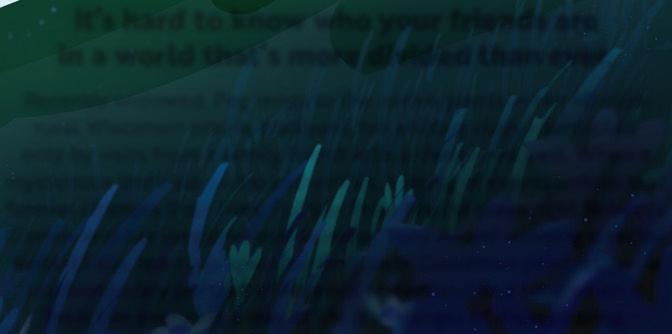


It’s something we wanted to tie into both Halloween and Day of the Dead, but also Thanksgiving. The play jumps through time, with Sam and Amado living in the years of the Trump administration, then going back to the 1960s and ’70s. As a cultural studies scholar, I know those moments are closer than we might want to acknowledge, part of an enduring and ongoing legacy of colonialism and white supremacy. We’re not just trying to cash in on these moments, but I believe that in October,
the veil between the worlds is thinner. What happens if we honor that?



Can you talk a bit about the other programming you’re building around the production of the play?


As part of the show, we’re having two nights of community storytelling events that provide an evening alternative for community members. There’s a lot of bars that have popped up in Pilsen in recent years, but they’re not always hospitable to the Brown people that have lived here. Being able to use this space to welcome people and to have a good time.
Latinos love to tell spooky fucking stories. You go to Mexico, you’re on the rancho sitting around a campfire, and someone will start telling you about how they saw the devil in the cornfield or some shit like that. We’re playing with that cultural tradition, inviting members of the cast and local Latino Chicagoans to share stories that deal with themes of haunting, ghosts, the supernatural. That’s broadly defined: someone’s telling a story about their bedroom that’s literally haunted, but someone else is talking about they’re haunted by the specter of transphobia. We’ll also be doing a youth institute, working with young people, teaching performance and playwriting.
The goal is to remind people of this omnipresent Mexican American population that’s often ghosted out of the historic record, even in the present. It’s important to have a process and a venue that reflects that history, one that sews that principle into everything. We’re telling people: We’re putting it on here, and you’re gonna remember that this is a community that fought. We are a people that have been fighting, so let’s reanimate that spirit. v
 BY REBECCA GILMAN
ROBERT
BY REBECCA GILMAN
ROBERT


in her 40-acre
her solitary days interrupted
by visits from a family friend with a checkered past. When a mysterious theft alerts the authorities, a string of events unfold that forever changes their lives. Pulitzer Prize finalist playwright Rebecca Gilman and her longtime collaborator, Tony Award-winning director Robert Falls, team up again for their sixth Goodman production—a contemporary portrait of America’s heartland in a time when it feels like everyone’s way of life is in danger of disappearing.
THROUGH
OCTOBER 13, 2022 - CHICAGO READER 33 THEATER GoodmanTheatre.org 312.443.3800 Groups 10+: Groups@GoodmanTheatre.org
DIRECTED BY
FALLS
Illustration by Carolina Lopez Corominas
It’s hard to know who your friends are in a world that’s more divided than ever. Recently widowed, Peg tends to the native plants
rural Wisconsin prairie backyard,
only
NOW
NOVEMBER 13 New Play AwardProduction Support THE ELIZABETH F. CHENEY FOUNDATION Principal Support
@t_annie_howard
Ricardo Gamboa
JOEL MAISONET
T iger Style!
Through 10/30 : Wed and Sat 3 and 7: 30 PM, Thu-Fri 7: 30 PM, Sun 2 and 6 PM; open captions Thu 10/20, Writers Theatre, 325 Tudor Ct., Glencoe, 847-242- 600, writerstheatre.org, $ 35 -$ 90
 REVIEW
REVIEW
Pecking themselves to death
Tiger Style! tries to overcome Asian stereotypes by leaning into them.
By IRENE HSIAO
Albert Chen (Christopher Thomas Pow) is sitting on a park bench eating what appears to be a burrito or a hot pocket when a hunched old man, dressed in an intersection of athleisure and preppie that signals respectability, comfort, and a baseline certainty of invisibility, shu es in. “Hey! You Chinese?” he hollers. Albert, though he is, in fact, Chinese—rather, third-generation Chinese American—mutters, “That doesn’t mean we’re like bonded.”
“This weird old man was . . . racially profiling me,” he tells white coworker Russ the Bus (Garrett Lutz), who proceeds to racially profile Albert as a diligent robot whose most interesting attribute might be where he’s from (“Uyghur from Kyrgyzstan . . . Tibetan raised by Nepalese monks . . . Vietnamese raised by wolves”), before demanding that Albert, once more, share the code that he worked on while Russ slacked. “I was raised to believe in sacrificing my individual needs for the sake of the group,” notes Albert. “So fine. I will give you my code. Again.”
Racial self-hatred is the subject of Mike Lew’s Tiger Style! in which Albert and his older sister Jennifer (Aurora Adachi-Winter), who are American-born, Harvard-educated, and live together in Irvine, California, blame their upbringing for their shortcomings, and their white (and whitewashed) colleagues are
only too happy to let them do it. Albert is a software engineer who can’t get a promotion from his Asian American boss (Rammel Chan, who also plays the aforementioned old man and Albert and Jennifer’s father), who finds Albert “unrelatable” compared to Russ, even if he does all the work. Jennifer is an oncologist who can’t get her deadbeat man-child white boyfriend (played by Lutz), whom she supports financially and who finds her exotic but neither domestically submissive nor sexually domineering enough, to marry her. Could traditional Chinese cultural values, such as humility, collectivity, and hard work, be to blame for their failure to find happiness in white American society? Albert and Jennifer are ready to believe.
“Racial self-hatred is seeing yourself the way the whites see you, which turns you into your own worst enemy,” wrote Cathy Park Hong in 2020’s Minor Feelings. “Your only defense is to be hard on yourself, which becomes compulsive, and therefore a comfort, to peck yourself to death.” This becomes the unspoken philosophy behind Albert and Jennifer’s so-called “Asian freedom tour,” wherein they attempt to go “full Western” by berating their parents, yelling at their bosses, goofing o at their jobs, and going to therapy. “Instigating a fight with our family sounds like a full and satisfying evening of entertainment,” says
Jennifer.
Unfortunately, it is not. The trouble with Tiger Style! (directed for Writers by Brian Balcom) is that it not only illustrates racial self-hatred and its roots in white supremacy, it performs such hatred upon its characters, who are cartoonish, unlikeable, and ultimately act the part of stooges to their own oppression. Albert and Jennifer embody stereotypes of the model minority and abhor themselves for it (“ . . . the Chinese American Ivy leaguer who went into medicine—you’re the vanilla ice cream of Asians,” scoffs Albert of Jennifer). Despite the reminder that their grandparents were laundry workers and farm laborers who struggled to raise their families from poverty to middle class under drastically more discriminatory conditions, they spend nearly the entire two hours aspiring for nothing better than to become the mediocre white men who dominate them.
When their academic and artistic achievements don’t bring them satisfaction in their lives, and straight imitation fails to transform them into full-fledged mainstream white Americans, they quit their jobs and book a one-way trip to Shenzhen to colonize the motherland like the deluded puppets they are. “How are you going to dominate China?” asks Albert. “I’m gonna ride a panda?” says Jennifer. “I’m gonna bungee jump the Great Wall!” China, in the form of the Communist Party and their self-sacrificing factory worker cousin Chen (Deanna Myers, who also plays their mother, a matchmaker, and a therapist, if that’s not too Freudian), rightly slaps the two upside the head but, in its depiction, is about the equivalent of Toyland in Pinocchio : parodically gratifying, then horrifying, in which a more mature parental figure who is herself imprisoned within the system sets them free to a freedom conditioned by the constraints of capitalist reality (but I digress).
In other words, Albert and Jennifer not only never transcend white expectations of them, they are those expectations played out like a minstrel show. Rather than o er a narrative that might reveal nuance, dimension, and humanity, Tiger Style! makes no gesture toward an interiority that might suggest that the siblings deserve something better than the life that has been foisted upon them by strict parenting and American culture. The best it can do is o er the briefest flashes of insight
as asides (“But what if we’re viewing China as tourists, and everything seems more exotic and vibrant than it actually is? Like in the same way others viewed us as exotic back home,” wonders Jennifer briefly, before succumbing again to a haze of cheap consumer goods and paternalistic government practices).
The satire of Tiger Style!, if it is one, might be too subtle for white audiences, and, as one of three Asians in the audience on October 8, it remains painful to hear others laugh when Albert and Jennifer get bullied by dumb white dudes and otherwise launch themselves into walls. Mr. Lew, as a writer from Irvine, California, with the wrong kind of “Dr.” in front of my name, whose achievements have brought me into the game as long as I remain quiet, hardworking, and dedicated to a position of servitude, I share your frustrations at the limitations of American society. But for whom or what is this play, which does not contradict the stereotypes it claims to challenge but rather affirms them? Tiger Style! certainly holds a mirror up to white American society, but as long as white people cannot see themselves in the faces of Asian folks, the message cannot be transmitted.
I give you back your own words:
Albert: “But the answer can’t be glacial generational progress. It can’t just be family endurance. At some point other people have to change and acknowledge our right to exist.”
Mom: “Yes but we can’t change the world, only you.”
@IreneCHsiao
34 CHICAGO READER - OCTOBER 13, 2022 ll THEATER
Aurora Adachi-Winter (le ) and Deanna Myers in Tiger Style! at Writers Theatre LIZ LAUREN
v
We Amplify Chicago Voices
Chicago’s local and independent media outlets tell the stories of our city. We keep our communities informed and connected.
Your donation will ensure the media outlets below can continue to produce investigative stories, highlight Chicago’s vast culture, and report local news that matters to you.
Together, Chicago’s local and independent media represent our communities’ voices: Black and Brown voices, immigrant voices, LGBTQ+ voices, workers’ voices, and more.

Join us to support news for Chicagoans by Chicagoans. Donate now at savechicagomedia.org.



Thanks to generous support from local foundations, your donations to individual outlets will be matched.


AirGo

The Beverly Review Block Club Chicago Borderless Magazine The Chicago Defender Chicago Music Guide Chicago Public Square Chicago Reader CHIRP Radio
Current Magazines The Daily Line E3 Radio Evanston Roundtable Gazette Chicago Gozamos


Growing Community Media Harvey World Herald Hyde Park Herald IL Latino News

Inside Publications Kartemquin Films La Raza Loop North News McKinley Park News N’Digo Newcity North Lawndale Community Newspaper Paseo Podcast Pigment International Polish Daily News



Rebellious Magazine for Women Rivet
Thanks to our partners in this campaign: Thank you to the following foundations for their support: MacArthur Foundation, Joyce Foundation, Joseph and Bessie Feinberg Foundation, Square One Foundation and Crossroads Fund.
CIMA’s 3rd Annual Fundraiser runs October 3rd - 17th
Soapbox Productions and Organizing South Side Weekly Street Level: Mildsauce.com Streetwise Third Coast Review TrueStar Foundation Windy City Times

OCTOBER 13, 2022 - CHICAGO READER 35
OPENING
R Survivor stories
Theatre Above the Law revisits the Grimm Brothers.
Theatre Above the Law returns to the fairy tales collected by Jacob and Wilhelm Grimm, as adapted again by Michael Dalberg. (Dalberg’s adaptation of The Strange Case of Dr. Jekyll and Mr. Hyde is also currently onstage with Idle Muse through October 23.) I saw last year’s outing, and this time the connective tissue in the mostly new round of stories selected by Dalberg (directed by Tony Lawry) seems stronger, more deeply rooted in the theme of loss—particularly sibling loss.
Jacob (James Hendley) is once again in a tavern occupied by characters in the fairy tales he and his dead brother gathered, in hot pursuit of the wolf (Ian Gonzalez-Muentener) he believes killed Wilhelm. “This place is for survivors,” Little Red (Gayatri Gadhvi) tells him. But of course all is not as it seems, and as the ensemble enacts more stories from the Grimm canon (including “The Seven Ravens,” in which a little sister must go to great lengths to save her seven brothers from a curse placed on them by their father), the role of fairy tales as conduits for understanding grief, loss, sacrifice, and redemption becomes more clear to Jacob, especially.
Not that it’s all heavy psychological stuff: Connar Brown as all seven of the aforementioned brothers and as the puppeteer for the Frog Prince delivers assured physical comedy, and Brooks Whitlock’s dry delivery as the wish-granting prince-fish in “The Fisherman and His Wife” remains as droll and on point as I remember from last year. Dalberg’s de adaptation, Lawry’s staging, and the ensemble combine for an entertaining family show that hearkens back to the work of Paul Sills and his Story Theatre. —KERRY REID GRIMM Through 10/30: Fri-Sat 7:30 PM, Sun 3 PM; also Mon 10/24 7:30 PM, Jarvis Square Theater, 1439 W. Jarvis, 773-655-7197, theatreatl.org, $15-$25
The Scottish play, abridged
Three Crows’s Macbeth cuts too much complexity from the tale.
Director Dusty Brown, who makes their Chicago directing debut with Three Crows Theatre’s storefront staging of Shakespeare’s Macbeth has trimmed the tragedy down to a fast-paced, intermissionless 105 minutes of blood-drenched storytelling. (“Macbeth has sword/dagger violence, onstage murder, and discussions of murder. Recommended for children 12+ due to all the murder happening onstage,” reads a content advisory on Three Crows’s website.) This intimate, economical production boasts spooky visual design by Kellian Keeler (set) and Piper Kirchhofer (lights), who together transform the intimate Redtwist Theatre space into a dungeon-like hellhole well suited to this classic tale of dark supernatural deeds. There’s even an onstage cistern filled with water, from which a macabre apparition or two may arise—or in which a guilt-maddened murderer or two may try, in vain, to wash the blood from their hands.
But Brown’s editing of the text lessens the moral impact of a drama grounded in Christian notions of free will. Having been promised by three prophetic witches that he will become king, Macbeth, a heroic military leader in 11th-century Scotland, caves in to his wife’s manipulative tactics and resorts to murder (including murder for hire), thereby sullying both his manhood and his immortal soul. By trimming seemingly repetitive arguments between the spouses—and rushing the final action as Macbeth approaches his duel to the death with arch-enemy Macduff—Brown turns Macbeth into a tale signifying, if not nothing, then at least less than it should. —ALBERT WILLIAMS MACBETH Through 10/30: Thu-Sat 7:30 PM, Sun 3 PM; also Mon 10/24 7:30 PM, Redtwist Theatre, 1044 W. Bryn Mawr, threecrowstheatre.com, pay what you can
Too many Marys Griffin’s drama about a Crimean War nurse is a
puzzlement.
Playwright Jackie Sibblies Drury had too many things in mind when she wrote this play about Mary Seacole, a real-life Jamaican-born healer who improbably served in the 19th-century Crimean War. Drury wanted to tell the story of this indomitable woman who wouldn’t take no for an answer, even from the equally implacable Florence Nightingale. She wanted to draw parallels between Seacole and modern-day healers, hence the title’s plural “Marys.” She also wanted to explore motherhood and the original meaning of the word “nurse,” comparing Seacole’s choice not to have children to those of the invented characters around her. Drury also wanted to explore the racism that shaped Seacole, including the self-hatred which caused her to emphasize the “good Scotch blood running through my veins” rather than her heritage of healing from her Jamaican mother.
Despite a powerhouse performance by Stephanie Mattos as Mary, there is simply too much going on here in Griffin’s production (directed by Jerrell L. Henderson and Hannah Todd) to form a coherent play. Further, the actresses’ frequent full-bore use of Jamaican dialect meant that much of the dialogue was lost to the ear of this middle-aged white lady, at least. And the final sequence, in which the cast members speak in unison about the fragility of the maternal body, would be very powerful if the play had clearly focused on that subject. Instead, Marys Seacole is a puzzlement, a series of missed opportunities to explore a range of interesting topics. —KELLY KLEIMAN MARYS SEACOLE Through 11/6: Thu-Sat 7:30 PM, Sun 3 PM, Raven Theatre, 6157 N. Clark, 773-338-2177, griffintheatre.com, $40 ($15 students, veterans, and active military)
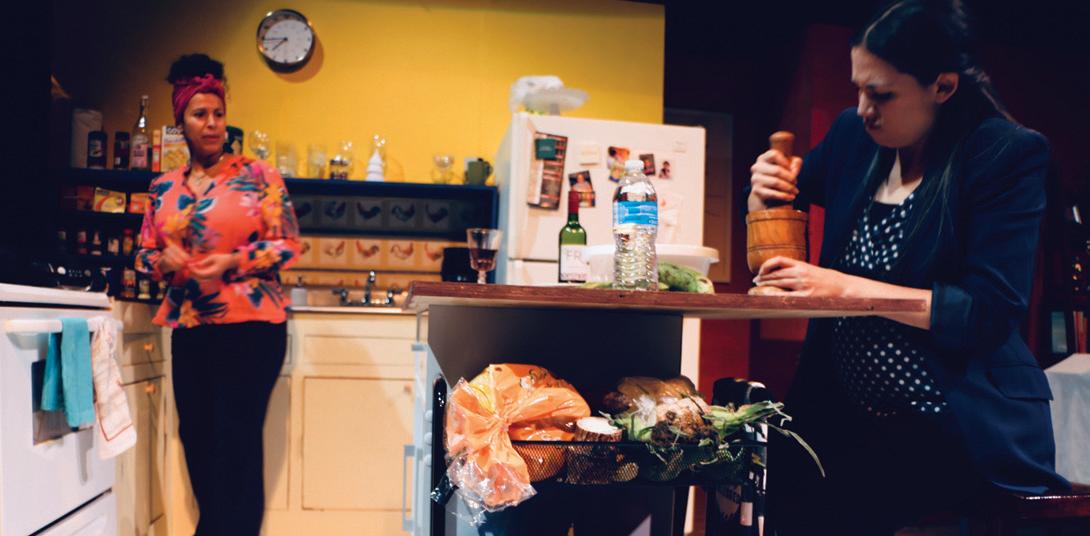
RUnraveling Chicago’s racist past (and present)
1919 at Steppenwolf for Young Adults is galvanizing and poetic.
J. Nicole Brooks’s adaptation of 1919, Eve L. Ewing’s collection of poems published a century a er the “Red Summer” race riot in Chicago sparked by the murder of Eugene Williams, is the first live show since the pandemic for Steppenwolf for Young Adults. There are only a handful of public performances, but it should not be missed.
In some ways, Brooks’s piece (codirected by Gabrielle Randle-Bent and Tasia A. Jones) works similarly to Aleshea Harris’s What to Send Up When It Goes Down (running through this weekend with Congo Square at Lookingglass Theatre). One of Ewing’s poems from 1919, “I saw Emmett Till this week at the grocery store,” is part of the Lookingglass lobby display, and it’s one of the last pieces in Brooks’s collage of poems, stories, history, ritual, and movement exploring the legacy of racism and segregation in Chicago and beyond—the very forces that led to Williams’s drowning death when the 17-yearold Black boy floated on a ra across an invisible line in the water on a south-side beach, and was stoned by a gang of white people on the shore.
There are also echoes of Brooks’s own earlier work. Sola Thompson’s scholar/writer who is attempting to give form to Williams’s story (and that of so many others murdered by white supremacy) feels like a more grown-up version of the eager young student in Brooks’s intergalactic Afrofuturist HeLa from 2018. Identified as Humans 1 through 6, the ensemble is far from generic. They function as muses for Thompson’s writer who dubs them “the griever,” “the caregiver,” etc.
It’s a kaleidoscopic piece that resists the tyranny of linear narrative. You may not learn every fact about the 1919 riots (that’s what history books are for). But you may find a deeper sorrow and knowledge seeping into your bones, thanks to the hypnotic pull of this piece. It’s geared for younger audiences who are being told daily that frank discussion of America’s racist history is too “divisive.” I hope more audiences can see it soon.
—KERRY REID 1919 Through 10/29: public performances Fri 10/14 7:30 PM, Sat 10/15-29 2:30 and 7:30 PM, Steppenwolf Ensemble Theater, 1650 N. Halsted, 312-335-1650, steppenwolf.org, $20
As teardrops fall
The Notebook at Chicago Shakes pushes familiar emotional buttons.
If you’re a fan of The Notebook—either the romantically waterlogged, sugary-sentimental 2004 movie or the Nicholas Sparks novel that prompted it—you’ll probably be swept away by the musical, directed by Michael Greif and Schele Williams and getting a pre-Broadway run at Chicago Shakespeare.
The love story between rich girl Allie and working-class Noah spans decades, tragedies, and obstacles in a Norman Rockwell world lit like a Thomas Kinkade painting.
Ingrid Michaelson’s score is packed with yearning, soaring money notes, and romantic lyrics. Bekah Brunstetter’s book highlights endless emotional highs (and lows) as it follows Allie from adolescence to memory care unit (Maryann Plunkett as Older Allie, Jordan Tyson as Younger Allie, and Joy Woods as Middle Allie) and
36 CHICAGO READER - OCTOBER 13, 2022 ll THEATER
Sancocho YAJAIRA CUSTODIO
THEATER








Noah (John Beasley, Ryan Vasquez, and John Cardoza, as Older, Middle, and Younger Noah, respectively) from young infatuation to Vietnam to assisted living facility.

The titular notebook refers to a diary Younger Allie kept, and which Older Noah reads back to Older Allie in hopes it will cut through the dementia that’s killing her “return” to him.


















It’s no coincidence that The Notebook has roughly the same vibe as This Is Us, the Emmy-winning NBC family drama Brunstetter wrote for years—highly emotional, multigenerational storylines of agony and ecstasy, love and loss.
The Notebook works hard to push every button required to open the tear ducts. There are long kisses in scenic summer rains. There are virgins having sex for the first time, rapturously and without fumble, backlit by glowing lights. It mostly succeeds. But in the end, The Notebook is escapist fare that’s as pleasant as cotton candy and about as substantial.
—CATEY SULLIVAN THE NOTEBOOK Through 10/30: Tue 7:30 PM, Wed 1 and 7:30 PM, Thu-Fri 7:30 PM, Sat 3 and 8 PM, Sun 2:30 PM, Chicago Shakespeare, 800 E. Grand, 312-5955600, chicagoshakes.com, $59-$125

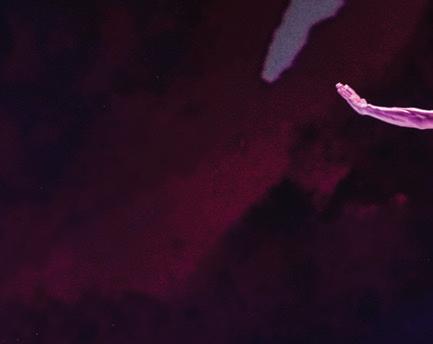



R Rich family fare










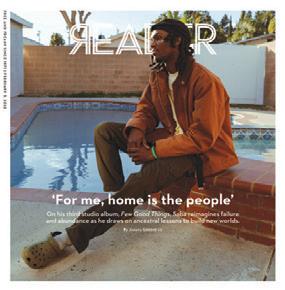


Sancocho is a heartwarming story of Puerto Rican sisters.


As someone whose older sisters are over a dozen years her senior, Sancocho Theatre Company as part of the fi h Destinos: Chicago



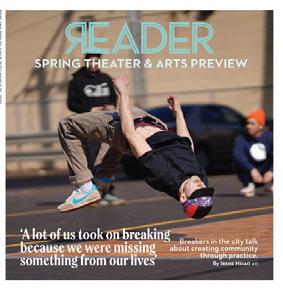
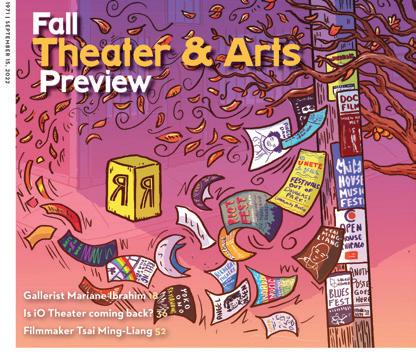





International Latino Theater Festival) spoke directly to mi alma. Named for a type of beef stew, this show highlights the significance of familia for the best or otherwise. Peppered throughout the show, the dialogue melds between English and Spanish sweetly as the sancocho literally simmers on the stove. (Truly do not come to this show hungry—you will regret it.) The scent made me long to return to Puerto Rico to devour más mofongo y tostones.
Sisters Caridad y Renata (Antonia Arcely and Amber Lee Ramos) are two decades apart in age—more mother/ daughter than hermana/hermana. They come together to discuss their papa’s will as he is close to death and they must confront their own familial demons in the process. Christin Eve Cato’s script (directed by Xavier Custodio) showcases the delicate nature de una familia, especially when age complicates our relationships with one another. It felt as if I was watching scenes from mi propio futuro unfold with one of my older sisters—ironic given the producing company is named “Visión.”
If you don’t speak Spanish, don’t worry/no te preocupes. You might miss a few jokes (though they are good ones) or comments, but you will understand. A two-hander set in a Puerto Rican household, where the actors are literally preparing food, should live in multilingualism. Frankly, it made the sancocho smell aun mejor. —AMANDA FINN SANCOCHO Through 10/30: Thu-Sat 7:30 PM, Sun 3 PM, no performance Thu 10/13, Windy City Playhouse, 3014 W. Irving Park, visionlatino.com, $30. Performed in English with some Spanish.
OCTOBER 13, 2022 - CHICAGO READER 37
Emani Drake,
photo
by Michelle Reid.
AuditoriumTheatre.org 312.341.2300 NOVEMBER 5 “fervor and raw power” — See Chicago Dance 2022–23 SEASON SPONSORS O cial Hotel Partner 2022–23 SERIES SPONSORS Florian Fund Global and Chicago Dance Chicago Dance Joyce Chelberg Pamela Crutchfield Patti Eylar and Charlie Gardner Providing arts coverage in Chicago since 1971. chicagoreader.com Cloud Gate Dance Theatre of Taiwan, photo by LEE Chia-yeh. AuditoriumTheatre.org 312.341.2300 Cloud Gate Dance Theatre of Taiwan ONE WEEKEND ONLY! | OCT 14 + 15 2022–23 SEASON SPONSORS O cial Hotel Partner 2022–23 SERIES SPONSOR Florian Fund Global and Chicago Dance CLOUD GATE Presenting Sponsor “Wholly Irresistible” — Dance News
FILM
Chicago’s history in movie ads
ADAM CARSTON’S WINDY CITY BALLYHOO
Twitter: @WCBallyoo Instagram: @windycityballyhoo Facebook: facebook.com/windycityballyhoo
By YOLANDA PERDOMO
In 2020, movie theaters were one of the first places to shutter, thanks to COVID19. Theaters everywhere closed, leaving everyone stuck streaming at home.
Albany Park resident Adam Carston went online and got his cinema fix by getting into a time machine of sorts: online newspaper archives. He (virtually) went to closed theaters (remember the State and Lake?) and peeked at grind house and X-rated o erings, playing day and night, through the paper’s movie ads.

“I don’t know if it’s like the repressed Catholicism thing or what, but titillation was really big money here in Chicago,” Carston says. “They all tell a story of what was going on.”
To keep track of his archive dives, he created Windy City Ballyhoo on Facebook, Instagram, and Twitter. It’s a repository of Chicago movie ads, photographs, and film reviews from the last century.
“I’ve always been fascinated about how art and media reflect where the culture was and where it is,” Carston says.
Growing up in Oak Forest, Carston was part of the VCR generation.
“People dropped the kids off at a baseball practice. My parents dropped me off at the video store. I’d literally be at the video store for an hour or two,” says Carston, an underage cinema missionary. “I often joke that I was raised by the Three Stooges because [my dad] had like dozens of Three Stooges tapes.”
He also took his growing obsession to school. “Like Taxi Driver, John Waters movies. I watched Blue Velvet in sixth grade and tried
to describe it to the kids in class.”
He later went to Loyola and got his bachelor’s and master’s degrees in history. Carston calls himself a “jack of all trades,” often hopping from project to project. His work on documentaries includes the recently released Live at Mister Kelly’s . Carston says it was while working on that film that his eyes began to wander.
“Right next to the nightclub ads were movie ads. Sometimes, I’d fall down a rabbit hole of wanting to look at those,” says Carston, giving him the idea for Windy City Ballyhoo in 2020.
The ads, some dating back to the 1920s, are illustrated with eye-catching images, daring the audience to experience something they’ve never seen before. At any given time, you’ll see pictures of trucks on fire, barreling off the road, almost jumping o the page. Others, from the 1930s, show illustrations of singers and mimeographed pictures of stars. It wasn’t just fun stuff people got to see in the ads.
One that’s about 100 years old has the words “BIRTH CONTROL” in bold, in the center of the page, and different showtimes for men and women—presumably to watch the movie separately and not get any immediate ideas. Some theaters had a DIY aesthetic, cutting and pasting images from press kits to make their own ads.
With countless movie ads from the 20th century, how does Carston decide what to post?
“I take clippings because there’s a major movie or some kind of historical significance. But quite honestly, I just look for a weird story.”
Chicago audiences got more than popcorn and a double feature in those days.
“During the Depression, a lot of theaters would give away silverware and plates,” Carston says. “It was all this ballyhoo to get people in.”
A “triangle” of theaters in the Loop always drew crowds: The Chicago Theatre, State-Lake Theatre (closed in 1984; ABC 7 now has that space), and the Loop Theater (closed in 1978, demolished in 2005).
“The Loop, this tiny, little theater, would, per capita, outgross both of them some years,” says Carston, adding that there was one reve-
38 CHICAGO READER - OCTOBER 13, 2022 ll
Adam Carston fl ips through old fi lm ads. YIJUN PAN FOR CHICAGO READER
NOW PL AYI NG ! NOW PL AYI NG !
One Chicagoan’s pandemic lockdown project turned into a time capsule of the city’s moviegoing past.
lation about a Chicago movie theater with an unusual reputation.
“The Woods Theatre was a great movie palace that went into the grind house fare and was really known for its sketchiness,” he says. “People commenting on social media saying that they used to work there, and that they would pre-pop all the popcorn and put it in the basements. And then they would find that rats had somehow burrowed their way through the plastic bag and had their way with the popcorn. And then they would still bring it up to serve people.”
Despite some dinginess, most moviegoing experiences in Chicago were fun events.
“In the 70s, the Congress switched over to a Spanish-language format, and stayed that way for several years. But that’s hardly an anomaly,” says Carston. “In Lincoln Square, the Davis Theater used to show German-language films. These theaters would service their communities.”
Another specialty for like-minded moviegoers was adults-only fare, advertised alongside mainstream movies.
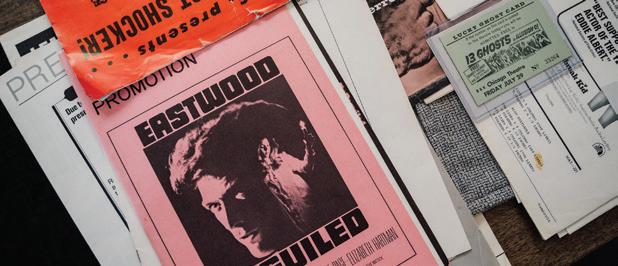
“Pornography was really big business, like hardcore, post- Deep Throat . Hardcore pornography took over mainstream theaters for several years. And we’re talking about a lot of
theaters,” Carston comments.
“Michael Todd Theatre and the Cinestage, which is just around the corner from the State and Lake theater—they routinely would play pornography, especially Cinestage became kind of a home for it,” he says, adding that lighter fare, like the Russ Meyer film Vixen! , drew a steady stream of moviegoers.
“It ran for at least a year and a half there and just was constantly selling out and became kind of this, like, sensation in Chicago. And then mind you, that wasn’t hardcore. That was softcore,” Carston notes.
If Carston’s movie theater time machine was actually operational today, he’d go to Chicago’s south side to places like the Regal Theatre.
“There was Cab Calloway opening for a W.C. Fields film. I’d be down for that in the 1930s,” Carston says.
One movie had a di erent kind of marketing campaign for south-side moviegoers.
“There was an Italian film that Roberto Rossellini made called Paisan, and it’s kind of an anthology film with a lot of di erent stories. And one of the stories is about an African American soldier in Italy after the war and his adventures with this kid,” Carston says.
“So when the ads for the south-side theaters
where it played came out, they made that guy (Dots Johnson) the star of the movie.”
Windy City Ballyhoo also led Carston to find a new film fanatic friend in a famed Hollywood screenwriter who zoned in on their mutual love for all things weird and wonderful in the world of cinema. Larry Karaszewski (Ed Wood, The People vs. Larry Flynt) grew up in South Bend, Indiana, in the 1970s, and he remembers following the Reader ’s Dave Kehr’s reviews religiously.
“The ads became a key part of the movie dream. Looking at the ads now brings back a Proustian memory invoking the essence of the past,” says Karaszewski. He can’t get enough of digital archives.
“I started collecting many old ads myself. Then I discovered Windy City Ballyhoo and found a kindred spirit,” says Karaszewski. “Here were people obsessed with the same goofy crap I was.”
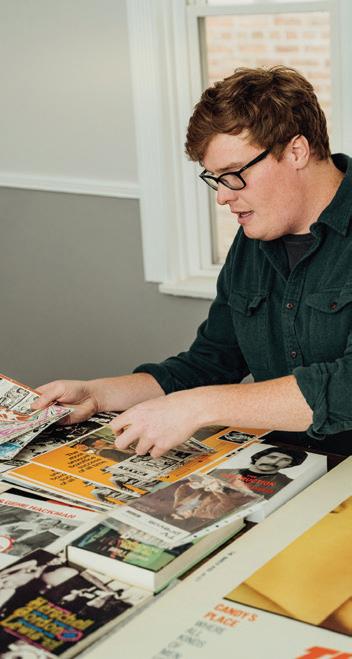


One movie (and Chicago event) Carston is trying to track down is Under Age , from the 1960s.
“About a Mexican boy or teenager accused of molesting or raping a girl. And there’s a whole trial about it. And supposedly the gimmick was they would have local celebrities on the jury for the film. Here in Chicago, Irv Kup-
cinet and some other columnists are on the jury and this was at the Loop Theater. I have photos of it. I have ads on it,” says Carston.
“They don’t specify if they prerecorded it or they just put their name on a pamphlet they handed out or yes, they’re on stage. It sounds like a really bizarre scenario.”
Windy City Ballyhoo isn’t just a time capsule of what people were watching; Carston says it presents city history. The film ads show a cultural shift, how times and attitudes have changed, how people weren’t really deterred by ratings or reviews. The ads did the job of social media today: they shout out what you want to see—and what you didn’t even know you wanted to see. They speak to you like they spoke to other Chicagoans who wanted to see a black-and-white image come to life on the big screen.
Carston notes, “I think you can learn a lot about American culture and film history by looking at the movie scene here in Chicago.” v
OCTOBER 13, 2022 - CHICAGO READER 39 FILM
@yolandanews
An assortment of items from Carston’s collection YIJUN PAN FOR CHICAGO READER
Carston’s archive fi nds are pieces of fi lm history, but they also document the history of Chicago.
YIJUN PAN FOR CHICAGO READER
LOCAL BAND @localbandthemovie
Indie rock, immortalized
By JONAH NINK
“Good set.”
It’s a saying you’ll hear bands pass along to each other after a gig, regardless of a set’s actual quality. To Chicago filmmaker Dan Stewart, the camaraderie between underdog musicians that the phrase represents often goes unsung.
“[Bands] have this language that we all understand. I wanted to utilize that. The humor and tragedy of being in a DIY band,” Stewart says.
Hollywood loves stories about musicians but tends to avoid the unglamorous bits. Fitting in practices around tight work schedules, paying hand over fist for a rehearsal space, and playing to no one are all integral to the experience of most underdog bands, yet they rarely make it onscreen.
Stewart aimed to give those moments their justice, and he brought together some of the Chicago indie scene’s favorite bands to help. The result is Local Band, a feature film about a

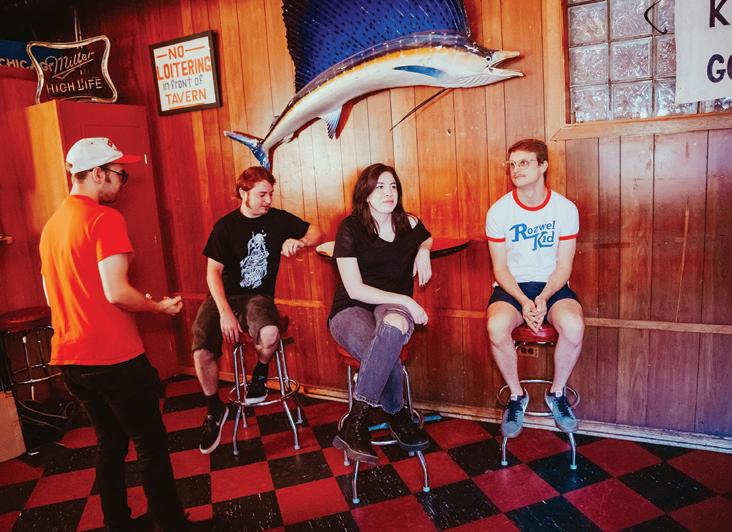
fictional band that, like their real-life Chicago counterparts, still give it their all despite feeling doomed to fall through the cracks.
“This project started way back at the end of 2018. I was living in Saint Louis, which is my hometown,” says Stewart. “I was starting to really get into the local music scene there.”
Stewart and Local Band cowriter Nick Wandersee would frequent underground metal shows together. The acts they saw varied wildly from conventional rock and metal bands to some truly niche o erings.
“There was a touring noise act where this guy wheeled out a folding table and there were VCRs involved, and it was the loudest wall of death and noise. The band was called Terminator 2.”
Though genres varied, the underground shows were consistent in the creative energy on display, and Stewart and Wandersee saw a story that wasn’t being told.
“I sat down in my basement with my friend Nick and we just ironed out this idea for a
movie about a band that is struggling. [It’s] a story about a band that doesn’t end up successful,” Stewart says.
Thinking back to Terminator 2 (the band), Stewart says, “This guy is clearly not doing this so that he can have the ‘Live Aid’ ending of the movie. This guy’s doing this because he loves what he’s making, and he loves performing.”
After years of tinkering with the concept and navigating film school, Stewart—who had uprooted to Chicago by that point—was ready to get the film o the ground. Funding for the film was secured primarily through an Indiegogo campaign that Stewart describes as “an emotional journey.”
“There was an incredible outpouring of support from the scene,” says Stewart. “They say a lot of funding comes from one person who wants to pick up your idea and give you a couple thousand dollars. Ultimately for us the average donation was 50 bucks, and that was just from very generous contributions from
people in the scene.”
Local Band’s production caught the Chicago indie scene in the middle of a small renaissance, with the end of pandemic lockdown energizing veteran and new artists alike. As Pinksqueeze’s Ava Marvin puts it, the time apart has brought Chicago’s indie bands closer together.
“I think that it’s just beautiful how much people show up for each other in this community and really go hard for each other’s shows, and just truly, genuinely support each other. So, it’s just been special,” Marvin says.
“That was something that kind of really didn’t happen a lot in the older scene,” says Isabella Martinez, who pulls double duty as the film’s lead and representation for Chicago alt-rockers Cut Your Losses. “It really does now feel like a little family. To see all the same people at each other’s shows.”
Along with Pinksqueeze, Local Band’s roster of bands includes scene regulars Superkick, OK Cool, CalicoLoco, and Nora Marks, with
40 CHICAGO READER - OCTOBER 13, 2022 ll FILM
Filmmaker Dan Stewart shooting Local Band VICKI HOLDA
MUSIC MOVIE
Local filmmaker Dan Stewart spent the summer shooting Local Band, a feature film dedicated to Chicago’s DIY music scene.
their contributions ranging from short clips of sets to full-on speaking roles, according to Stewart. Stewart himself lends guitar and vocals to punk trio Damager.
“[Adding] grit and weight, and to ground it a little bit in the real scene, he’s going to have this footage of other bands playing,” says Nora Marks’s Michael Garrity. “That was our primary role; he filmed one of our concerts.”
“To bring us all a little out of our comfort zones to be actors and musicians was a beautiful feeling. Especially the last day of the shoot when we were all at Double Door. It was bittersweet, but we all knew we would see each other again. But who knows when we’ll all be able to collectively be a part of something like this film again,” says Superkick’s Mike Vaughn.
Local Band producer Jake Rotger says that the crew initially anticipated that working within the schedules of nearly ten different bands would be herculean on its own.
“And that’s on top of the fake band we put together with the actors,” Rotger says. “We went into this project thinking that [scheduling] was going to be a total obstacle to get around. I thought it’d be a constant pain in the ass. But it wasn’t. Everyone was very good about just being there when they needed to be.”
“Even the bands that are just in one scene, like CalicoLoco, who just play a few songs,” Rotger explains, “they came in, played three great songs, and were awesome.”
Local Band was shot over August and July of this year. Scenes were filmed in some of the same practice spaces and venues used by
bands across the city, all “without a tripod in sight,” Stewart says. The use of real locations and bands was meant to give the film an unmistakable sense of place within Chicago. Even the behind-the-scenes photos were taken by photographer Vicki Holda, a staple at many shows.
“It’s our scene, and yeah, they’re drinking Old Style and talking about Beat Kitchen in the dialogue, or Double Door. These are things that we understand as people in Chicago. I think that sometimes, being very specific can be the most universal thing,” Stewart says.
But as OK Cool’s Bridget Stiebris rightfully points out, Local Band’s full roster still only captures a small portion of Chicago’s musical talent pool.


“[The film] is definitely not comprehensive; there’s so much music in this town. It’s insane,” Stiebris says.

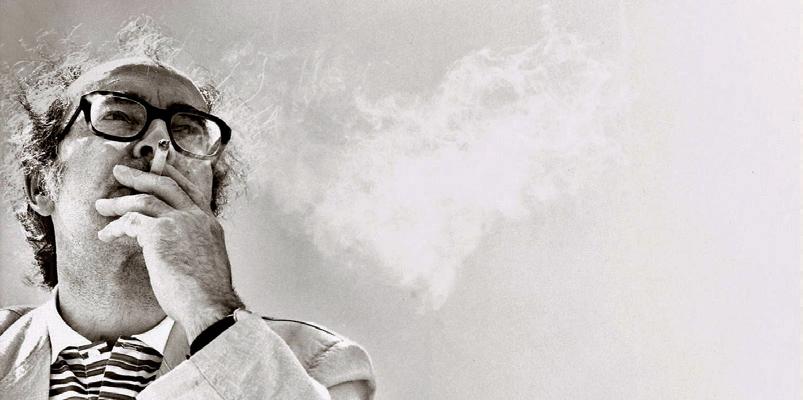
Local Band is currently in postproduction, with Stewart aiming to enter the festival circuit afterward.


“I have maybe an incredible opportunity to, in the tradition of something like The Decline of Western Civilization, document something really magical and cool right now,” says Stewart. “I think maybe it’s the optimism of a postCOVID lockdown world where we’re fulfilling our angst to get back into crowds and make things.
“I want the world to see these people and hear their music and love it like I do.” v
@NinkUic
OCTOBER 13, 2022 - CHICAGO READER 41 FILM
BREATHLESS•BANDOFOUTSIDERS•PIERROTLEFOU AUREVOIR, GODARD OCT14-20•ONEWEEKONLY SISKELFILMCENTER.ORG /AU-REVOIR-GODARD
Cast and crew of the fi lm in Chicago VICKI HOLDA
Friendships and horror flicks
Is Scream groundbreaking or overrated? That Horrorcast documents a relationship built on questions like this.
By DMITRY SAMAROV
Do you like scary movies?
Mallory Smart does. Growing up the youngest in a family of five kids, Mallory remembers being exposed to horror movies by her older siblings very early in life. This was the 1990s, the heyday of slasher flicks. Holdovers from the 70s and 80s like Halloween, Nightmare on Elm Street, and Friday the 13th were all into third or fourth sequels, but the big star of the era was Scream . With its tongue-in-cheek, selfaware tone and endless references to genre movies that came before, it set the template for meme culture long before most homes even had a dial-up connection to the Internet.
For Mallory and her sisters and brothers, playing practical jokes and making prank calls was how they related to one another. It’s no wonder Scream is her all-time favorite.

I was a guest on another podcast she hosted in early 2021, and Mallory and I kept talking after. Eventually she mentioned the idea of starting a horror movie podcast, and on June 17, 2021, That Horrorcast debuted with a nearly two-hour talk about Stanley Kubrick’s The Shining.
I remember taking my brother Boris to see Jacques Tourneur’s Night of the Demon at the Coolidge Corner Theatre in Brookline, Massachusetts, in the early 80s. He had nightmares for days afterward, but I don’t recall being scared. I’ve loved movies all my life. I wound up working at that same theater in high school, dating a filmmaker through art school, and now make a part of my living reviewing film. But I’d drifted away from the horror genre
before making friends with Mallory. I was surprised she asked me to cohost her podcast, not only because I’m not a genre obsessive like her, but also because of our age di erence.
When Scream came out in 1996, I was 26. I found its jokey violence mostly derivative and annoying, but most of all, inconsequential and unimportant. The stakes seemed so low. It’s just a way to ri on other movies without any resonance to lived experience. David Lynch’s Lost Highway, which came out the following year, sticks in my mind as much more impactful and reflective of that era, but to Mallory, Scream is a major touchstone. She would have been six when it debuted but likely first watched it via home video a year or two later. That generational gap is one of the cruxes of our show.
As the true fan, Mallory chooses classics like Nightmare on Elm Street , The Exorcist , and The Omen, whereas I try to go less mainstream with titles like Larry Fessenden’s grubby is-he-or-isn’t-he-a-vampire flick Habit (1995) and Andrzej Żuławski’s overwrought relationship-horror masterpiece Possession
(1981). It’s fun to stump Mallory with movies she’s never heard of. But revisiting The Thing or It Follows is a chance to reconsider movies I thought I already knew and had set opinions on through fresh eyes. Hearing Mallory’s take is often illuminating and makes me rethink my own assumptions.
There are plenty of film podcasts out there that focus exclusively on the plot or style. Neither Mallory nor I are aspiring filmmakers or film historians; we’re just two friends talking. As I’ve said, I’m not specifically a horror-movie bu , but I find the genre rich soil for conversation. No matter how fantastic or violent, the premises of these films are always real-life fears and societal ills. They are invariably reflective of the times they were made. A great instance is the four very di erent versions of Invasion of the Body Snatchers ; while each is basically the same story, the stakes and circumstances in each are firmly rooted in the 50s, 70s, 90s, and 00s, respectively.
The joy of the show to me is the unpredictability of Mallory’s reactions to the movies I choose. I was sure she would love Jane
Schoenbrun’s 2021 Internet-set nightmare
We’re All Going to the World’s Fair , but she was completely unimpressed. By contrast, Jeff Lieberman’s 70s drug-scare oddity Blue Sunshine drew raves.
It’s also occurred to me that the vast majority of conversations between Mallory and I have been recorded. We’ve only known one another a couple years and don’t live near enough to meet face-to-face that often. Add COVID-era restrictions and a mutual allergy to phone calls and what you get is a whole friendship documented via podcast.
We don’t know how long we’ll keep the thing going. This is neither a commercial enterprise nor a means to some definable end. We’ll keep posting episodes as long as the conversations are engaging and we’re not sick of one another. There are even tentative plans to go see the next (is it the sixth? eighth?) iteration of Scream when it comes out next year. If that’s not a definition of true friendship, I don’t know what is. v
@Chicago_Reader
42 CHICAGO READER - OCTOBER 13, 2022 ll FILM
PODCAST
Scream (1996) DIMENSION FILMS/ALAMY VIA NEW YORK TIMES
THAT HORRORCAST thathorrorcast.com
Argo Sssssss remains one of the strangest, most uncategorizable B movies of the early 70s. The joys of watching it are immediate and undeniable, as we bear witness to Dirk Benedict of The A-Team fame as he molts his skin, turns green, falls in love, and is attacked by a mongoose, all while trying to wrest control of his humanity from his mad scientist boss.
public from seeing a guy with a snake for an arm puke up a lot of smaller snakes at once— it more than makes up for with ever-escalating shock value and an abundance of unhinged gore by Japanese special effects legend
Screaming Mad George.
A love letter to ‘snakies’
By JOEY SHAPIRO
It’s often said that love finds you only when you’re not looking for it. This has been my experience with movies about giant snakes, mutant snakes, unholy hybrids of snake and man, and, in one case, a man with a snake for an arm. Why did it have to be snakes? I don’t have especially strong feelings about them, and yet in the last few years I’ve accidentally become an expert on the deranged world of snakesploitation horror cinema. Though they may not earn themselves a spot in the Library of Congress (yet . . .), these magnetically strange B movies have slithered their way into the annals of my heart. As Halloween fast approaches, and with the Criterion Channel now streaming Ken Russell’s more mainstream but cartoonishly
horny The Lair of the White Worm as part of their 80s horror collection, there’s no better time to dive into the genre.
In many ways the original snakesploitation story is that of Adam and Eve. For the sake of brevity, though, we can fast-forward to the next most important one: 1973’s Sssssss , about lab assistant David who naively trusts his snake scientist employer, Dr. Stoner, not to inject him with an experimental serum that will turn him into a snake-man. With numerous actual king cobras lunging at its cast onscreen and Animorphs-adjacent special effects by John Chambers—the man behind the beloved ape suits in Planet of the Apes who was also inexplicably one of the masterminds of the real-life hostage rescue that inspired
Widely considered to be the Michael Jordan of movies about humongous killer snakes, Oliver Reed starred in not one but two snake motion pictures (popularly known as “snakies”) in the early 80s: Venom in 1981 and Spasms in 1983. The former paired him with Klaus Kinski—famed for his Werner Herzog collaborations and for looking like a leather Muppet brought to life by an evil wizard—for a ri on Dog Day Afternoon. The twist, as you may have guessed, is that it’s Dog Day Afternoon with a black mamba snake on the loose amidst Reed and Kinski’s hostages. It’s about as ridiculous as it sounds and has murder-bysnake in abundance, but doesn’t hold a candle to Oliver’s even more unhinged Spasms , in which he plays a reclusive millionaire paying big money to track down the monster serpent whose bite imbued him with extrasensory perception. Peter Fonda costars as a medium hired to facilitate a psychic connection between Reed and the snake, with the one kink in their plans being a satanic snake cult that wants the serpent for themselves. Neither film is essential per se, but both contain fleeting glimpses of what Alfred Hitchcock would call “pure cinema,” by which I mean people get bit real good by giant super-snakes and, in some cases, explode.

Even in their more outré moments, all of these films fall under the more conventional side of snakesploitation, the kind of movies just tasteful enough to air on TCM on a day when Ted Turner is out of the o ce. There is, however, a weirder, sleazier side of the micro-genre, and here is where Curse II: The Bite comes into play. Call it advanced snakesploitation. A himbo on a road trip with his girlfriend takes a shortcut through a former nuclear test site in the desert, is bitten by one of the many mutant rattlesnakes who call the region home, and soon finds his arm turning into a killer snake with a mind of its own. What it lacks in “suspense” or “pacing”—bourgeois standards of quality invented by The Man to keep the
The true hidden gem of snakesploitation cinema though, and the one that achieves the perfect synthesis of studio polish and hysterical trashiness, is 1978’s supercharged Carrie rip-o Jennifer. Everything lurid about Brian De Palma’s film is taken into maximum overdrive here: the bullies are no longer high school evil but attempted-murder evil, the unstable Christian parent is somehow even more unstable and Christian, and the eponymous teen has the power to conjure and mind-control snakes the size of Buicks. It’s a perfect storm of melodrama and exploitation cranked up to 11 as Jennifer’s sex-crazed, bloodthirsty teen rivals repeatedly try to o her for being, in their words, a “hillbilly bitch.” Not only a treat for the snake-loving freaks among us, but a veritable all-you-can-eat bu et of slickly produced garbage.
There is of course an elephant (snake) in the room (plane) when discussing snake cinema. Snakes on a Plane (2006) is snakesploitation gone corporate, snakesploitation selling out on its major-label debut. Needless to say, it holds no respect from me, a leading scholar on herpetological cinema. Directed by the man behind the only two bad Final Destination movies (the second and fourth, for the record), it feels explicitly made to earn back its budget in syndication on Spike TV. There’s plenty of computer-generated snakes biting genitals, but it’s all broad strokes with no passion or thought put into those crotch bites, a product being sold to us by cynical snake-hating Hollywood suits rather than something genuinely weird and interesting. One needs only to look at the Snakes on a Plane climax, in which Samuel L. Jackson easily ejects the snakes from his aircraft by shooting open a plane window.
Where is the spectacle, where is the joy? Compare this to the climactic moment of Spasms when a 20-foot-long Micronesian serpent attempts to blow up Oliver Reed with psychokinetic explosions, they engage in a man-on-snake knife fight, then licensed medium Peter Fonda steps in to shoot the snake in the mouth many, many times with an assault rifle. Therein lies the radical, man-dominating-nature catharsis we yearn for, and often find, in the humble snakesploitation film. v
@nicejewishboy69
OCTOBER 13, 2022 - CHICAGO READER 43 FILM
Sssssss (1973) MUBI
GENRE
The horror microgenre of snake-centered B movies—or, snakesploitation cinema—is a serendipitous passion of mine.
PRIDE FILM FESTIVAL
Streaming Oct 26 -Dec 11
One-week general admission $10, festival passes $ 50, student and senior discounts available pridefilm.org
FESTIVAL
Black queer love, trans Iranian justice, asexual visibility, and more
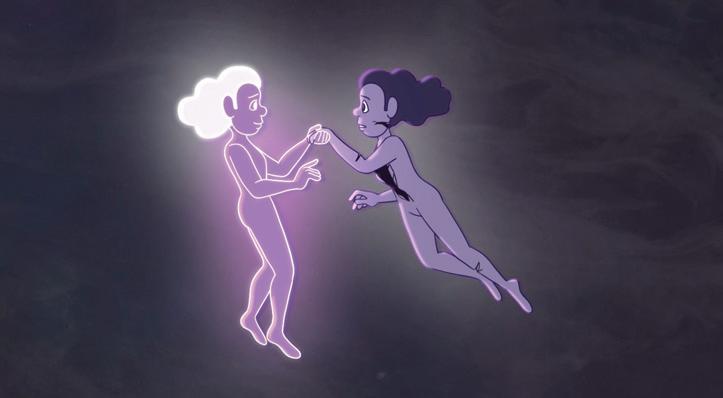
The new Pride Film Festival promises six weeks of groundbreaking LGBTQ+ content.
By WANJIKU KAIRU
The first Pride Film Festival features international LGBTQ+ films to stream October 26 through December 11. The festival recently separated from PrideArts, previously known as Pride Films and Plays, where it began in 2012. Pride Film Fest showcases LGBTQ+ shorts and features a diverse mix of riveting stories told across the LGBTQ+ spectrum.
Black Rainbow Love
Written, directed, and produced by Angela Harvey
Black Rainbow Love shines a brilliant light on the Black LGBTQ+ community. The documentary features beautiful stories of love, whether it be with friends, lovers, the community, and more. Harvey, who is a motivational speaker, social worker, and counselor, speaks with many people who she personally knows from her beloved LGBTQ+ community; she even
o ciated four of the couples’ weddings.
“I teach grown folks how to grow up. One of my clients made up the word ‘growth-ologist’ and it truly describes me best. My name is now synonymous with ‘grow,’” Harvey says.
This is only her first go-around as a documentary filmmaker, and the film has already received several awards. Harvey was motivated to create the documentary while watching a program on TV that featured people talking about relationships. Noticing a lack of representation, Harvey set out to tell the stories of the Black LGBTQ+ community.
“The stories are absolutely making an impact on all of those who see it. I’m blown away but also honored that I was the person to bring forth these amazing stories.”
Ultimately, Harvey will produce Black Rainbow Love as a docuseries.
Panah
Distributed by Helia Behrooz, directed by
Fatemeh Ghadirinezhadian, written by Masoumeh Bayat
Amid protests sparked by the death of 22-year-old Mahsa Amini while in police custody, the unrest in Iran continues to fuel anger against a corrupt and autocratic government. Because many Iranians are not allowed to use cell phones, U.S.-based Behrooz spoke with the Reader to share the story behind Panah, a film centered around a middle-aged transgender man who has a heartbreaking meeting with his son before attempting gender reassignment surgery in another country.
The Iranian government only recognizes two genders, male and female. This includes trans people, but means that many trans Iranians have been forced into gender reassignment surgery. Despite the government recognition, the trans community is still not socially or culturally acknowledged in Iran, and other queer identities like being gay or bisexual are punishable by death.
“I haven’t spoken to my people in Iran for 18 days,” Behrooz says. “I speak on behalf of the filmmakers who come from a family of producers. In Iran the government doesn’t allow independent productions, and makes them hard to operate, so it is di cult to make these movies. The other day we were protesting in front of the CBS o ce in LA because they haven’t been giving us any coverage, and it’s crazy because we just had a huge protest; over half a million people were there. Because of what is happening in Ukraine and in Florida with Hurricane Ian, we aren’t getting any coverage. It’s important for us to bring it up any opportunity we get. This movement is led by young women near 25 years old, and gender equality and inclusivity is a part of all of this. The rights of every single citizen is denied by the government. So just imagine how much pressure our LGBTQ+ community faces.”
The Iranian government has made many attempts at silencing activists. Currently two LGBTQ+ activists, Zahra Seddiqi Hamedani (known as Sareh), 31, and Elham Choubdar, 24, have been sentenced to death due to being guilty of “spreading corruption on Earth.”
Behrooz continues, “When the Iranian government wants to execute someone, they do it overnight. We have to make sure their voices are heard internationally, so they feel pressure not to do so. I want to tell people in
the Iranian LGBTQ community they are all my dear friends. We are all in this together. This is a fight for human rights, and they can count on us. ‘Panah’ is a name, but it also means refuge, shelter, or safe. Metaphorically, the director may have had something in mind.”
Cut Short
Written and directed by Charlie Andelman
A young nonbinary person must face a di cult truth about their father’s mortality while giving him a haircut after cancer treatment. Andelman based this short film around the memories of their dad when he was going through treatment, and how his hair finally grew back, di erent from how it used to be.
“At the time I had the chance to make this, you know, people talk about what they want their audience to feel,” Andelman says. “It’s a very intense thing to lay bare all of someone’s grief on the screen, let alone an entire theater and festival. It was entirely for myself, as it became the only way I could see myself processing my grief. I’m not a hairstylist. I cut his hair that one time. It was a nice bonding experience and a solemn one. It was the moment I accepted that this was going to end soon.”
During production Andelman experienced lots of ups and downs due to the personal and emotional attachment to Cut Short. They developed their own health issues over the past couple of years, and through the tough times their community came together to help make this film.
“It was amazing not only having trans representation on the set but being able to learn with each other and support each other and be there. It was really wonderful.”
Prior to Andelman releasing the film, their family didn’t talk much about their father’s death. Andelman’s father had been the glue of the family, and since the film’s release, Andelman’s family became more able to talk about him and the impact he had in their lives.
“I can hear him in my head,” Andelman says. “He would be so excited and proud. I was the apple of his eye, anything I completed or put out in the world, he was so happy to see it and experience it with me. This project is one that I wish I could share with him. It’s a complicated feeling to deal with, but I know that he would have been happy to see me work through my emotions like this.”
Inside the Beauty Bubble
Directed by Cheryl Bookout and Cheri Gaulke
44 CHICAGO READER - OCTOBER 13, 2022 ll FILM
Embrace LATESHA MERKEL / COURTESY JOHN OLSON
Set in artistic desert haven Joshua Tree, the Beauty Bubble Salon and Museum boasts an impressive collection of more than 3,000 vintage hairstyling artifacts. When owner Je Hafler was young, he dreamed of being an archaeologist. When he grew up and joined beauty school, he began collecting hair and beauty artifacts. Known as America’s Hairstorian, Hafler is just as delightful to watch as every piece of his collection. The documentary captures Hafler’s family pre- and mid-pandemic.
According to Bookout, “When [Hafler] moved his business from Wonder Valley to Joshua Tree, he came with his collection of vintage beauty artifacts. He created this wonderful roadside attraction and it’s actually a working salon. You can go there to get your hair done within all these artifacts. When he moved in I met him and had a life-changing haircut. He told me his story, that of his husband and his teenage son. I left his salon and called my filmmaking partner, Cheri Gaulke, excited that I thought we had the subject for our next documentary film.”
Gaulke adds, “Je is very entertaining, and a funny guy. He works the word hair into almost every sentence. He says things like, ‘That’s hair-sterical,’ or ‘The rest is hair-story.’ He’s full of hair jokes and puns. The tourists love him.”
Busia’s Babushkas Directed by Dan Pal
A heartwarming memoir about a grandmother’s babushkas and the connection her grandson had to them, Busia’s Babushkas helps director Dan Pal explore why he is obsessed with long hair while also honoring his grandmother. After Pal’s mother passed away two years ago, he inherited all of her home movies and photos. Throughout his childhood, Pal’s mother would always take pictures and film her family. Pal originally used his mother’s footage to make a feature documentary about her, Harriet & Her Husbands. When Pal decided to honor his Polish busia (grandmother), he used footage of her babushkas (scarves). As a child Pal often wore her babushkas and pretended to be someone with long hair, often imagining a connection to celebrities like Cher or Barbra Streisand.
“It was my way of connecting with celebrities, and as I thought about it I noticed maybe that was my own inspiration for wanting to grow my hair out,” Pal says. “I realized there had to be a connection to all of that. My grandmother and my obsession with long hair
and celebrities. My hair is like a little past my shoulders; it’s not long but it’s not short.”
Busia was well known for her compassionate personality, and for her love of her family, especially her grandchildren.
“She always accepted us and loved us deeply.”
Pal’s busia passed away before he got into filmmaking and teaching, but he has no doubt that she would have been very supportive of the film, and probably would have laughed along with it.
“I still have so much footage, and wanted to do something with that. I thought this is a great way to tell part of my own story and also honor her. If Busia were here, I would say we really miss you, and we wish that you were here to be a part of our lives.”
Embrace Directed by Latesha Merkel
This beautiful animated short is a film about asexuality and explores the common experience faced by those who identify as ace. Asexuality is an orientation defined by a lack of sexual attraction or desire regardless of gender. Of course there is a wide spectrum, but this particular film shares the story of a person who tries to date but does not feel comfortable connecting to a partner with physical intimacy—similar to Merkel herself, when she started college. Having seen no real representation of asexuality onscreen or otherwise, Merkel was inspired to share her experience.
“When I was around 17 or 18 I noticed a disconnect from my peers,” Merkel says. “I questioned why it was so hard to engage sexually. I wondered how it would affect my dating life and tried to figure out romantic relationships. I casually stumbled upon the term asexuality online, and that was the moment when it clicked, the moment it made sense. It felt relieving to know there was a word to explain why I felt so di erent and isolated in this specific case.”
“The most important people in my life have been very accepting. Some are curious, and I made a whole film about it, so I am open to discussing it. My own experiences and the ones I talked about in the film are very specific to each person. Asexuality is a spectrum. Some aces are OK with sex on some level, some aces want children and some don’t. It varies from person to person and this is my own take on it.”
@HolyBarbie
Find new film reviews every week at chicagoreader.com/movies
Till LYNSEY WEATHERSPOON / ORION PICTURES
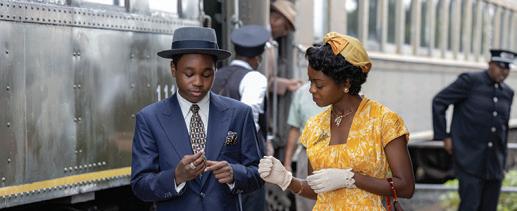
NOW PLAYING
RDecision to Leave
Decision to Leave abandons the brutality of Park Chan-wook’s signature style in favor of a restrained ruthlessness that, in the end, cuts deeper than pure violence. Hae-jun, a Busan detective played by Park Hae-il, is assigned to a peculiar crime scene––an experienced rock climber has plummeted to his death. During the first 30 minutes of the film, Decision to Leave offers the foundation or modus operandi of a conventional detective thriller, but then we meet Seo-rae, the unbothered widow of the fallen man played by Tang Wei. Suddenly, the conventional mystery plots are blurred by a familiar fog: a crush.
Hae-jun immediately suspects foul play, with his eyes closely affixed on the mysterious widow. Despite Hae-jun’s keen sensibilities, fervent perfectionism, and eager professionalism, the detective’s intuitions fall aside as he loses his head over Seo-rae. Decision to Leave disrupts the trajectory of the detective thriller by casting aside the murder for an even more intoxicating premise: a forbidden love story. Distanced from his cold marriage and troubled by insomnia, Hae-jun’s judgments are consumed by a delirium mirroring this unsuspecting true romance.
Decision to Leave is a subtle masterpiece from Park, braiding a heart-stirring tenderness into a murderous thriller. There is no logical reason to feel enticed by Haejun and Seo-rae’s romance, but there is undeniable and magnetic chemistry. Unbefitting of the crime, Park solicits our support. Hae-jun’s wife, played by Jung Yi-seo, claims he needs “violence and death to be happy.” He finds it, but the love he finds is vanishing, making for a finale that will leave you gutted. —MAXWELL RABB 138 min. Limited release in theaters
R Hocus Pocus 2
While 1993’s Hocus Pocus was neither a critical nor financial smash hit upon its release, every subsequent Halloween has enhanced its reputation, so much so that clamors for a sequel have grown and grown. Twenty-nine years a er the original, audiences have finally got their wish with Hocus Pocus 2, which sees Bette Midler, Sarah Jessica Parker, and Kathy Najimy reunite as the Sanderson sisters once again. This time around, the three witches are accidentally resurrected
by high school students Becca (Whitney Peak) and Izzy (Belissa Escobedo). They then have to stop the trio from killing Mayor Traske (Tony Hale), the father of their estranged best friend Cassie (Lilia Buckingham), the direct descendant of the reverend who banished the Sandersons from Salem back in 1653.
The opening 30 minutes of Hocus Pocus 2 are a slog to get through. Despite the presence of Hale (Arrested Development), Sam Richardson (Veep), and Hannah Waddingham (Ted Lasso), the comedy is trite, the teenage actors are dull, and the attempted plot is needlessly convoluted. Worst of all, though, Midler, Parker, and Najimy are completely absent. However, as soon as the trio turn up, Hocus Pocus 2 immediately becomes compelling and enjoyable. Midler in particular is utterly magnetic, but all three bounce off each other with such glee, and inject so much fun and nostalgia into the proceedings, that all of the film’s obvious flaws immediately feel trivial. —GREGORY WAKEMAN PG, 103 min. Disney+
Till
Directed by Chinonye Chukwu and utilizing extensive research from filmmaker Keith Beauchamp, whose work led to the reopening of the Till case in 2004, Till is based on the life of Mamie Till-Mobley (Danielle Deadwyler) and her struggle for justice in the 1955 lynching of her 14-year-old son Emmett Till (Jalyn Hall).
Till’s cinematography and editing are lyrical at times, utilizing a lingering frame to highlight the pain and pathos of the events. Deadwyler’s performance is masterful, requiring a complete range of emotional depth. Where the film struggles is in the attempt to tiptoe the line between inspirational story without veering into trauma fetish, with the multiple scenes of wailing Black people straying too far over the line. This is of course a story of trauma, but the tone of the film fails to successfully pivot between an upli ing narrative that it feels the film wants to portray. Sadly, that narrative simply isn’t there in the framework of the film and perhaps that message would’ve been better served with more time spent on the activism and advocacy of Mamie Till-Mobley in the years following Emmett’s lynching.
Ultimately and unfortunately, Till is a film that covers important events, but doesn’t quite feel like it adds enough to the story to be an important film. —ADAM MULLINS-KHATIB PG-13, 130 min. Limited release in theaters, followed by wide release v
OCTOBER 13, 2022 - CHICAGO READER 45 FILM
R READER RECOMMENDED b ALL AGES N NEW F
v
M50, FRAIL808, ALEJANDRO MARENCO Admission is cash only at the door. Fri 10/14, 9 PM, Podlasie Club, 2918 N. Central Park, $10, 21+

Will lightning strike Podlasie Club twice?


Last year a new dance party turned this sleepy Polish bar into a hot spot—and prompted a gut rehab of the space. Now that Podlasie is open again, will it recapture that magic?
By MICCO CAPORALE
By all accounts, the debut of Podlasie Club’s namesake party, Podlasie Pleasure Club, was insane. It was a muggy night in July 2021, and organizers were expecting a turnout of maybe 50. Podlasie hadn’t hosted an event in almost a decade, and it was only zoned to accommodate 104. So when the club got so full that the sidewalk along Central Park was thronged by people with high-water pants, shaved heads, harnesses, and ice-dyed tees, everyone was stunned.




Bar manager Violetta Konopka was relieved she’d had the foresight to ask her younger brother Vitek Pluta for help. But even with a second set of hands, the veteran drink slinger struggled to meet the demand. She and Vitek broke out Solo cups to keep up with orders and eventually accepted help from three party guests. At one point, the power briefly failed, and by the end of the night, the bar was out of ice and vodka. Its beer supply had been drunk nearly dry.
As stressful as the evening was for Podlasie’s staff, though, it was also really fun, even for them. Violetta and Vitek both recount the night flying by, carried by the energizing

music and dozens of conversations with friendly, interesting patrons they’d never seen before. Pleasure Club’s organizers helped with cleanup too.
The bar also sorely needed the money the party brought in. For years, Podlasie had been operating as a neighborhood watering hole for a dwindling supply of weekday regulars, and it’d barely survived the first 15 months of the pandemic. The first Pleasure Club had hit the bar like a flash flood in Death Valley, and Violetta felt like all she’d had to do was let it happen. Its success attracted a slate of party planners eager to throw their own music nights at Podlasie, and to Violetta it seemed like a no-brainer to steer the club in that new direction.
By fall 2021, Podlasie was the buzziest dance spot in the city. In less than six months, it had become a pocket universe for twentyand thirtysomethings eager to purge their lockdown demons with beat-driven catharsis. The varied bookings included rising underground artists such as Tijuana-based reggaeton super star Muxxxe and Brooklyn-based techno talent Akua, with local DJs sharing the bill and the spotlight. The drinks were cheap
46 CHICAGO RE llADER - OCTOBER 13, 2022 MUSIC
Dancers in Podlasie Club’s former banquet hall, before the bar shut down for remodeling AARON ROLLE
and strong, and the atmosphere and decor were unlike anything at a bar drawing this much tra c.
When the Omicron variant hit late in the year, the owners decided to make the best of it—they closed the club, but they did it not just to protect public health but also to remodel the space. When Podlasie announced the impending makeover, its new fans wondered: Was this next chapter going to confirm the bar as a driver of the rapid gentrification of Avondale? Could Podlasie enjoy a few nips and tucks without losing the amazing vibe that had helped transform it into an oasis? The club reopened last month, and the radical transformation of its look, feel, and sound has raised more questions than it’s answered.
Podlasie Club (pronounced “pohd-LAshyeh”) is owned by Violetta’s mother, Danuta Pluta, an 80-year-old immigrant who’s called the neighborhood home for 42 years. Like many Polish people in Chicagoland, Danuta’s children have left the city for the suburbs, but she’s chosen to remain in her apartment above the bar, where she’s lived since buying the building at 2918 N. Central Park in 1986. She says Podlasie has been operating since the 1970s. She’d been struggling, mostly by herself, to attract a new audience to keep the bar alive, but a chance encounter shortly before the pandemic ended up doing the job for her. A year and a half later, it resulted in the storied debut of the Podlasie Pleasure Club dance night at the height of vaccine summer.
The loose group of friends behind the Podlasie Pleasure Club project never meant for it to be a big deal—certainly not something that attracted coverage by the Tribune and Block Club and indirectly resulted in a complete interior makeover of the bar. The seed for the party was planted on a crisp evening in January 2020, when Justine Tobiasz called up the Podlasie Club to ask if they were still open for the night. Tobiasz, who works as a media archivist for WBEZ, is a first-generation Polish American from outside the city who was raised on tales of Chicago’s vibrant Polish community. She fondly recalls visiting the city in 2015 and attending a polka night at Podlasie when the club still catered to a more Polish audience—and since then she’s struggled to find the sense of cultural communion she felt there.
That evening in January, it was her birthday, and she wanted to share some of the magic and history of the space with friends. Would Podlasie be willing to put off closing a few more hours? Roughly 20 people braved glacial
temperatures to experience the space—courage Violetta rewarded with ample stories and vodka. The club had a bar and coat-check area in front and descended into a small banquet hall with a dance floor in back, and for the first time in ages, it seemed, it was full of laughter and excitement.
One of the guests was Ali Najdi, 30, a Kuwaiti immigrant who’d just completed a music technology degree at Columbia College. In 2016, he’d moved to Chicago in large part because of its history of innovative dance music.
Najdi had spent his formative years downloading dance music via LimeWire onto the family computer. Growing up, he listened to all sorts of pop—Gloria Estefan, the Gipsy Kings, the Police. Eventually, he realized he was always picking up music built around a four-on-the-floor beat: the dance rhythm at the heart of disco, house, and electronic club music in general. When his family relocated from Kuwait to New Orleans after the 2008 financial crisis, he found himself adapting to a new culture and slowly becoming enamored with American nightlife. He wanted to commune with people who shared his love for this kind of music.
“In Kuwait,” he says, “there weren’t bars or nightlife. Fun was smoking shisha and maybe going to the desert to light things on fire.”
After Najdi moved to Chicago, though, he didn’t find it as easy as he’d hoped to immerse himself in the city’s music culture. Attending school full-time while working full-time to meet the high cost of living kept him from really connecting with the dance scene. He struggled to find the time and money to go out.
At the time of Tobiasz’s get-together, he’d graduated, and he was working for the Numero Group and DJing when he could. But he’d spent the previous few years doing all that and waiting tables and studying. He was pretty burned out and eager to make dance music a bigger part of his life. That night, as he stumbled into the depths of the bar—which he describes as a “cavern of darkness” because the lights leading into the party area were o and the space felt so deep—he was amazed at what he found.
“I didn’t really venture back there until later in the night,” Najdi says. “I was like, ‘Whoa, it just keeps going,’ and then I hit the dance floor. And I was like, ‘Oh my God, this is a real wooden dance floor, and there’s a stage and speakers hanging from the ceiling! Like, what? What’s going on? What is this place?’ This is a space that was not being utilized for something that it was clearly already built for, you
know? And that was exciting to me.”

He rushed back to the bar in the front room and floated the notion of a dance night at Podlasie, testing how game Konopka might be and checking to see what his friends thought. Everyone chatted excitedly and began bouncing ideas around, so he and Konopka decided to keep in touch.
Then, just over a month later, COVID-19 hit, and the bar’s already uncertain future became cloudier. In some ways, the family was in a good spot to weather the pandemic. Danuta has tenants in the building’s other apartment, so Podlasie isn’t her sole source of income, and her kids are already varying degrees of comfortable. Still, upkeep on a struggling bar was difficult for Danuta, Vitek, and Violetta, especially as the pandemic shutdown stretched from months to a year and Danuta’s age-related ailments worsened.
Violetta was transparent with Najdi: six months into the pandemic, the family had almost sold Podlasie, and they still might if the right buyer came along. After that initial deal fell through, the club’s urgent financial situation made throwing at least one party even more attractive. Najdi felt he had to work quickly: Who knew how much longer Podlasie would be around? He and a few others from that January night, including Tobiasz, S. Nicole Lane, and Alejandro Zerah, worked together to conceive of Podlasie Pleasure Club, loosely inspired by New Orleans’s social aid
and pleasure clubs.
“New Orleans pleasure clubs are like, ‘This is a place to experience pleasure, no strings attached,’” says Najdi.

Dating back to the 1880s, these party spaces began as a way to provide social and sometimes economic relief to formerly enslaved African Americans and their relatives. They continue today as outlets for maintaining cultural history and rituals built on fellowship and mutual aid within the Black diaspora. That’s a lot to aspire toward for a group of novice party promoters without their own space, especially because Najdi and his friends are from diverse cultural backgrounds and mostly transplants to Chicago. But they’d spent more than a year cooped up inside, so reframing partying as communion felt both appealing and obvious.
“We need more spaces to dance, and I mean, really dance,” writes Lane, a seasoned clubber (and former Reader sta er) in an email. “People want to move in a dynamic way that is free of the ‘see and be seen’ culture that infiltrates other club spaces in the city. Podlasie o ers that.”
Sophia Savin, a former bartender and nanny now working in event planning, came out that first night in July 2021 after seeing an Instagram flyer from Najdi, then a casual friend. She remembers showing up to an empty bar around 9 PM. Najdi was DJing with Zerah, but the room was dead. She left. When she returned two hours later, the house was packed
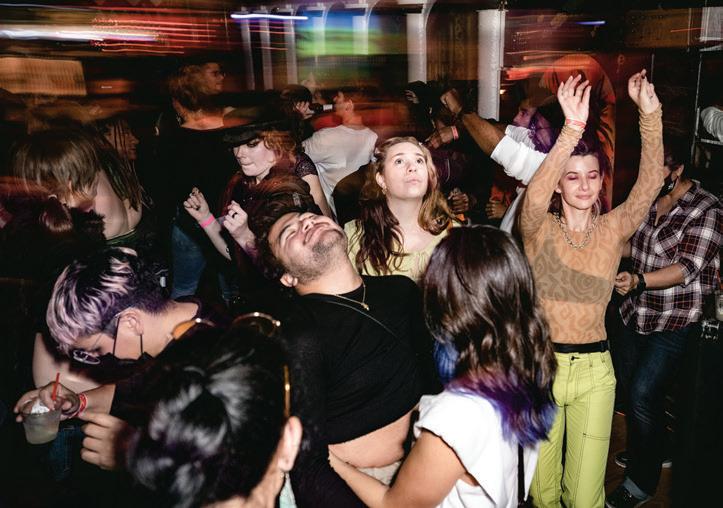
OCTOBER 13, 2022 - CHICAGO READER 47
MUSIC
“We need more spaces to dance, and I mean, really dance,” says Podlasie
Pleasure Club cofounder S. Nicole Lane. AARON ROLLE
and the crowd spilled into the street. Savin, who’d grown up in Rockford throwing house shows and the like, recognized the need to jump in—she asked if she could help Violetta and Vitek keep up with drink orders. So did a few others, including Zerah, who also helped Najdi troubleshoot equipment and electrical issues.
It was chaos, but in that magical way where everyone was excited to be away from their computers experiencing something human together: sweat, coincidence, eroticism, play. Afterward Savin went to a nearby Golden Nugget with the party organizers and their friends, eager to keep the excitement going and get involved with the next event. The next day, someone commented on Pleasure Club’s Instagram, “Best night of my life! Thank you.”
When other people from across the city’s electronic-music scene began approaching Violetta to throw their own parties at Podlasie, she developed an informal booking system: she’d simply write their names and numbers in pencil on a calendar behind the bar, then wait for them to show up at some point on their scheduled day.

Not every party was planned as well as Podlasie Pleasure Club. Its organizers brought their own audio gear and handed out flyers, and Tobiasz made curtains to add ambience to the bar as well as silk-screened promotional posters to hang around town. Teddy Piekarz (who works in the Reader sales department)
paid for an ad in the Reader. By contrast, new promoters who came aboard after Pleasure Club’s debut sometimes ended up with extremely sparse attendance. On several occasions, organizers arrived without necessary sound equipment (subwoofers, for instance) because they’d assumed the club provided it and Violetta didn’t know that she needed to say otherwise. More than once, hosts ran long, noisy sound checks that bothered Violetta’s regulars as they tried to unwind and shoot the breeze after work.

The greener someone throwing a party was, the longer Violetta had to wait for them to load up and leave at the end of the night— and the later she got home. Many didn’t help with cleanup, and the outdated, failure-prone electrical system in the party area (formerly a banquet hall) was a constant problem. By October 2021, the novelty of this new revenue stream was starting to wear off for Violetta and Vitek—they were feeling overwhelmed by the logistics of ensuring successful events.
Because Najdi and Savin had played such a big role in unbottling the party genie, they felt some responsibility for the chaos at the bar, and especially for the stress it was causing Violetta. As often as they could, they volunteered to help run other parties that Violetta had booked, so that they’d go more smoothly. They gradually picked up more and more event tasks so she could focus on what she knew best: running the bar with endearing hospitality.
When Zerah got a full-time job with Metro and Smart Bar in September 2021, Najdi reached out to his friend Jake Hopes to help with sound and electrical issues. Hopes, an Iowa-born record collector who’s been part of the electronic-music scene since moving here in 2014, lent the bar some of his personal audio equipment, built a makeshift DJ booth, and jerry-rigged the power supply so there’d be fewer outages. By November, the trio of Najdi, Savin, and Hopes had set up an Instagram for event promotion and an official Podlasie email to keep track of booking requests and other queries. They also switched the bar to a digital calendar and began scouting talent to ensure robust, diverse lineups. By the time the bar closed for remodeling, Violetta had been able to hire three new bartenders and three bouncers and was looking forward to adding barbacks and a cleaning crew upon reopening.
Najdi and Savin see their labor as an investment in their communities and the Pluta family; they both a ectionately refer to Violetta as “V” and describe her like an adopted mother. Hopes, who lives off multiple odd jobs, is worried that Avondale is losing its character and becoming una ordable. He just wants an a ordable hangout where people can drown out the noise of the outside world while listening to interesting music in a welcoming environment. He sees devoting time and energy to Podlasie Club as working toward the neighborhood he wants rather than the one he senses being forced on him.
After Podlasie Club’s reopening, Savin, Najdi, and Hopes joined the bar’s sta . Savin handles event organizing and promotion; Najdi and Hopes focus on booking talent and keeping the sound system running smoothly. Until going on payroll last month, the three of them had received minimal compensation for the work they did as they got more formally involved in growing the bar. During the five months when the club was picking up steam as a party spot, tensions emerged among the Pleasure Club crew. Tobiasz, Lane, Zerah, and Najdi were among the founders, with other friends pitching in during its short run. Now the party is on indefinite hiatus—it hasn’t returned since the reopening—and Tobiasz and Lane have cut ties with Pleasure Club.
Everyone I spoke to who’d thrown parties at Podlasie last year (including Najdi, Hopes, and Savin) expressed anxiety about the club’s potential role in gentrification. Some specifically criticized the three members of the crew who’ve become staff, accusing them of disrespecting Podlasie’s Polish history or hosting events that would bring about a dramatic change in the neighborhood.







“It’s Violetta and Vitek’s bar first and foremost,” Lane says. “This isn’t a ‘new Danny’s.’ It’s Podlasie. And it’s been there a lot longer than most of us. It has a huge history of dancing and community. The music is just a little di erent. I hope people—meaning DJs, bookers, dancers, or people waiting in line—honor and respect that.”
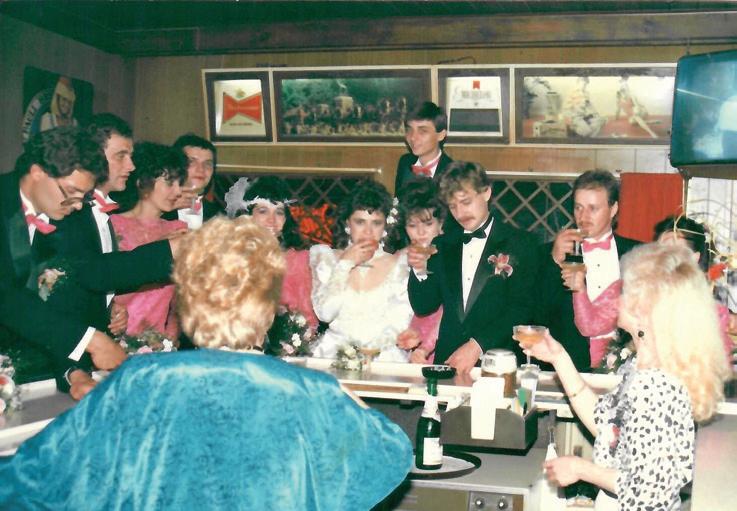


48 ll MUSIC
continued from 47
CHIC
AGO READER - OCTOBER 13, 2022
Podlasie Club owner Danuta Pluta behind the bar in the good old days
COURTESY PODLASIE CLUB
Danuta’s son Vitek o en worked the coat check when the bar hosted weddings.
COURTESY PODLASIE CLUB
When Pleasure Club debuted in July 2021, Podlasie was resplendent in Sovietera kitsch: a disco ball on the ceiling, a weathered parquet dance floor, vaguely Eastern European-looking flags, neon signs for Polish beers, and retro details such as a wall of reflective bubble domes, airbrushed black-light murals of bodies writhing and vine-covered coliseums, a warped mirror emblazoned with galloping horses, and overhead lights that chased each other in circles like a Ferris wheel at night. The bathroom floors heaved like funhouse mirrors underfoot, and there was a massive pool table whose surface had recorded innumerable spilled drinks. The bar felt visceral and unpretentious, in sharp contrast to the restrained and manicured condos and storefronts slowly inching up Milwaukee, and it attracted people eager for that energy.
Until the remodel, Podlasie hadn’t been updated since the 90s. The black-light murals and other campy details had been designed to excite overworked Eastern European transplants who’d come to America looking to escape state violence. Perhaps unsurprisingly, this struck a chord with today’s dancers, many of whom are wrestling with material and existential concerns loosely similar to those of Polish immigrants of the late 20th century.
Danuta came to the States in 1980, when she was 38. Like many of her generation who settled in Avondale, she was escaping the dire economy and authoritarian government of communist Poland. Since the early 1900s, Chicago has had the largest Polish population of any American city; in fact, Grease is based on Polish Chicago teen culture of the 1950s.
Immigrants came to Chicago in three main waves, two of them during Poland’s post-WWII decades as part of the Soviet bloc. In 1981, the country’s communist regime declared martial law, hoping to squelch the independent trade union and anti-authoritarian movement popularly known as “Solidarity.” During the ensuing struggle over the fate of Poland—in 1989, it would begin its transformation into the democratic Third Polish Republic—people fled the country in droves. Because the U.S. had passed the Refugee Act in 1980, making it easier for Polish people to seek political asylum in the States rather than elsewhere in Europe, many of them ended up here.
In the 1980s, two neighborhoods recognized by Polish people as Jackowo (“yahts-KOHvoh”) and Wacławowo (“vahts-wa-VOH-voh”) made up what are now Avondale and parts of Irving and Jefferson Park. These were des-
MUSIC




tinations that promised a cultural support system for Polish-only speakers, and many people, including Danuta, already had family here. Many immigrants of that era relied on “vacation visas” to get to the States, then never returned. This mass migration is sometimes called the Solidarity movement, not just because of the union pushing for change back home but also because of the new arrivals’ shared need to build futures together.
Everyone’s reason for leaving Poland was di erent, but by unspoken agreement, starting over here was safer than continuing to live under Poland’s repressive social and economic conditions. Focusing on that communal weight made recent immigrants more likely to support a loosely organized culture of mutual aid. Coming to the States wasn’t easy for anyone. So when everyone’s life is hard, why not share in lightening the load?
Danuta, who still speaks only Polish, left behind an ex-husband and four children who were being looked after by her mother. She was welcomed into her uncle Stanley’s home and connected with jobs that didn’t require much talking. Mostly she worked as a cleaner, but in Poland, she’d been a barmaid.
Serving drinks and chatting with people— performing the act of welcoming so that bar guests felt encouraged to relax and enjoy themselves—had always brought Danuta joy. But landing a local bar job was difficult as a non-English speaker. For six years, she worked long hours for low wages, often holding two or three jobs at a time so she could send money home while saving toward her dream of running her own club. She wanted a place where she could book the bands her friends loved and make them their favorite drinks. It’d be a home away from home. When Podlasie Club went up for sale in 1986, Danuta saw her opportunity.
Podlasie had never been the hottest spot in the neighborhood, but it had some name recognition, and Danuta could build on that. Because the bar had been around for a minute, locals knew it, but the name was meaningful to recent transplants too. Polish people know Podlasie as a region in the northeast of the country. “Pod” means “near” or “under” and “lasie” may be loosely derived from “forest,” so the name likely refers not just to a specific place and culture but also to a sense of being “by the woods”—or rather “out of the way.”
Being able to get comfortable somewhere “out of the way” was especially important to Danuta’s clientele, since so many had arrived in America fleeing constant surveillance. During the period of martial law, which lasted
SOCCER MOMMY ANTIFEST HOLLY HUMBERSTONE
REVENGE
DETIGER

OCTOBER 13, 2022 - CHICAGO READER 49
3730 N CLARK ST METROCHICAGO.COM @METROCHICAGO SMARTBARCHICAGO.COM 3730 N CLARK ST | 21+ SATURDAY OCT 15 I Love Acid LUKE VIBERT POSTHUMAN JUSTIN AULIS LONG DJ WARP FRIDAY OCT 14 What It Is... KEVIN SAUNDERSON SHAUN J. WRIGHT FRIDAY OCT 21 CARL CRAIG AATHEE SUNDAY OCT 30 / 9PM / 21+ AN ALL-BUILDING EVENT HALLO-QUEEN! RESIDENTS: Derrick Carter / Michael Serafini Garre David GUESTS: Lauren Flax / Mark Grusane / The Jak HOSTED BY: Lucy Stoole / Jojo Baby / Nico GUEST HOSTS: Valentine Addams / Sal E Miss Toto
SHE WANTS
BLU
DEATH FROM ABOVE 1979 MEN I TRUST DOOM FLAMINGO RUSSIAN CIRCLES NOV 01 NOV 04 NOV 05 NOV 06 NOV 08 NOV 09 NOV 10 NOV 11 NOV 12 FRI OCT 21 A METRO 40TH ANNIVERSARY CELEBRATION LOCAL H Here Comes The Zoo 20th Anniversary Tour FRI NOV 04 RIOT FEST PRESENTS ANTIFEST Anti-Flag / Suicide Machines We Are The Union Gully Boys / Blind Adam and the Federal League SAT OCT 22 NNAMD Ï + Joshua Virtue + Moontype Laid Back | Cold Beer | Live Music @GMANTAVERN GMANTAVERN.COM 3740 N CLARK ST 21+ SUN NOV 06 SHE WANTS REVENGE + The Chameleons + D’Arcy FRIDAY OCT 28 / 9PM / 18+ FORTUNATE YOUTH + Arise Roots / Joe Samba SATURDAY OCT 29 / 10:30PM / 18+ AMERICAN GOTHIC PRODUCTIONS PRESENTS NOCTURNA ALL HALLOW’S EVE BALL with DJ Scary Lady Sarah SATURDAY OCT 15 / 7:30PM / 18+ L7 + Fea SUNDAY OCT 16 / 8PM / 18+ ALGERNON CADWALLADER + Kinsella & Pulse Local H Nnamdi Anti Fest She Wants Revenge
MUSIC
from 1981 till 1983, people were expected to remain in their homes at night—at first the curfew was enforced from 7 PM till 6 AM, and later it was loosened slightly to begin at 10 PM. Authorities disconnected many phone lines and read mail before it was delivered. Community members frequently ratted one another out to curry favor with the state. Everyone felt hyperaware of being perceived, so they exercised tight control over what they were seen reading or wearing and policed their own public associations with other people. People learned to self-censor to feel safe.
Living like that in Poland had been exhausting. But Polish Chicagoans also found it draining to work constantly in a new country where they didn’t speak the language or totally understand the culture. They were extremely worn out, so clubs popped up across Jackowo and Wacławowo targeting a spectrum of escapist tastes. What’s your pleasure? There’s something to help everyone’s mind drift.
Danuta catered to middle-aged people like herself who liked acoustic dance music— polka, folk, jazz. It was lively music with working-class roots, and it invited dancing from couples and families who enjoyed the rehearsed steps of polkas and waltzes. When Vitek arrived in 1994, he remembers the club being frequented by regulars during the week, then packed with all kinds of people every Saturday and Sunday. Sometimes, the crowds showed up for weddings or birthdays, which he’d watch from the bar’s coat-check room, where he worked on weekends until landing a full-time job. Other times, they came out for concerts.
Danuta could easily find good music; she simply asked her customers who their favorites were and monitored which performers were generating buzz at neighboring spots. Then she used her club connections back home to bring joy to her community.
“People would say, ‘At Donna’s, there’s always a great band,’” says Vitek.

As documentarian Adrian Prawica points out in his 2018 film, A Night on Milwaukee Ave., Chicago’s Polish club scene thrived because it provided Polish Americans a glimpse of home while enriching Polish artists who were struggling in the old country. Many of the country’s top talents were huge celebrities domestically, but performing in Soviet-era Poland meant their fame came with a lot of visibility for very little money. Polish Chicagoans kept abreast of emerging Polish talent by hearing from visitors and recent immigrants, and many
also remembered specific singers and bands they never expected to see live again, if they’d ever seen those artists in the first place—some were such big deals in Poland that their shows had seemed inaccessible.
To Polish performers, Avondale provided a small but dedicated fan base who really, really wanted to see them. Because American money went pretty far in communist Poland, Polish musicians who could make the trip overseas were always happy to play for expats. The artists drew much smaller crowds but earned significantly more money, and they could express themselves in ways they couldn’t back home.
Polish Americans loved the chance to gossip, dance, do shots, or just sit elbow-to- elbow with their country’s biggest entertainers. From the 1970s till the 1990s, this mutually beneficial arrangement made clubs throughout the neighborhood feel electric.

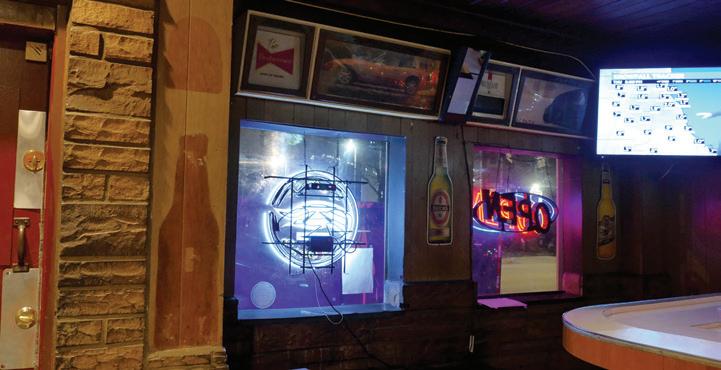

All that changed in the 2000s. After 9/11, the U.S. aggressively overhauled its immigration system, and in 2004, Poland was admitted to the EU. Many immigrants who’d come to Chicago during the Solidarity years returned to Poland, and the ongoing internal migration from the city to the suburbs continued.
Polish performers largely stopped touring the U.S. because it was no longer financially justifiable. The expat audience was older and less geographically concentrated, and more important, Polish musicians didn’t need it anymore. The Polish entertainment industry had recovered, and they could easily play to emigrants in England and Germany (currently the most popular countries for Polish expats), then return home on a two-hour flight.
In the 90s, Podlasie had regularly packed the house on weekends, but by the end of the aughts it only occasionally o ered entertainment. By the late 2010s, it had stopped hosting events altogether and resigned itself to life as a dive.
By 1994, all of Danuta’s children—Violetta, Vitek, Stanislaw, and Mariusz—had relocated to Chicago. Violetta came first in 1987, and she helped out at Podlasie Club a few days a week as a bartender before quitting for an office job. Then she got married, and in 1995, she left the state. Over time, the three brothers moved to the suburbs; Vitek became a corporate travel agent, Mariusz an organist, and Stanislaw a developer. Their mother remained in the city, running the bar alone. Then, in 2015, when Violetta was living in South Carolina, she got a call from Danuta. One of her bartenders was sick and on indef-
inite leave, and it felt impossible to replace a bilingual Polish worker at a struggling bar. Could Violetta please come home?
Until the pandemic, Violetta followed the same routine for years: she drove an hour into the city from Orland Park, opened the bar around noon, served her regulars (usually around happy hour), and closed up when she got bored (often sometime between seven and ten o’clock—the bar didn’t keep strict hours). She was happy to help her mother, but she and Vitek were concerned about the business’s future. Maybe they should cater to a younger crowd, Danuta’s children pressed—they could turn Podlasie into a disco to attract more peo-
ple. Or maybe they should just sell the bar so they wouldn’t have to think about it anymore.


“For some reason, [Danuta] never dealt with younger clientele,” Violetta explains. “It was always older. She was very skeptical of doing a disco. I always thought, It’s a dive bar. What do young people want with a dive bar? . . . Then we met Ali and Sophia and Justine, who said, ‘We love this place, and I know that some other people would love it.’ And they were just the nicest kids. The absolute nicest kids.”
Having never entertained a younger crowd, Danuta had no idea what to expect. Would they bring drugs or violence? Did she have to worry about property damage? Would she
50 CHICAGO READER - OCTOBER 13, 2022 ll
continued from 49
Podlasie Club before the remodel: the lights over the dance fl oor, the view looking out from inside the front door, some of the bottles behind the bar MICCO CAPORALE
MUSIC

have to call the cops? Once that crowd actually got in the door, though, things went OK. Najdi and Savin also taught the family that bar sta could be trained to keep guests safe and deescalate conflict without involving police. This helped renew the family’s desire to keep the bar running.
The family also decided to invest in the bar’s future, hoping to attract more people—and more business—to the neighborhood. Though Avondale’s demographics have shifted, the life and prosperity created by its Polish community have yet to be replaced. In February, Alderperson Ariel Reboyras, whose ward covers much of Avondale, told Chicago magazine that


its business vacancy rate is as high as 40 percent. Danuta, a resolutely independent person, can’t imagine ever leaving the neighborhood where she’s spent more than half her life, so she’s especially eager for local change that brings more activity.
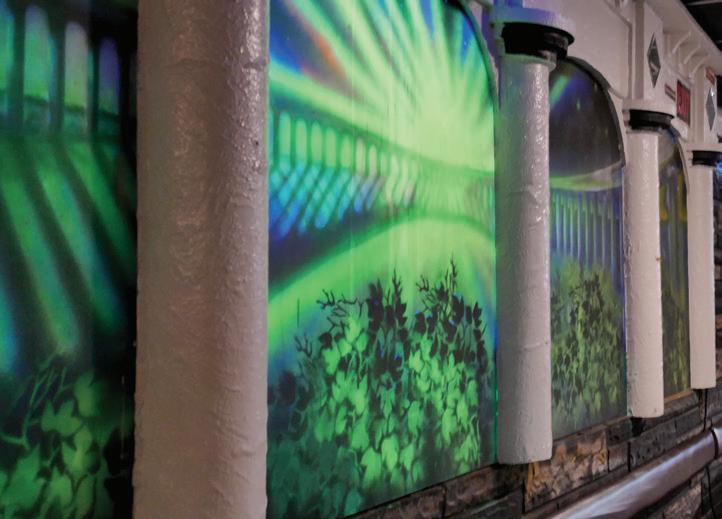

“Young people are being attracted to the area now,” Danuta explains via Vitek, her translator. “And young people . . . that’s life. It took a while to fill in the gap of missing Polish people here. Everything was Polish, every single store, pharmacies, bakeries, doctor’s o ces, everything. They’re all uprooted and gone now. Businesses went out of business, and it’s taken years for that gap to be filled in with new

OCTOBER 13, 2022 - CHICAGO READER 51
More of the old Podlasie: one of the former banquet hall’s murals, the pool table between the bar and the banquet hall MICCO CAPORALE
life. It’s better to have businesses filled in and working than a nonworking block of nothing.”
The gut remodel of Podlasie, which began in late February 2022, was necessary to update the electrical system and bring the bathrooms up to code. Some of the best parts of the old bar (including the murals) couldn’t be preserved if the family wanted to make the building safer and more reliable.
The family decided what to keep and what to scrap from the old bar with almost no input from Najdi, Savin, or Hopes. Danuta’s son Stanislaw oversaw the project. As owner of Wilmot Properties, he’s overseen many development projects in the Logan Square and Avondale neighborhoods, including the apartment building that went up on the site of landmark Polish business the Red Apple Bu et.
Last year, Block Club reported that Stanislaw had won approval from the city to rezone a lot in Logan Square for a 56-unit apartment building (the spot was originally zoned to permit only 23). Neighbors objected to the dearth of affordable units—the proposal offered just eight, below the legal minimum given the building’s proximity to public transit. Additional outcry arose over the fact that the redevelopment would destroy Project Logan, a four-sided graffiti wall that’s long been a crown jewel of the city’s street-art scene. Launched as a community-led cleanup project, it attracts tourists from across the country.
Community pressure persuaded Stanislaw to increase the share of affordable units to the minimum mandated 20 percent, and he also granted Project Logan’s founders two ground-floor walls of the proposed building to use for gra ti in perpetuity. Despite these compromises, Stanislaw won’t be winning any popularity contests in the neighborhood for a while. And Najdi, Hopes, and Savin knew nothing about any of this until I asked them about it in August 2022.
“I can feel the gentrification moving up Milwaukee,” Hopes told me during a phone call in March. He lives around the corner from Podlasie in a building that’s being gut rehabbed one apartment at a time by a Polish landlord who owns much of the block; he anticipates soon being priced out or kicked out of his apartment of seven years. “I knew the neighborhood was changing when—OK, you know those places where you go and drink wine with a group and everybody paints the same picture? When that happened down the street, it felt o cial.”
At Najdi and Hopes’s encouragement,
Podlasie now has a PA system that aims for a classic 70s disco sound, not a modern techno sound. It’s inspired by the setup at Paradise Garage (aka the Garage or “Gay-rage”), a legendary New York disco spot that could keep a party going from the wee hours all the way into the early evening.
“The sound is cleaner, so you’re able to take in more details,” Hopes explains. “You can listen to music in a way that’s less likely to make your ears hurt, and it’s easier to speak over because you’re not competing with noise created by low-quality signal output. It’s extremely rare for midsize clubs for underground artists to have this level of quality.”
That level of quality lets DJs push the possibilities of their talents and see what e ect it has on the audience. And the relatively small size of Podlasie means emerging talent can play to a packed house instead of a big club that’s half full.
“The more places to experience dance music, the better,” insists Najdi. He wants underground artists to have a reliable aboveground venue that’s affordable and comfortable for the type of audience that would follow them from a warehouse party to a club. “Chicago has gotten limited in its scope and range, and there aren’t many spaces intentionally cultivating this kind of community that’s accessible to multiple cross sections.”
“From ambient, to disco, to house, techno, hip-hop,” says Hopes, “we really want to focus on Chicago talent. We definitely want to have people coming in from out of town, but there’s so many talented people here of every generation and every type of dance music. We want to connect them.”
Podlasie Club’s bookings reflect this desire—that didn’t change with the remodel. The club’s reopening night on September 17 was headlined by rave legend Bill Converse, superstar of Bauhaus-inspired electronic label Dark Entries Records. The openers were locals versed in darker underground sounds: Jordan Zawideh, Lorelei, Beau Wanzer, and Valdez. The bill at the next show, on September 23, featured the brighter, more R&B-driven vibes of DJs Garret David, Miss Twink USA, and Maudi. The Podlasie crew are delivering artists from all over the underground dance map, and the club’s Instagram posts have started providing biographical detail and historical context about each performer.
But today Podlasie Club’s interior is a far cry from the space that welcomed everyone out of quarantine to throw back drinks and sweat into each other’s mouths. It’s mostly exposed
brick, though there’s some intricate floral wallpaper inspired by Polish folk patterns; local artists (many of whom are Polish) have also installed mini murals. The bar portion is visually defined as a sitting-and-talking space, outlined by inky leather couches and dotted with pony-hair chairs. Electric candles of varying sizes cast a dim light, and a vague but unmistakable spicy-sweet aroma hangs in the air. The party area and its dance floor are still in the back, separated from the bar by a gauzy curtain that opens into a black box of oblivion.
During the remodel, Vitek insisted that Podlasie would maintain its Polish spirit— there would be Polish-themed cocktails, and throughout the club the decor would make visual nods to Polish folklore. The old Polish beer signs would stay too. But in an important sense, whatever Podlasie did would have a Polish spirit, because it’s still run by Polish people.
“That’s who you are,” he says. “If you’re not authentic to where you’re from, you don’t have anything. I’m an American, but I’m Polish first. That’s important to all of us, including my sister. Mom worked really hard on this place for all these years. So we kind of want to keep it going, even though the clientele has changed. Mom is excited it’s still going. It’s almost like a big circle, you know? It’s a totally di erent genre of music and all that, but at the end of the day, you know, the ownership stays in Polish hands.”
On September 30, I went to Podlasie to catch Humboldt Arboreal Soundsystem—an informal DJ pop-up known for presenting weekend summer dance sets beneath a large tent in Humboldt Park. They’re a beloved staple of the local dance community, and they even loaned Najdi speakers for the first Pleasure Club party.
On the dance floor, I saw a white guy in a hoodie get unpleasant with an older Black woman in a straw hat who’d bumped into him as she danced. Another guy pressed his face into a woman’s ear to loudly explain house music as they stood still in the middle of the dance floor. Many people were elbowing dancers away so they could take selfies, even though the room was extremely dark. By the bar, there was a group of maybe seven men in suits—not o ce suits but the kind worn with no tie and a shirt button popped. One of them tried to dazzle the rest by balancing a beer can on his head, and another stumbled on something. He picked it up and o ered it for group inspection: an empty bottle of VCR head cleaner. “What the fuck?” he said, and someone of-
fered an explanation of poppers that sounded like a half-remembered Wikipedia article. Everyone laughed—what an amusingly exotic artifact they’d found. I stopped waiting for Humboldt Arboreal Soundsystem and went home before 1 AM. On opening night, I’d left before Bill Converse played too.
Chicago teems with people at peak clubbing age who feel unpleasantly hyperaware of being perceived—they’re policed by peers on social media, policed by social media platforms themselves, literally policed in their communities, or all three. And every day they have to publicly perform as very specific versions of themselves to make money. They’re eager for relaxed, accessible places to escape that exhausting virtual panopticon—places like Podlasie used to be and still could be again.
Many of these people are transplants making their living in the gig economy and renting rooms in packed apartments, but unlike Danuta and much of her generation, they almost certainly won’t be able to finance a building, even by working several low-paying jobs—and they certainly won’t be able to do it in less than ten years like she did. That means they’re unlikely to ever have ownership of their own club spaces—the kinds of changes that Podlasie has undergone will remain out of their control wherever they go.
At pre-remodel Podlasie, hundreds of people returned from a year spent inside enduring the botched government COVID response to find refuge from the pandemic’s acceleration of America’s economic collapse and descent into fascism. The bar echoed many of the aesthetics driving today’s cutting-edge club music—coldwave, for instance, is inspired by the low-tech synth experiments of Italo disco and 70s and 80s Eastern European dance music. For a beautiful moment in 2021, from the middle of July to the middle of December, Podlasie was the perfect cultural balm that no one could have predicted finding.
“We were a group of four young people wanting to listen to music and celebrate our love for one another,” says Lane, recalling the early days of Pleasure Club. “And while I’m not part of Podlasie anymore, it brings me joy to know that I was able to spend a few parties looking at a dance floor and seeing my best friends, complete strangers, and people I haven’t seen in years uniting and experiencing something really special. I hope there are many, many more lines down the block for the family, because they truly deserve it.” v
@JuggaloReporter
52 CHICAGO READER - OCTOBER 13, 2022 ll MUSIC
continued from 51


OCTOBER 13, 2022 - CHICAGO READER 53 TICKETS AT EVANSTONSPACE.COM
MUSIC
THE SECRET HISTORY OF CHICAGO MUSIC
In a scene full of big personalities, Jim Post was a giant
He helped shape Chicago’s folk boom, he scored a hippie-era hit single, he wrote and performed one-man shows, he toured the country as Mark Twain—and that’s not the half of it.
By STEVE KRAKOW
Since 2004 Plastic Crimewave (aka Steve Krakow) has used the Secret History of Chicago Music to shine a light on worthy artists with Chicago ties who’ve been forgotten, underrated, or never noticed in the first place.
Once again, Chicago has lost a legendary musician, and in this author’s opinion there haven’t been nearly enough public tributes. Jim Post was a crucial part of the Old Town folk scene in the 1970s, but compared to John Prine, one of his contemporaries on that scene, he’s barely been memorialized. Both men had long, productive careers, and I’d argue that Post took more interesting twists and turns on his path—he even had a hippieera hit song with the duo Friend and Lover. But there’s no need for comparisons. Post was very much his own man, and a real character too.
Jimmie David Post was born in Houston on October 28, 1939, and grew up outside the city in southeast Texas. In the liner notes to a 2005 reissue of Friend and Lover’s sole LP, Post explained his upbringing to author Richie Unterberger: “I lived in 100,000 acres of forest,” he
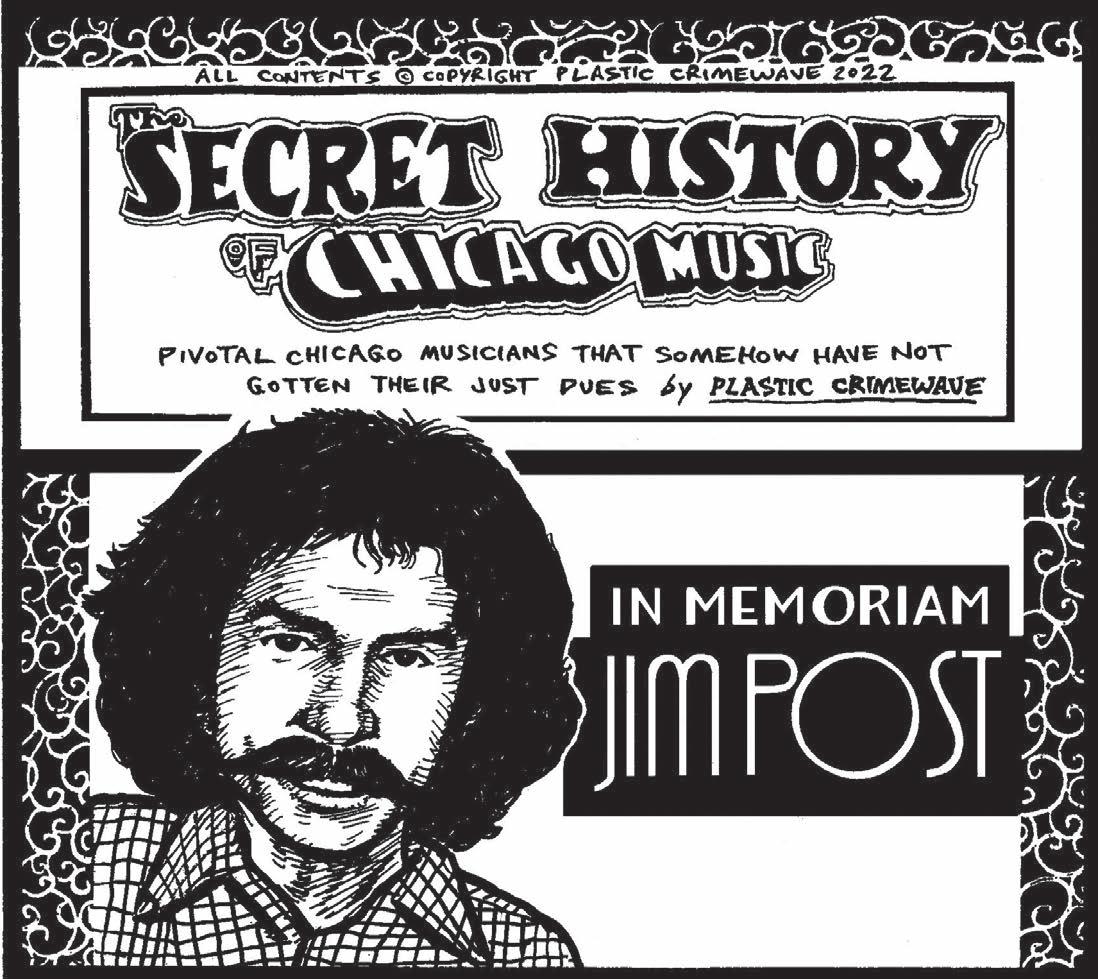
said, “about five to ten miles up the river from the San Jacinto Battleground where Texas won its freedom.” He started out by singing gospel at Baptist revival meetings, and at age six he won a broadcast radio competition. At that point, the die was cast, and Post was a performer for life.
As a young man Post joined Houston folk group the Rum Runners. “Our first tour was the Playboy tour, so I went from singing church music revivals to the Playboy tour,” he told Unterberger. A 1964 Rum Runners gig at a
fair in Alberta, Canada, would alter the course of Post’s life. He met dancer Cathy Conn, who was performing at the same event, and was instantly smitten. She lived in Chicago Ridge, just southwest of the city, and in short order Post packed up and moved here.
The couple threw caution to the wind and married within a few months. As the musical duo Jim & Cathy, they started playing the north-side folk scene, though the term “folk” never sat quite right with Post. “I didn’t know I was a folk musician until I went to Chicago,
and some people at the Old Town School of Folk Music said, ‘Well, you’re a folk singer,’” he told Unterberger. “But there’s a di erence between a folk singer who grew up in Chicago and decided to be a folk singer, and someone who grew up in the deep woods, going to those revival meetings and those dances and stu , and coming straight out of it. We didn’t think of it as folk music.”
The duo drew good crowds at the Earl of Old Town, the epicenter of the local folk scene, and soon signed with Chess Records
54 CHICAGO READER - OCTOBER 13, 2022 ll
STEVE KRAKOW
subsidiary Cadet. They released one single as Jim & Cathy, 1966’s “Santa’s Got a Brand New Bag” b/w “People Stand Back” (both written by Post), and neither exactly set the charts on fire.
In an attempt to keep up with changing trends, the couple renamed themselves Friend and Lover—Post was the friend, Conn the lover. They released one single on ABC Records (“A Town Called Love” b/w “If Tomorrow”), then went to New York to audition for Verve Records executive Jerry Schoenbaum. “He said, ‘You have to send me a tape, ’cause I never listen to people in person, because I’m a ected by the way they look,’ which is kind of strange when you think about it,” Post told Unterberger. “I said to him, ‘Well, why don’t you turn and look out the window, and we’ll sing for you?’” When Schoenbaum turned back around, there was a big smile on his face. The duo ended up getting signed.
The Verve Forecast imprint sent Friend and Lover to Nashville to record with future star Joe South (of “Games People Play,” “Walk a Mile in My Shoes,” and other soulful pop hits). At the session, the couple cut what would become their only hit, “Reach Out of the Darkness.” The song was inspired by a Central Park love-in they’d attended: “When we left, I had two lines written on a napkin,” Post told Northwest Quarterly magazine in 2008. “‘I think it’s so groovy, now, that people are finally gettin’ together,’ and ‘reach out in the darkness.’” (The record company missed that crucial “in,” which Post and Conn clearly sing in the song, and titled it with an “of.”)
“Reach Out of the Darkness” is unusual for a rock number—it uses a bass as the lead, and it has no verses. “In musical terms, it’s all choruses and refrains,” Post told Unterberger. “The bass player didn’t have any idea what to play, and I didn’t. You gotta realize, I knew nothing about rock ’n’ roll. I was really in church music and backwoods music; that’s where I grew up.” He ended up humming a line for the bassist to play, which nearly duplicated the melody. Ray Stevens (who’d later release “The Streak”) played keyboards and arranged the strings.
Released in fall 1967, “Reach Out of the Darkness” didn’t become an anthem for a generation until months and months later, in summer 1968. A great deal of dubious lore surrounds the timing of the song’s success. One of my favorite stories, which I can’t verify, concerns a manager or promo man who cranked it from a sound truck near a sit-in to protest the draft at Golden Gate Park (or outside the park’s Kezar
Stadium, where thousands of students who’d been arrested at the sit-in were being held). Supposedly this savvy operator also plied Bay Area radio stations with copies of the infectious flower-power tune.
The song fell o the charts quickly, but it’s had a long life: in the late 80s and early 90s, it was famously sampled by Biz Markie and by the trio Krush, and it’s been used in a long list of movies, commercials, and TV shows, including the original Beverly Hills, 90210 in the 90s and the sixth season of Mad Men in 2013.
On the strength of that hit, Friend and Lover recorded their only album, also called Reach Out of the Darkness, but the sessions su ered from session-drummer snafus and South’s declining interest. Post himself wasn’t a fan of the record, but I enjoy a lot of it—“Ode to a Dandelion,” also released as a B side in 1968, is primo acid folk (long before the genre had a name). I also like some of the Friend and Lover singles that followed, like the driving, psychedelic “Circus” from 1969. Their last release was the soulful “Hard Lovin’” b/w “Colorado Exile,” which came out in 1970, the same year the couple broke up and took the band with them.
Post briefly lived in Colorado and San Francisco before returning to Chicago in the early 70s. In San Francisco, he hooked up with Fantasy Records, which would release his first several solo LPs. The 1972 LP Slow to 20 was the first, showcasing Post’s savvy with blues, folk, and pop.
During this period Post became one of the leading lights on the Old Town folk scene, alongside Prine, Steve Goodman, Fred Holstein, Bonnie Koloc, and Corky Siegel. His 1973 solo LP Colorado Exile captured the charm of his high, keening voice and his earthy storysongs, with their clever lyrics and countrified tinges—it easily could’ve made him the next John Denver or James Taylor. But Post was convinced Fantasy didn’t promote the album enough.
He also admitted that he missed some opportunities himself. “Merl Saunders was playing for me, and he said, ‘I played the work tape for Jerry Garcia, and he wants to play on your album,’” Post told Unterberger. “And I said, ‘Well, I already have a guitar player.’” Garcia would release Old & in the Way with a top-shelf bluegrass band later that year, giving Post plenty of reasons to regret his decision.
Having lost faith in Fantasy, Post moved on after 1974’s Looks Good to Me, and by his own account “gave up on commercial music.” For the excellent 1977 LP Back on the Street Again,
he worked with Mountain Railroad Records, based in Cambridge, Wisconsin. The live album, recorded at several northern Illinois venues, features strong, heartfelt originals such as “Walk on the Water” alongside tunes by more obscure contemporaries, among them Dwain Story and Thom Bishop (both previously covered in Secret History).
His second and last release for Mountain Railroad, the 1978 studio album I Love My Life, has a more commercial sheen. Somewhat infamously, it features Post wet and shirtless on the cover (possibly under a waterfall), with his glorious full mustache soggy and drooping and a carefully neutral expression on his face that contrasts hilariously with the title.
In 1979, Post began a relationship with Chicago roots label Flying Fish, but he was also about to open up a whole new path in his career. In the early 80s, he settled in Galena, Illinois, which inspired him to create his first one-man show. Galena Rose: How Whiskey Won the West , which he wrote in 1986, was solo musical theater that presented gritty history and wild folklore in a ground-level view. “More than history, the show is a collection of songs and patter—the kind of music and stage talk that has made Post one of the most theatrical of our singer-songwriters,” Reader critic Hank De Zutter wrote in 1988. “The strength of the show is Post’s cornucopia of original music, a rich, simmering stew.”
Even opera star Luciano Pavarotti loved Galena Rose. According to Rick Kogan’s obituary for Post in the Chicago Tribune, Pavarotti found him backstage after a show and told him, “You have the voice of an angel. You should have been an opera singer.”
This led to other such productions in the early 90s, such as The Best Damn Songs (Most People Never Heard) , a memorial of sorts to his departed folk pals Steve Goodman and Stan Rogers. An Evening in Old Town also paid tribute to Chicago’s bygone folk scene: “Between songs Post reminisces about the early days,” wrote Reader critic Mary Shen Barnidge in 1994, “performing in Old Town clubs in the company of artists whose concert posters and album covers decorate the wall behind him—Steve Goodman, Fred Holstein, John Prine, Thom Bishop, Bryan Bowers, Tom Dundee, humble sideman Stephen Wade, and Bonnie Koloc.”
For his next act, Post created a beloved portrayal of Mark Twain (in Twain’s day, Galena was served by a busy steamboat port on the Mississippi). He wrote Mark Twain and the Laughing River and debuted it with a backing
band in 1996; later in its long run, it was usually a one-man show, with just Post’s guitar or banjo and his goose-bump-raising voice.
“The tunes, belted out in Post’s clarion country-gospel tenor, are catchy and charming,” wrote Reader critic Albert Williams at the time. “The hilarious, insightful stories and aphorisms convey Twain’s amusement at the foibles of human nature. . . . Post’s mischievous, slightly show-o y foxy-grandpa persona is irresistible.” He traveled widely to appear as Twain, and the role won him an American Library Association Award in 1997.
That same decade, Post got involved in children’s entertainment. Maureen O’Donnell shared his thoughts on the subject in her excellent Sun-Times obituary: “Performing for kids,” Post said in 1990, “is like performing for happy drunks.”
In the early 90s Post launched the children’s show Cookie Crumb Club at the Organic Theater Company in Chicago, and in the 2000s he wrote kids’ books with his wife Janet Smith (he’d eventually marry four times). Post and Smith also worked together on Breaking the Sounds’ Barrier: Reading by Ear, a series of songs and books designed to help kids learn to read phonetically.
Post appeared at a concert celebrating the 40th anniversary of the Summer of Love in 2007, alongside the likes of beat poet Michael McClure, Ray Manzarek of the Doors, psychedelic originators the Charlatans, and Country Joe McDonald and Barry “the Fish” Melton (the event spawned a box set of two CDs and two DVDs). Post also continued recording albums—the last was 2009’s Reach Out Together—and even after he stopped adding to his discography, he kept gigging. Over the past two years, though, his health declined dramatically, and he died of heart failure on September 14, 2022, while in hospice in Dubuque, Iowa.
Post is gone, but his rich body of work and outsize personality live on in his fans’ hearts and record collections. O’Donnell recalls that Post used to end his gigs by reminding the crowd, “If you keep coming to see me, I’ll never get a real job.” He never did—and we were all better o for it. v
Special thanks to Ken Voss and Richard Friedman for sharing their knowledge.
The radio version of the Secret History of Chicago Music airs on Outside the Loop on WGN Radio 720 AM, Saturdays at 5 AM with host Mike Stephen.
OCTOBER 13, 2022 - CHICAGO READER 55
MUSIC
MUSIC
PICK OF THE WEEK
SUPERJANE 25TH ANNIVERSARY
IN 1997, HEATHER ROBINSON (aka DJ Heather), Colette Marino (aka Colette), and Shannon Ialongo (aka Dayhota) debuted at Funky Buddha Lounge as the DJ collective Superjane; soon after their membership grew to include Darlene Jackson (aka DJ Lady D). Superjane have become a supergroup with their own center of gravity, but they’ve also functioned as advocates for other women fighting for space in the global dance scene.
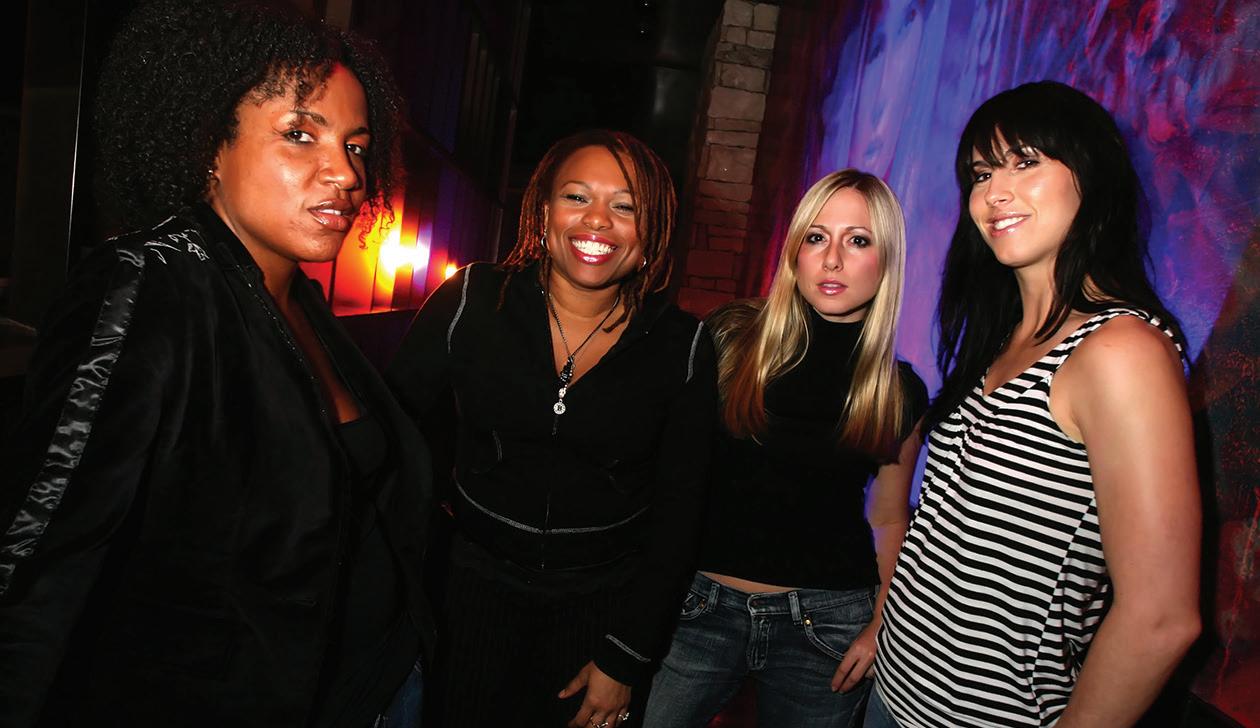
“When Superjane began, we were trying to mirror the approach of most parties going on, but with female promoters and female DJs instead of males,” Robinson told XLR8R in the early 2000s. “I’ve never really thought of myself as a woman DJ, but just as a DJ that happens to be a woman. I’m hoping people will be receptive to that.” The members of Superjane have stacked up individual accomplishments over the past quarter century—DJ Heather has become a Smart Bar resident, Colette has issued several albums through Candy Talk and Om, and DJ Lady D has worked as an A&R rep, where she gave Kaskade a big early-career bump—but even before all that happened, the four of them could hold down a party together. Since those early days as a unit, two members of the collective have moved to the west coast, but their bond has remained intact—at this Smart Bar show, Superjane celebrate their 25th anniversary. An entire generation of ravers has passed through Smart Bar’s doors since Superjane got started, so at least in theory this party could be full of all-new dancers getting their first chance to feel how Dayhota’s forceful tech house mingles with Colette’s relaxed, more pop-forward club tracks. —LEOR GALIL
CONCERT PREVIEWS SATURDAY15
Aperiodic, Clara de Asís Aperiodic performs music by Clara de Asís and Gabriela Areal; de Asís opens with a solo set. 8 PM, Elastic Arts, 3429 W. Diversey #208, $15. b
Clara de Asís is a Spanish-born, France-based multi-instrumentalist and sound artist who uses played and collected sounds as prompts to focus the power of the listener’s attention on the potentialities of the sound fields around them. The crackle of static and the decaying reverberations of struck metal on her new collaboration with Ryoko Akama, Sisbiosis (Erstwhile), are so involved that the presence of any traditional instrument would feel like a gauche intrusion. That’s not to say Asís doesn’t use such instruments, though—she employs them in her own performances as well as in her compositions for other players. On her 2018 solo album, Do Nothing (Another Timbre), the dissonant dialogue between her widely spaced guitar harmonics and a tolling Tibetan singing bowl generates enormous tension. And on Without (Elsewhere, 2018), performed by violinist Erik Carlson and percussionist Greg Stuart, discrete plucks and abrasions highlight the vast spaces that surround them. For her first Chicago appearance, de Asís will share the bill with local experimental ensemble Aperiodic. She will perform a solo piece for electronics and percussion, and then Aperiodic will play two of her pieces on a program that also presents works by Argentine composer Gabriela Areal. De Asís will spend the week following the concert collaborating with local sound artist Veronica Anne Salinas in a residency organized by the Cultural Office of the Embassy of Spain and Experimental Sound Studio. —BILL MEYER
Sabaton Epica open. 7 PM, Aragon Ballroom, 1106 W. Lawrence, $32.50. b
Founded in 1999, veteran Swedish power-metal band Sabaton cast a microscopic gaze on the horrors of war with a sweeping, majestic, and anthemic sound that walks the line between empathizing with humans on the battlefield and glorifying the unglorifiable. Their records deliver poetic lessons in military history (usually European), and though they aim to stay as free of controversy as possible, that goal isn’t completely realistic given the themes of their songs and the realities of the world we live in. Sabaton released The War to End All Wars (Nuclear Blast) in March, along with a symphonic version a few weeks later. A follow-up to 2019’s The Great War , the album continues the band’s deep dive into World War I. The songs are solid through and through, and the stories they share are memorable; “The Unkillable Soldier” tells the brutally inspiring tale of a famously indestructible Belgian, while “Race to the Sea” is an edge-of-the-seat drama about the Battle of Yser, in which Belgian forces held the line against an advancing German army.
The so-called Christmas truce—brief unofficial ceasefires that became widespread across the Western Front in December 1914—has become a corny, metaphorically abused cliche in pop culture.
56 CHICAGO READER - OCTOBER 13, 2022 ll
Superjane collective members Colette, DJ Heather, DJ Lady D, and Dayhota will all appear. Sat 10/22, 10 PM, Smart Bar, 3730 N. Clark, $25, $20 in advance.
21+
Chicago collective Superjane celebrate 25 years of throwing parties and elevating women in dance
Recommended and notable shows and releases with critics’ insights for the
week of October 13
Superjane members DJ Heather, DJ Lady D, Colette, and Dayhota COURTESY THE ARTIST
b ALL
AGES
F
But Sabaton’s take on it (in the song “Christmas Truce”) is touching in its bittersweet earnestness, especially contrasted with the deliberate false optimism of the following track, “Versailles.” Sabaton aren’t breaking new ground with The War to End All Wars, and they’re less interested in doing so than in further refining what they do best. With the world in the state it is, they’ll never run out of material. That said, they’re hardly done exploring the trenches of WWI. Last month, they dropped a surprise EP, Weapons of the Modern Age , the first installation in a trilogy about the mechanical and technological horrors of the Great War, and its six songs include the charging (“The Red Baron”), the eerie (“The Attack of the Dead Men”), and the heavy (“Dreadnought”). Sabaton were here last year opening for Judas Priest at Rosemont Theatre, and this concert is part of a rescheduled headlining tour intended for the spring.
—MONICA KENDRICK
SUNDAY16
Algernon Cadwallader Tim Kinsella & Jenny Pulse open. 8 PM, Metro, 3730 N. Clark, $30, $25 in advance. 18+
The pop-culture industry loves to resurface detritus from my youth, add a little polish, and launch it on whatever streaming service I’m most likely to drop due to rising subscription fees—and I’m mostly just exhausted by it. Band reunions, especially of bands whose reputations and fan bases have kept growing since their breakup, are a cottage industry within live music, but despite their foibles they’re a world away from, say, the feature-length reboot of D-level early-90s Disney property Chip ’n’ Dale: Rescue Rangers. But the stultifying ubiquity of remakes on TV and in film—had you heard that Tim Burton is coproducing a new Addams Family spin-off for Netflix?—has started to taint my emotional reaction when I hear that yet another cult group I got into during the blog-rock era is hitting the road again.
All the same, I perked right up in June when news broke of a reunion by Algernon Cadwallader, a Philadelphia group who reconsecrated 90s midwestern emo in the late 2000s.
Algernon Cadwallader’s songs make it difficult to be cynical—they have the delirious energy of a kid begging for five more minutes in a bouncy castle. The band’s two full-length albums, 2008’s Some Kind of Cadwallader and 2011’s Parrot Flies , contain key traits of fourth-wave emo, which emerged in the 2010s—notably yelped vocals and elliptically cycling guitars. They inspired a burst of “twinkle” emo bands creating similar sounds, but those groups usually cranked up the melancholy that’s only a subliminal part of Algernon’s radiance. Just before they broke up in 2012, Algernon could draw a few hundred kids to a Logan Square basement, and a year or so later the emo revival became a crossover phenomenon in indie rock. Once they were gone, they achieved the sort of mythic status that few bands ever get to reunite and enjoy, and their albums remain the subject of hot debates among young emo fans. Cadwallader has the peppy hits, but I increasingly think of Parrot Flies as the standout, not least because it was recorded by the band’s classic final lineup: drummer Tank Bergman, bassist-vocalist Peter Helmis, and guitarist Joe Reinhart (who now plays in Hop Along). Algernon’s playing is sharper on Parrot Flies , with Bergman’s no- nonsense drums and Helmis’s steel-pole bass anchoring Reinhart’s zippy guitar, which zigzags like the arms of an inflatable tube man. Every song, no matter how ambitious, feels like it was conceived as part of a larger whole.
In 2018, Asian Man Records teamed up with Lauren Records to reissue the group’s albums and release an odds-and-ends compilation called Algernon Cadwallader. I don’t expect Algernon to be the band they were more than a decade ago, and they’re not trying to be. For one thing, the lineup for this tour never performed together—Bergman, Helmis, and Reinhart will be joined by original second guitarist Colin Mahony and founding drummer Nick Tazza, and word is that every member will be onstage the
whole time. I can’t predict how that will pan out, but here’s hoping it’s as much fun for the crowd as it’s sure to be for the five of them. —LEOR GALIL
SATURDAY22
Nnamdï Joshua Virtue and Moontype open. 9 PM, Metro, 3730 N. Clark, $25, $22 in advance. 18+
Nnamdï’s sixth and latest album, Please Have a Seat (Secretly Canadian/Sooper), begins and ends with versions of the same refrain: “Some days I wake up ready to run.” Sure enough, since moving to Chicago from the suburbs a decade ago, the inexhaustible artist has essentially operated at a dead sprint. He records prolifically. He co-owns Sooper Records (with Sen Morimoto and Glenn Curran). He sings, he raps, and he plays guitar, bass, and drums, contributing nearly all the instrumental parts to his albums.
That said, Please Have a Seat sounds like the work of someone who’s stepped off the hamster wheel, however briefly, to wonder why he spent so much time running in the first place. Nnamdï dials down the goofy wordplay and madcap energy of albums past, though they’re far from gone—and another Nnamdï calling card, wholesale stylistic shi s within a song, continues to abound throughout. He’s at his blithe, bounceable best on “I Don’t Wanna Be Famous,” divulging quarter-life anxieties in the process. However, a line in the earlier song “Armoire” (barely snatchable in its galloping bars) might be the album’s most telling: “I used to dream I could have everything / I can finally see / That I already did.”
As a nod to those early days, his Please Have a Seat release show on October 7 turned the House of Vans into “Nnamdï’s Pancake Haus,” a big-boy version of the DIY venue he and his brother Alfred ran out of their suburban family home. (Meanwhile, his sister Kenechi is cited as a sampled voice on “Grounded.”) This headlining show at Metro is part of a fall tour with back-to-back legs in North America and Europe; Nnamdï will be supported by rapper Joshua Virtue, part of the Why? Records creative constellation. —HANNAH EDGAR

Superjane 25th anniversary See Pick of the Week at le . Superjane collective members Colette, DJ Heather, DJ Lady D, and Dayhota will all appear. 10 PM, Smart Bar, 3730 N. Clark, $25, $20 in advance. 21+
SUNDAY23
Automatic 8:30 PM, Empty Bottle, 1035 N. Western, $15. 21+
The women of Automatic were born to be in an artpunk band, but they’re still finding their footing. Much of the Los Angeles group’s press coverage has treated them like they’re learning their cra in real time while growing an audience through social media and handshakes. While that may be true, they’ve also had more career and creative advantages than your average indie outfit. Drummer Lola
Dompé is the daughter of Bauhaus drummer Kevin Haskins, and singer and synthesist Izzy Glaudini is the daughter of playwright Robert Glaudini and sister of Criminal Minds and Sopranos actor Lola Glaudini. Suffice to say they’ve had a leg up accessing artistic tools and professional guidance.
Still, Automatic aren’t aspiring to be arena rockers. Much of their charm comes from how they try to reconcile the inspiration they’ve found in DIY music scenes with their inheritances—not just a certain amount of industry access but also upbringings that included being exposed early to groundbreaking countercultural bands such as Suicide and Devo. On their 2019 debut album, Signals, they lean into an energetic, bass-heavy postpunk minimalism while hal eartedly brooding about how capitalism organizes everyday life. Their latest album, June’s Excess, embraces a poppier sensibility while wrestling with the social realities of the pandemic and climate change. It’s sometimes interesting, but it’s rarely adventurous—and it lacks the cohesion of Signals
Their vision comes through better in their music videos, which borrow from Warholian poptimism (“Venus Hour”) while toying with a Cold War aesthetic of anxiety (“New Beginning”). Automatic’s videos are flirty and fun, and they demonstrate a studied understanding of the roots of their audio and visual aesthetics while trying to situate them in the “now.” In “New Beginning” they head to outer space to escape a world on fire, drawing a parallel between the nuclear arms race (where the video gets much of its visual language) and present-day global warming. The video also functions like a survey of counterculture ideas from the past 60 years, most overtly in its literary references, which include Soviet urban-planning magazines and Monica Sjöö and Barbara Mor’s book The Great Cosmic Mother: Rediscovering the Religion of the Earth. It questions to what extent money or technology can save us.
While Automatic are still maturing as a band, they’re consciously trying to make the most of their advantages while proving they have something to say. The group shows a lot of promise, and it’s worth your time to watch them come into their own.
—MICCO CAPORALE
WEDNESDAY26
Joan La Barbara 8:30 PM, Constellation, 3111 N. Western, $15. 18+
Philadelphia-born composer and vocalist Joan La Barbara was formally trained as a classical singer, but by the late 1960s, she’d decided she wanted to push her artistry into unfamiliar territories. She found her inspiration in New York, especially from scat singers, free improvisers, and the jazz avantgarde. In her early experiments, she taught herself to imitate the timbres of different instruments—and during this period she fortuitously landed a gig singing in a radio ad for a Japanese perfume, for which she emulated a koto with her voice. This work proved crucial in the early 1970s, when she worked with minimalist pioneer Steve Reich on his landmark composition Drumming, improvising rhythmic parts that he fed into the piece and using her vocal flutters to approximate percussion patterns. While La Barbara would continue to collaborate with import-
OCTOBER 13, 2022 - CHICAGO READER 57
Nnamdï DENNIS ELLIOTT
MUSIC
MUSIC
ant artists throughout the decade, including composer Philip Glass, she would also begin composing and performing her own works. Her 1976 debut LP, Voice Is the Original Instrument, consists of three striking pieces that showcase the breadth of her extended vocal techniques. “Circular Song” uses circular breathing and vacillating glissandi whose simplicity provides their drama. Even more affecting is “Voice Piece: One-Note Internal Resonance Investigation,” where she employs overtones to showcase the wide expressive spectrum of a single pitch. Because the recording isolates La Barbara’s singing, it forces listeners to recognize the depth and power that a single human voice can wield. La Barbara’s versatility comes through even more strikingly when she’s accompanied by other instruments—on “Thunder,” from 1977’s Tapesongs, she collides with timpani to evoke the titular rumbling. Her foundational early works established a vocabulary of vocal sounds and techniques novel to Western avant-garde music, and her career has remained exciting in the years since.
“Twelvesong,” from 1983’s As Lightning Comes, in Flashes, blends throat clicks and layers of circular singing into what sounds like a jungle soundscape; the haunting wall of coos on “Shadowsong,” from 1991’s Sound Paintings, comes across as endearingly campy; and “Calligraphy II/Shadows,” from 1998’s Shamansong, combines La Barbara’s voice with traditional Chinese instruments in a stately and stirring tapestry. After decades of honing her craft, she’s rightfully considered one of the most important experimental vocalists of the past century. Her performance at Constellation should be a master class.
—JOSHUA MINSOO KIM
ALBUM REVIEWS
The Christian Tabernacle Concert Choir with Pastor DeAndre Patterson, Legacy Self-released Available from the church at 773-548-2500
Legacy , the Christian Tabernacle Concert Choir’s first release in 20 years, is a joyous collection of gospel songs and hymns, including many from the Chicago group’s original repertory. Dedicated to Christian Tabernacle’s founder, Pastor Maceo Woods, who died in January 2020, Legacy evokes the church’s 60-plus-year history of gospel supremacy with its old-school playlist, its seasoned personnel, and its sonic style. It features the church’s newly installed leader, Pastor DeAndre Patterson, who’s not only an accomplished singer, musician, and emcee but also Woods’s godson. Patterson has a passion for time-honored gospel that makes him the ideal inheritor of Woods’s musical mantle.
Woods was already a respected musician and choir director when, at age 27, he started the Christian Tabernacle Church in a rehabbed theater on Chicago’s south side in 1959. From the 1960s on, Woods and his Christian Tabernacle Concert Choir channeled classic and new gospel through a composite of jazz, rock, and soul without ever sacrificing their ecclesiastical foundation in service to the beat.
Alongside the Edwin Hawkins Singers’ “Oh Happy Day,” Christian Tabernacle’s 1969 cover of “Hello Sunshine” (written by Ronald Miller and Curtis Ous-
ley, aka King Curtis, and first recorded in 1968 by Wilson Pickett) announced the arrival of contemporary gospel music. Originally released on a local custom label and then by Stax Records’ Volt subsidiary, “Hello Sunshine” is included on Legacy in a new version as a bonus track.
Other nods to the past include “If It Had Not Been,” sung in a craggy but effective alto by longtime Christian Tabernacle Concert Choir member Maggie Bell Childs, who led the song on the choir’s 1981 album Bringing in the Sheaves. Another choir alumnus, Richard Jackson, delivers on “It’s Good to Know.” The full-throated choir is supported by a spirited rhythm section anchored by keyboardist Cliff Dubose, guitarist Joey Woolfalk, and bass player Richard Gibbs. If the busy arrangement for “Wings of a Dove” obscures some of the song’s beauty, selections such as “Saved and Sanctified” and “Wait on Jesus,” written for the choir in 1972 by the late Elder George Jordan, charge forward like an elevated train without brakes. —ROBERT MAROVICH
Freddie Gibbs, Soul Sold Separately Warner freddiegibbs.lnk.to/SSS
Freddie Gibbs has been on a famous rapper roller coaster since he put out his first mixtape in 2010— a journey marked with decadent twists, dizzying heights, and equally terrifying descents. Public beefs with big-name artists, moments as a media darling, well-received acting roles (including the lead in last year’s Down With the King), and acquittal from heavy assault charges make him the perfect artist to share a deep convo with over a couple of drinks—if only to separate man from myth. In 2020 his joint record with the Alchemist earned a Grammy nom, and many fans were upset when they lost to Nas for King’s Disease

Is Gibbs’s brand-new Soul Sold Separately the kind of album a tenured rapper would make after such a high-profile defeat? In a word, yes. Listening to it is like immersing yourself in the fun parts of Martin Scorsese’s 1995 crime epic Casino, if Gibbs owned said casino. You’re enjoying vices, romping through penthouse suites with your famous friend, and shutting the fuck up. Because if you listen closely, you’ll hear the type of gems commensurate with bosses.
SSS boasts an all-star cast, with Gibbs’s own famous friends (including Jeff Ross and Kelly Price) making guest appearances in lush features and skits. The list of producers is a rapper’s wet dream, and Gibbs always finds the pocket with his midwestern drawl and automatic flow. The Justice League-produced “Rabbit Vision” is cinematic: emotional pianos, expertly sprinkled rock-guitar riffs, and snapping snares complement Gibbs’s rap and street-war stories. SSS runs the gamut of hedonism, right down to the comedown—like any good romp, it ends. Luckily, you can always visit Gibbs at his casino or on the roller coaster. He isn’t going anywhere.
—CRISTALLE BOWEN
Ariel Zetina, Cyclorama Local Action arielzetina.bandcamp.com/album/cyclorama
DJ and producer Ariel Zetina has become a major
player in Chicago nightlife in no small part because she works in more than one medium. Zetina moved to Illinois in 2008 to study theater and creative writing at Northwestern University, and she’s flourished as a playwright. Her reimagining of the tragic life of computer scientist Alan Turing, Pink Milk , has opened at Long Beach’s Garage Theatre and Baltimore’s Single Carrot Theatre, and a few years ago the Trans Theatre Festival in Brooklyn staged British Honduras Fantasy , her semi-autobiographical play about a trans girl who travels to Chicago from Florida. Theater also provided Zetina with the impetus to start making music in 2013, because she wanted to supply her trans performance group, Witch Hazel, with dance tracks that meshed with the kinds of stories she wanted to tell. She’s since earned a reputation in the wider world of dance music while spearheading several club nights in Chicago, including Smart Bar’s Diamond Formation, which she launched in 2018.
Zetina brings her work in both fields to bear on her new debut album, Cyclorama (Local Action),

Find more music listings at chicagoreader.com/musicreviews
which takes its name from a large concave curtain or wall that serves as a background in many theater productions. A cyclorama is essentially a huge canvas—it o en represents the sky behind the action— and that’s fitting for Zetina’s ambition and the scope of her album. She builds arena-size landscapes with animated percussion that fuses the hard-edged attack of techno and the layered, danceable polyrhythms of punta, a Garifuna folk music popular in Belize (in her youth, Zetina sometimes spent the summer with her mother’s family in Belize). Cyclorama foregrounds Zetina’s experience as a trans woman of color, spotlighting members of her chosen family both in Chicago (Cae Monāe, Dannn) and outside it (Bored Lord). They deliver narratives about their experiences as trans people that leave room for others to see themselves in the songs. On “Slab of Meat,” Zetina’s blunt lyrics and dry delivery skewer bigots and fetishists who see trans women as objects, over a chest-thumping beat aimed right at the so spots of industrial-music heads and postpunk fanatics. —LEOR GALIL v
58 CHICAGO READER - OCTOBER 13, 2022 ll
Freddie Gibbs JAMES “JMP” PEREIRA
continued from 57
Ariel Zetina COURTESY THE ARTIST
WOLF BY KEITH HERZIK
GOSSIP WOLF
b ALL AGES F
EARLY WARNINGS
Band-Maid 11/1, 7 PM, House of Blues b
Jacob Banks 10/28, 6:30 PM, House of Blues b
Bartees Strange, Pom Pom Squad, They Hate Change 11/8, 7:30 PM, Thalia Hall, 17+ Baynk, Cosmo’s Midnight, Obli 10/29, 8 PM, the Vic b
Beabadoobee, Lowertown 11/29, 7:30 PM, Riviera Theatre b
Bear Grillz, Oddprophet, OG Nixin, Muerte 11/26, 10 PM, Concord Music Hall, 18+ Rick Beato 11/18, 8 PM, Park West b
GOSSIP WOLF HAS BEEN hip to Chicago rapper and singer Angelenah, aka Ashley Hart and Angel Davanport, ever since she released the 2018 EP Sore but Grateful . She’s been sharpening her skills in the years since, and last week she dropped I Don’t Regret a Thing , which showcases her flamboyant singing across six luscious R&B tunes. Her fi ery performance on the humid, slow-boiling “Drama” pushes her clarion voice so hard it starts to fray. On Thursday, October 13, Angelenah celebrates her EP with a show at Golden Dagger; ShowYouSuck, GreenSllime, and DJ TeaWhy open. Tickets are $12, and the show starts at 8 PM.
This wolf can’t think of a better source for Halloween-adjacent jams than former My Gold Mask multi-instrumentalist Jack Armondo . His darkwave project, Panic Priest , makes the kind of moody, soaring Peter Murphy- esque choruses and stomping electronic beats that would’ve kept the dance floor at Neo bumping till just before sunrise. The new Panic Priest album, Psychogoria, drops via Minneapolis label Midnight Mannequin next week, just in time for peak spooky season—and Armondo celebrates with a show at the Hideout on Thursday, October 20, with openers Iron Years and Clubdrugs plus sets by DJ Scary Lady Sarah; tickets are $12, and the show starts at 9:30 PM.
Otherpeace , the rootsy, meditative solo project of long-grinding Chicago rocker Matt Clark (Pinebender, White/ Light), debuted earlier this year with the charming and immersive album Capitalism Blues . Last week, Otherpeace dropped Lose Your Illusion I (For L.A.) , an EP of covers of songs about Los Angeles—its drawling version of Lana Del Rey’s “Mariners Apartment Complex” belongs on any fall playlist you’ve got! Otherpeace opens for the Deer at the Hideout on Thursday, October 13 ; tickets are $13, and the show starts at 9:30 PM.
—J.R. NELSON AND LEOR GALIL
Got a tip? Tweet @Gossip_Wolf or e-mail gossipwolf@chicagoreader.com.

NEW
Artbat 11/4, 10 PM, Cermak Hall at Radius Chicago, 18+ Ron Artis II 11/7, 8 PM, City Winery b Betty Who, Shea Couleé 3/21/2023, 7:30 PM, Riviera Theatre b Blessed 12/10, 8:30 PM, Empty Bottle
Blink-182, Turnstile 5/6/2023, 7:30 PM, United Center b Bono (book release and performance) 11/8, 8 PM, Chicago Theatre b Caamp, Dehd 12/13, 7:30 PM, the Vic, 18+
T.C. Carson 1/20/2023, 8 PM, City Winery b Circuit des Yeux, Aitis Band, Itsi 11/2, 8:30 PM, Empty Bottle
Countess Luann: A Very Countess Christmas with Luann de Lesseps 12/3-12/4, 7:30 PM, Park West, 18+ DC the Don 10/27, 7:30 PM, the Promontory b DaBaby 10/28, 9 PM, Patio Theater, 18+ Dead & Company 6/9/20236/10/2023, Wrigley Field b Dehd, Deeper, Physical Medium DJs 12/29, 8:30 PM, Empty Bottle
Dehd, Wombo, Neptune’s Core 12/30, 10 PM, Empty Bottle
Dehd, Grapetooth, Real Dominic 12/31, 8:30 PM, Empty Bottle
Disq, Ducks Ltd 11/16, 7:30 PM, Schubas b
Mike Doughty 10/29, 8 PM, SPACE, Evanston b Brett Eldredge 12/15-12/16, 8 PM, Chicago Theatre b Dominic Fike 12/10, 7:30 PM, Radius Chicago b Fitz & the Tantrums, Babyjake 2/2/2023, 8 PM, the Vic, 18+
Girli 3/11/2023, 8:30 PM, Empty Bottle
Guided by Voices 12/27-12/28 and 12/30, 7 PM; 12/31, 9 PM, SPACE, Evanston b Helloween, Hammerfall 5/26/2023, 7:15 PM, Riviera Theatre, 18+ Jackie Hayes, Interlay, Godly the Ruler 10/28, 8 PM, Schubas b
Just Mustard 11/10, 8:30 PM, Empty Bottle Zoë Keating 11/20, 7 PM, Maurer Hall, Old Town School of Folk Music b Kshmr 12/2, 10 PM, Radius Chicago, 18+ Malaa, Acraze 11/12, 10 PM, Radius Chicago, 18+ Maldita Vecindad 11/18, 8 PM, Riviera Theatre, 18+ Mamalarky 11/12, 9 PM, Schubas, 18+ Maysa 1/14/2023, 7 and 10 PM, City Winery b Mezerg 11/4, 9 PM, Lincoln Hall, 18+ Mormor 1/28/2023, 9 PM, Lincoln Hall, 18+ Murlocs, Paul Jacobs 11/15, 7:30 PM, Thalia Hall Parov Stelar, DJ El Siciliano 3/4/2023, 9 PM, the Vic, 18+ Pendulum (DJ set) 10/28, 10 PM, Concord Music Hall, 18+
Pentatonix 12/1, 7:30 PM, Allstate Arena, Rosemont b Phony Ppl 12/11, 8 PM, Lincoln Hall, 18+
Railroad Earth with Peter Rowan 12/30-12/31, 8 PM, the Vic, 18+
Revival featuring Mila La Morena, Chillona, Cece Maravilla, M.E.H. 11/13, 8:30 PM, Empty Bottle Jordan Reyes’s Ark of Teeth 11/4, 7:30 PM, International Museum of Surgical Science, 18+
Sad Night Dynamite, Saiah 11/23, 7:30 PM, Lincoln Hall b Samia, Tommy Lefroy 2/17/2023, 8 PM, the Vic b Savage Gasp, Kamaara, Supachefm 12/4, 7:30 PM, Subterranean, 17+ Ty Segall (solo), Emmett Kelly 11/11, 8:30 PM, Thalia Hall, 17+ Sevdaliza 11/1, 8 PM, Lincoln Hall, 18+
Claudio Simonetti’s Goblin performs the live score to Suspiria 10/28, 8 PM, Thalia Hall, 17+ Son Little 12/9, 9:30 PM, Chop Shop, 18+ Matthew Tembo 11/30, 8:30 PM, Maurer Hall, Old Town School of Folk Music Fb Tiësto 12/27, 10 PM, Radius Chicago, 18+ Varials, Dr. Acula, Orthodox, Distinguisher 11/4, 6:30 PM, Beat Kitchen, 17+ Yotto 2/24/2023, 10 PM, Concord Music Hall, 18+
UPDATED
Two Door Cinema Club, Day Wave 11/7, 7:30 PM, Riviera Theatre, canceled
UPCOMING
AFI, Drab Majesty 11/15, 7 PM, Riviera Theatre b Altan 10/30, 7 PM, Maurer Hall, Old Town School of Folk Music b Trey Anastasio Band 10/2810/29, 7:30 PM, Chicago Theatre b Antifest featuring Anti-Flag, Suicide Machines, We Are the Union, Gully Boys, Blind Adam & the Federal League 11/4, 6 PM, Metro b
Bijou, Marten Hørger 11/4, 10 PM, Prysm Nightclub
Black Coffee 10/29, 10 PM, Radius Chicago, 18+ Black Lips 11/16-11/17, 8:30 PM, Empty Bottle
Blind Boys of Alabama 12/7, 8 PM, City Winery b Blk Jks, Sidaka 10/31, 7:30 PM, Schubas, 18+
Joe Bonamassa 11/4-11/5, 8 PM, Chicago Theatre b
Suzanne Ciani, Sam Prekop 11/19, 8 PM, Rockefeller Chapel b
Judy Collins 10/28-10/29, 8 PM, Maurer Hall, Old Town School of Folk Music b
Shemekia Copeland 12/16, 7 PM, City Winery b
CupcakKe 10/28, 9 PM, Chop Shop, 18+
Dave East 11/2, 8 PM, Avondale Music Hall, 17+
Death From Above 1979, OBGMs 11/9, 7:30 PM, Metro, 18+
Doom Flamingo 11/11, 11:59 PM, Metro, 18+ Dopapod 11/13, 9 PM, Bottom Lounge b
Duma, Masma Dream World 10/31, 8:30 PM, Empty Bottle
Samantha Fish, Jesse Dayton Band 12/16, 7:30 PM, Park West b
Sonny Fodera, Biscits 10/29, 10 PM, Concord Music Hall b Fortunate Youth, Arise Roots, Joe Samba 10/28, 9 PM, Metro, 18+
Fuerza Regida, Calle 24 12/2, 8 PM, Allstate Arena, Rosemont b
Halloweensteen featuring Michael McDermott & the Duke Street Kings 10/29, 8 PM, Park West, 18+
Herencia de Patrones 11/20, 7:30 PM, Park West b
Jean Dawson, Junior Varsity 11/5, 7:30 PM, Lincoln Hall, 18+ Kalush Orchestra 11/4, 7 PM, Concord Music Hall b Los Lobos 12/12-12/13, 8 PM, City Winery b
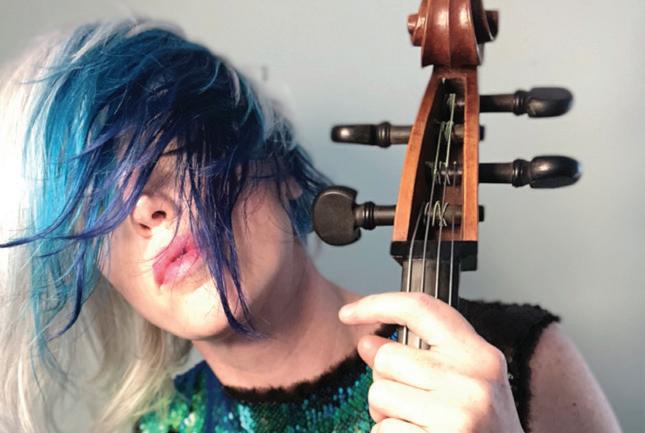
Matt Maltese 11/1, 8 PM, Bottom Lounge, 17+ Kevin Morby, Coco 10/31, 8 PM, the Vic, 18+
The O’My’s 12/1, 9 PM, Sleeping Village Plains, M.J. Lenderman 11/17, 7:30 PM, the Vic, 18+
Never miss a show again. Sign up for the newsletter at chicagoreader. com/early
Queers, Don’t Panic, Capgun Heroes, Goodbye Sunshine 12/7, 8 PM, Reggies Rock Club, 17+
Record Company 11/4, 8 PM, Park West b
Sanctum Dark Music Festival featuring Adult., Psyche, Boy Harsher, So Crash, Plack Blague, Void Vision, Hide, Blu Anxxiety, and more 11/2511/26, 6 PM, Thalia Hall, 17+; 11/27, 6 PM, Empty Bottle
Skegss 11/27, 7:30 PM, Metro b Slaughter to Prevail 11/2, 7 PM, Concord Music Hall, 17+ Smile (Thom Yorke, Jonny Greenwood, and Tom Skinner) 12/1, 8 PM, Riviera Theatre, 18+
Smoking Popes, Limbeck, Color Fred, Off With Their Heads 11/12, 8 PM, Bottom Lounge, 17+ Todd Snider 11/3, 8 PM, Park West, 18+ Soccer Mommy, Lightning Bug 11/1, 7 PM, Metro b Squirrel Nut Zippers 11/12, 7 and 9:30 PM, SPACE, Evanston b
State Champs, Hunny, Between You and Me, Young Culture 11/18, 5:30 PM, Concord Music Hall b Colin Stetson, Elori Saxl 11/1, 8:30 PM, Constellation, 18+ Straight No Chaser 12/23, 8 PM, Chicago Theatre b Streetlight Manifesto 11/18, 8 PM, Radius Chicago b Tove Styrke 11/5, 8 PM, Beat Kitchen b
Surf Curse 12/6, 7:30 PM, the Vic b
Tegan & Sara, Tomberlin 11/3, 7:30 PM, Riviera Theatre b Twiddle, Dogs in a Pile 11/10, 8 PM, Park West, 18+
Umphrey’s McGee presents Umbowl IX 11/11-11/12, 7 PM, Riviera Theatre, 18+ Steve Vai 11/16, 7:30 PM, Copernicus Center b Alan Walker 11/19, 9 PM, Radius Chicago, 17+ Patrick Watson 12/2, 8 PM, Thalia Hall, 17+ Whitney 12/21-12/23, 8:30 PM, Thalia Hall, 17+ Wild Pink, Trace Mountains 11/28, 8 PM, Sleeping Village Keller Williams with Dave Watts & Tye North 11/19, 8 PM, Park West, 18+
Windborne’s The Music of Queen with the Chicago Philharmonic and featuring Mig Ayesa 11/25, 8 PM, Auditorium Theatre b v
OCTOBER 13, 2022 - CHICAGO READER 59
Zoë Keating JO TREK
CHICAGO SHOWS YOU SHOULD KNOW ABOUT IN THE WEEKS TO COME
A furry ear to the ground of the local music scene
CLASSIFIEDS
JOBS
Blucapsoft LLC has openings for the positions: Software Developer with Master’s degree in Computer Science, Engineering any, Technology. Information Systems or related to design, develop, implement, maintain and test business functions and web applications using a variety of languages, tools, methodologies and technologies. Analyze user needs and develop software solutions. Design software or customize software for client use with the aim of optimizing operational efficiency. Design and execute QA tests using Python scripts that automatically test functionality. Responsible for writing the Test Cases/Verification procedures and reports generation. ServiceNow Developer with Master’s degree in Computer Science, Engineering (any), Technology or related to Involve in creating users, groups, roles and load the data to service now using import sets. Involve in performance analytics for creating reports, dashboards in ServiceNow. Provide advanced support for Service-Now by troubleshooting a variety of difficult software problems, implementing bug fixes and performing root cause analysis. Responsible for implementation and administration of ITSM and Custom Application Development in ServiceNow. Work location is Chicago,IL with required travel to client locations throughout the USA.Please mail resumes to 4001 W Devon Ave, Suite 202, Chicago,IL 60646 (OR) e-mail: zubair. muhammad@blucapsoft. com
Moback, Inc. seeks a Software Engineer in Chicago, IL to intgrt ntve Flutter app in2 Unity simltn 4 autonmus vhcl apps. Telework/WFH avail. Email Resumes to: Fareeha Batool fareehab@ moback.com; Subject: Software Engineer, Reference #SE08092022.
Caregiver
Responsibilities:
Assisting with personal care, Following a prescribed healthcare plan, Ensuring my Mother home is organized according to her needs.
Providing mobility assistance may be required, for example helping my Mother with her motorized wheelchair, appointments, grocery. Meal and watch over. Work Schedule is 5 days a week and 5 hours per day. Salary is $26/hr. Contact by email Daniel (dajcahh@gmail. com) for more details.
Specialist w/ MCKINSEY & COMPANY, INC. US (Chicago, IL).
Act as core member of the McKinsey team to shape product vision & build fully functioning web & mobile apps for clients from IT modernization & strategy to agile, cloud, cybersecurity, & digital transformation.
Telecommuting permitted. Req’s Master’s degree in IT, Mgmt Info Sys, Comp Sci, or rel field or the foreign degree equiv & 2 yrs of exp working in an Agile org as s/w developer or rel occupation; OR a Bachelor’s degree in IT, Mgmt Info Sys, Comp Sci, or rel field or the foreign degree equiv & 5 yrs of progressive, post-baccalaureate, exp working in an Agile org as s/w developer or rel occupation. Exp must incl: focus on design, product or data; involvement in product design decisions across concept, prototyping, pre-production, production, testing, forecast, promotion & end-to-end support; End-to-end knowledge of product dvlpmnt & user exp; using 2 of the following apps: JavaScript, TypeScript, React, Angular, Vue, or jQuery; API: Java, Spring Boot, C#, .NET, or Node.js; databases: MySQL, SQL Server, MongoDB, or cloud-native databases; Cloud infrastructure: AWS, Azure, or GCP; DevOps: Jenkins, Docker, CircleCI, or Travis; Using Agile methodologies; Scrum framework; Design tools: InVisionApp, Miro, Balsamiq, or Zeplin. At least one of the following Workflow mgmt tools: JIRA, Confluence, or Azure boards. Domestic & int’l travel typically req. Destination & frequency impossible to predict. Email your resume to CO@mckinsey.com & refer to Job # 6461992 No phone calls please.
An EOE
SR. ANALYTICAL SCIENTIST II (Vernon Hills, IL): perform prod. methods development/chem. phys. assays; ascertain degradation profiles; validate analytical methods; write developmental reps, SOP’s, Protocols/Test Methods as per cGMP req. Masters deg. (or in the alternative a Bachelor + 5 yrs. prog. exp. with below skills) in Pharm. Sci., Chem., or rel. + 3 yrs exp. in HPLC, UPLC, analytical method development validations; GC, UPLC, GC, dissolution. (foreign equiv. deg. OK).
Submit resume to Akorn Operating Company LLC, 1925 West Field Court, Suite 300, Lake Forest, IL 60045.
TECHNOLOGY ServiceNow Inc is accepting resumes for the following positions in Chicago, IL: Senior Front End Software Engineer, JavaScript (ref# 51433422243): Work on the UX Engineering Platform team to build highly interactive and scalable web-based application. Telecommuting permitted. Email resume to servicenowresumesUS@ servicenow.com. Or mail resume to ServiceNow Inc, Attn: Global Mobility, 2225 Lawson Lane, Santa Clara, CA 95054. Resume must include job title, job ref. # 5143-3422243, full name, email & mailing address. No phone calls. Must be legally authorized to work in U.S. without sponsorship. EOE.
Manager of Software Engineering, Chicago, IL: Manage one or more teams developing, modifying, or updating services used by the company. Lead or play a lead role in the dev. team’s efforts to determine unit needs & business processes. Own planning, estimation & tracking of features & help define software development life cycle. Req’d: Bach. or higher deg. in IT Mgmt., Comp. Sci., Software Eng., or related tech. discipline & 7 yrs. software eng. exp. May work remotely up to 3 days/wk. Resumes to code HLMSE, J. Ximenes, ADMI, 800 W. Fulton Market, Chicago, IL 60607.
DENTISTS
Dental Experts LLC d/b/a Dental Dreams LLC in Chicago, IL seeks qualified dentists. Provide dental services to patients. DDS in Dentistry (Will accept DMD in Dentistry) or foreign acad equiv w/background &/or coursework in pediatric dentistry, prosthodontics, periodontics, endodontics, orthodontics, oral medicine, oral pathology, oral surgery and radiology. Dental license req’d. 40 hrs/wk. Send cover letter & resume to: Dental Dreams, LLC, Attn: Michael Peters, 350 N. Clark St, Suite 600, Chicago, IL 60654. Refer to ad code DD-102072.
Technical Support Analysts, Chicago, IL: Develop Company KPI’s and a process for tracking and reporting them. Provide recommendations on consolidating, changing, or adding financial software tools.
Analyze trial data and determine if there our opportunities for better conversion rates. Work from home permitted. Send res to: Barchart.com, Inc. HRgroup@barchart.com.
Polar Operations LLC (Chicago, IL), a part of the IMC Group, seeks experienced professional Software Engineer Team Leads to collaborate with Traders, Quants and other members of the engineering team to bring the IMC Group’s quantitative trading strategies and software platform to the next level using advanced analytical and programming skills. Interested candidates should send resume to: talent@ imc-chicago.com with “Software Engineer Team Leads” in subject line.
Access Community Health Network seeks Family Medicine Physician in Chicago, IL: Provide primary medical care to children, adults & seniors (conducting medical examinations, prescribing medications, providing advice on maintenance of health & prevention of disease), referring patients to specialists as appropriate. Reqs: Medical Degree, IL Medical License & completion of Family Medicine Residency. Email CV to Jeffrey Rekett at Jeffrey.Rekett@achn.net
Structural Engineer (Internal title Civil Engineering Intern II) Under direct supervision of Staff/Project/Senior Engineer, perform assignments to develop knowledge/abilities, requiring application of techniques, procedures, and criteria in engineering tasks. Duties: assist w client contact pertaining to specific projects; assist w development of probable construction cost estimates for projects; assist w analysis of reports, maps, drawings, blueprints, tests, and aerial photographs on soil composition, terrain, hydrological characteristics, and other topographical and geologic data; prep design computations and quantity estimates; assist w preparation or modification of reports, specs, plans, schedules, environmental impact studies, permits and designs; instruct draftspersons/technicians to reduce designs to working drawings; review site to monitor progress and other duties per contract; serve as onsite project rep. Worksite in Joliet, IL. Reqd: BS in Civil Eng, 2 yrs exp w CAD software and equip to prep eng/ design docs, certificate re passage of Fundamentals of Engineering exam; and perm US work auth. Contact B. Converse, Willett, Hofmann & Associates, Inc., 809 E. 2nd St., Dixon, IL 61021.
Senior Experience Designer (Professional Services) Thoughtworks seeks Senior Experience Designer (Professional Services) to work in Chicago, IL & various unanticipated U.S. locations to work on largescale, custom-designed enterprise level software development projects that use object-oriented technologies, such as Java, Ruby, or .NET. Must have Bachelor degree in Design, Graphic Design, Software Engineering or related field. Must have 3 years exp. in the job offered, Interaction, Visual or Product Designer, UX Researcher, Front-end Developer, Consultant or related position. Must have at least twelve (12) months experience in: (1) Translating concepts into user flows, wireframes, mockups and prototypes that lead to intuitive user experiences; (2) Facilitating the client’s product vision by researching, conceiving, sketching, prototyping and user-testing experiences for digital products; (3) Collaborating with practice leads and general managers for project delivery assurance; (4) Identifying design problems and devising elegant solutions; (5) Working with stakeholders to understand detailed requirements and designing complete user experiences that meet client needs and vision, while managing relationships; (6) Supporting Design Thinking Workshops, Inceptions, Systems Thinking, and Service Design, and conducting user research through ethnography and prototyping; (7) Working on project inceptions in collaboration with project sponsors to define the work and scope of an engagement; (8) Contributing to stand up meetings, retrospectives and showcases; (9) Coaching on experience design and Agile Methodologies; and (10) Collaborating on strategic design and user-experience decisions related to core, and new functions and features. At least 80% travel across U.S. Send resume to ijobs@thoughtworks.com w/ Job ID SED2022.
Accountant
Moreback CPA LLC in Chicago IL seeks Accountant to examine financial statements, prepare tax returns, inspect accounting systems, assess internal control procedures. Requires Master’s degree in Accounting; CPA license; demonstrated knowledge of tax research & accounting information systems, related courses acceptable. Email resume to chicagocpa4@ gmail.com
Multiple openings for Software Engineer (Wargaming (USA), Inc.; Chicago, IL): Responsible for coding, debugging and managing critical engine systems. Optimize code for memory and performance. Mail resumes to: Attn: HR, Wargaming (USA), Inc., P.O. Box 1206, Chicago, IL 60690. An EOE
SAP SCM/TM CONSULTANT Novigo, Inc. has multiple positions available in Chicago, IL: SAP SCM/TM Consultant (Ref# 6007181) Telecommuting permitted. Travel required 60%. To apply, send resume and transcripts w/ job title and Ref# 6007181 to recruitment@novigo. com. EOE.
Sr Mngr, SW Dev & EngSr Mngr, SW Dev & Eng – Comcast Cable Comm, LLC, Chicago, IL. Trvl 10% domestic. Mng teams resp for maintain SW app. Reqs: Bach in CS, Eng or rltd; 7 yrs exp participate in full SDLC w/i Agile/Scrum environ; participate in QA process to test SW app; summarize & comm. proj update to stakeholder; 5 yrs use Atlassian Jira & Confluence, MS Visual Studio, GitHub, .Net, NuGet, SQL Server; use Gurock Test Rail, SmartBear TestComplete; & mng SW dev teams. Apply to: Renu_Puril@ comcast.com Ref Job ID #0308
SENIOR BUSINESS
ANALYST HYDY, Inc. is accepting resumes for Senior Business Analyst in Chicago, IL. Partner with Product Managers to analyze key business processes and problems, define key metrics and identify insights to define new products and features requirements. Telecommuting permitted. Mail resume to HYDY, Inc., Attn: HR, 444 W. Lake Street, Suite 1700; Chicago, Il 60606. Must reference Ref. SBA-AT.
Business Analyst Lead Groupon, Inc. is seeking a Business Analyst Lead in Chicago, IL w/ the following responsibilities: Analyze key performance metrics across all channels of distribution & traffic sources for Groupon, incl category & deal level portfolio optimization. Up to 100% telecommuting allowed. 10% domestic travel required. Apply at www.grouponcareers. com by searching keyword R27151
ADULT SERVICES
Danielle’s Lip Service, Erotic Phone Chat. 24/7. Must be 21+. Credit/ Debit Cards Accepted. All Fetishes and Fantasies Are Welcomed. Personal, Private and Discrete. 773-935-4995
RESEARCH
Have you had an unwanted sexual experience since age 18? Did you tell someone in your life about it who is also willing to participate?
Women ages 18+ who have someone else in their life they told about their experience also willing to participate will be paid to complete a confidential online research survey for the Women’s Dyadic Support Study.
Contact Dr. Sarah Ullman of the University of Illinois at Chicago, Criminology, Law, & Justice Department at ForWomen@ uic.edu, 312-996-5508. Protocol #2021-0019.
COMMUNITY
Seeking those who empathize with men Have you been taught that “men have the power and women are the victims”? Have you ever wondered if there might be more to it than that? Are you interested in a more balanced outlook? We are a Chicago based group. We meet once a week on Zoom and, occasionally, we also meet in person. We talk about gender-related issues as they play out in the world and as they play out in our private lives. We support each other emotionally, and we take action. We reject inter-sex rage, rancor and resentment. We are an inclusive group; all who empathize with men are welcome to join. tagoldich@hotmail.com
PROFESSIONALS & SERVICES
CLEANING SERVICES
CHESTNUT ORGANIZING AND CLEANING SERVICES: especially for people who need an organizing service because of depression, elderly, physical or mental challenges or other causes for your home’s clutter, disorganization, dysfunction, etc. We can organize for the downsizing of your current possessions to more easily move into a smaller home. With your help, we can help to organize your move. We can organize and clean for the deceased in lieu of having the bereaved needing to do the preparation to sell or rent the deceased’s home. We are absolutely not judgmental; we’ve seen and done “worse” than your job assignment. With your help, can we please help you? Chestnut Cleaning Service: 312-332-5575. www. ChestnutCleaning.com
60 CHICAGO READER - OCTOBER 13, 2022 ll
JOBS GENERAL REAL ESTATE RENTALS FOR SALE NON-RESIDENTIAL PROFESSIONALS & SERVICES CLEANING COMMUNITY RESEARCH ADULT SERVICES WANT TO ADD A LISTING TO OUR CLASSIFIEDS? Email details to classified-ads@chicagoreader.com
SAVAGE
KNOTS LANDING
Why would a survivor of sexual trauma want D/s kink? Some who have submissive desires and traumatic sexual histories find BDSM therapeutic.
By DAN SAVAGE
Lera Lynn
Q : I’m a 31-year-old cis man married to a 33-year-old nonbinary partner, and our relationship has always been very vanilla. Over the past few years, I’ve discovered that I’m a kinky person, with a particular interest in both domination and submission. It took me a long time to summon the courage to bring this up with my spouse, as they have a cocktail of factors that could complicate play around power dynamics. This includes a history of trauma and sexual abuse, anxiety, body image and self-esteem issues, and residual religious guilt. In the past, even discussing sex and sexuality in the abstract has been fraught. But our first conversation went surprisingly well. My spouse is cautiously open to exploring submission, and they want to continue the conversation. I have real optimism that centering consent, boundaries, and communication in D/s play might actually make sex feel safer for them. And I hope that isn’t just dickful thinking.
So, now I’m the dog that caught the car and I’m terrified of messing this up. What advice would you give to gently ease into D/s play from a vanilla relationship? Can you recommend any books or podcasts that approach this kink at a firmly JV level and center safety and consent? My spouse is a reader and an academic at heart, and that might be a way to explore the idea from within their comfort zone.
—DON’T OVERWHELM MY SPOUSE
A : “Let me address the elephant in the room right away,” said Rena Martine. “Why on earth would a
survivor of sexual trauma actually want to engage in D/s sex?”
Martine is a sexual intimacy coach who has helped couples explore BDSM and other forms of erotic power exchange. She’s also a former sex crimes prosecutor, which makes her particularly sensitive to issues faced by survivors of sexual assault and abuse.
“When it comes to trauma, there’s a concept known as ‘restaging,’” said Martine, “which means the trauma survivor takes a situation where they felt powerless and ‘restages’ it, so they’re actually in the director’s chair and choosing to give up some of that control.”
While BDSM isn’t therapy, some people who have submissive desires and traumatic sexual histories find giving up control to a trusted partner empowering and low-key therapeutic. Instead of control being something an untrustworthy abuser took from them, control becomes a precious thing they loaned to someone they could trust. And when they handed it over, they knew it would be returned, either at a set time or immediately if the sub used their safe word.
“Research by Dr. Justin Lehmiller tells us that victims of sex crimes are actually more likely than nonvictims to fantasize about almost all aspects of BDSM,” added Martine. “Anyone who’s curious about the science of sexual fantasies should read his book, Tell Me What You Want And Holly Richmond’s Reclaiming Pleasure is a great starting point for any sexual assault survivor.”
Before you attempt to engage in D/s play or even begin to discuss your fantasies in detail, Martine recommends thinking about the emotional needs that shape
these fantasies.
“What is it about domination and submission that appeals to each of them?” Martine said. “What aspects of D/S play are they excited about? Having a conversation about the ‘why’ will ensure they can each approach this new dynamic from a place of compassion and safety.”
Now, if you give thought to the “why,” DOMS, and your honest answer is, “Because it turns me on,” that’s good enough. And if your spouse’s honest answer is, “Because my partner is interested in this and I’m interested in exploring it,” that’s good enough. While some people into BDSM can point to one specific experience or something that shaped them more broadly (like a religious upbringing), you don’t need to justify your interest in D/s or BDSM by making a list of traumatic experiences. If this kind of play—this kind of theater for two—turns you both on, that’s a perfectly valid reason to explore D/s play.
As for getting started, Martine had a really good suggestion.
“My favorite newbie recommendation for easing into D/S play is using a sleep mask,” said Martine. “It’s innocuous, easy to remove, and gives each player a chance to practice surrendering control by giving up one of their five senses.”
Taking a baby step like that— playing with a simple blindfold and nothing else—is a great way to test the waters while you keep talking about other “junior varsity” kinks you and your spouse feel safe exploring together.
“And for general D/s tips,” said Martine, “check out Lina Dune’s Ask A Sub podcast.”

Follow Rena Martine on Insta-
gram @_rena.martine_.
Q : I’m a hetero 40-year-old woman, married to a guy who is very skilled and generous in bed. I’m also someone who absolutely needs to be in control of my body. I’ve never done drugs and only once got so drunk I didn’t remember every detail of the night. I hated that feeling. I think this need for control is why I don’t like having orgasms. I enjoy the feeling that comes immediately before an orgasm but then my body seems to suppress that last bit. Because I don’t enjoy the feeling of actual orgasms, this is fine with me. On the very rare occasions that I’ve had an orgasm, I feel gross a er. But I could happily screw all night with no orgasm! I’ve discussed this with my husband, and he said that as long as I was having my best experience, he was not upset that I wasn’t having orgasms. But a friend—a friend I don’t have sex with— is convinced my aversion is a symptom of some sort of emotional scar. I did have some negative sexual experiences in the past, but I dealt with them and moved on. Should I explore this aversion even though the only person concerned is someone I don’t have sex with? Or can I be an emotionally whole person who just prefers the pregasm to orgasm? —PERSONALLY PREFER PRE-GASMS
A : It doesn’t sound like . . . v
There is more to this week’s Savage Love. To read the entire column and find out if a pre-gasm really is enough, go to Savage.Love.
@fakedansavage
Lucy Kaplansky
The Weight Band
Margo Price (Chicago Humanities Festival)
FRIDAY,
Judy Collins
Family Concert
Spooky Singalong
Altan
John McEuen and the Circle Band
Will Sheff /
Okkervil River
OCTOBER 13, 2022 - CHICAGO READER 61
LOVE 10/19 Bnat Al-Hourayiat & Esraa Warda 10/26 Occidental Gypsy WORLD MUSIC WEDNESDAY SERIES FREE WEEKLY CONCERTS, LINCOLN SQUARE OLDTOWNSCHOOL.ORG 4544 N LINCOLN AVENUE, CHICAGO IL OLDTOWNSCHOOL.ORG • 773.728.6000 FRIDAY, OCTOBER 14 8PM
In Szold Hall FRIDAY, OCTOBER 21 8PM Stephen Kellogg In Maurer Hall FRIDAY, OCTOBER 21 8PM
In Szold Hall SATURDAY, OCTOBER 22 8PM
featuring former members of The Band and Levon Helm Band • In Maurer Hall SUNDAY, OCTOBER 23 7PM
A Country Singer-Songwriter in Conversation and Performance • In Maurer Hall
OCTOBER 28 8PM SATURDAY, OCTOBER 29 8PM
In Maurer Hall SUNDAY, OCTOBER 30 10:30AM
In Maurer Hall SUNDAY, OCTOBER 30 7PM
In Maurer Hall FRIDAY, NOVEMBER 4 8PM
Will The Circle Be Unbroken with special guest Jodee Lewis • In Maurer Hall SATURDAY, NOVEMBER 5 8PM
In Maurer Hall UPCOMING CONCERTS AT NEW SHOWS ANNOUNCED • ON SALE NOW View our regularly updated concert listing at OLDTOWNSCHOOL.ORG/CONCERTS

















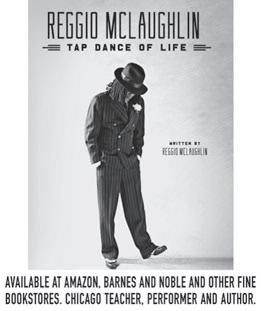

















62 CHICAGO READER - OCTOBER 13, 2022 ll Outside Noise Reduction Keeps Bugs & Spiders Out Reduce or Eliminate Fog & Water Noise from Outside? Visit stormsnaps.com or noisewindows.com sales@stormsnaps.com Alpina Manufacturing, Chicago, IL 1-800-915-2828 Soundproofing Window Inserts the platform The Chicago Reader Guide to Business and Professional Services To advertise, e-mail ads@chicagoreader.com home improvement legalbooks Fun, Clean, Picture Frame assembly JOB $18/hour Tired or bored of clicking away on a keyboard working at home? Keep your hands and mind busy with a fun, safe, clean assembly job. You’d have your own large assembly zone, at least 15-20 feet away from others, so we’re really safe here. Top rated rm Alpina Manufacturing LLC founded in 1992 Beautiful campus in Galewood, near Mars candy, 3 blocks north of Oak Park. We build and sell display framing systems to customers nationwide including Wal-Mart, Verizon, Circle K gas stations, Hospitals. Full time, Part time, Flex hours for working parents or students. We train, no travel, work in Galewood. Open to any backgrounds. Excellent pay, friendly caring management. Stop in anytime between 7am and 4pm M-F ask for Izzy to apply and check us out. Alpina Manufacturing 6460 W Cortland St., Chicago, IL 60707 Brigi e Schmidt Bell, P.C. 847-733-0933 lawyers@bsbpc.com Brigi eBell.com Brigi eSchmidtBellPC Considering Divorce? We Can Help. Collaborative | Prenuptual Divorce | Mediation mental health YOUR AD HERE dance What Greta said . . . 5301N.ClarkSt.Fl.2 CHICAGODANCESUPPLY.COM 773-728-5344 773-616-6969 1234/1250 S. Michigan Ave. In/out. Must call 8 am-9 pm. No annoying texts. European Relax Massage Licensed & Certified Cupping health & wellness shop local Customized Massage Therapy, Intuitive Energy Work, and Holistic Talk Therapy 2514 W Armitage Ave, Suite 211 Chicago, IL 60647 773-697-9278 www.intuithealing.com Open Thursday-Monday BY APPOINTMENT ONLY A Matter of Consequences by Michael W. Falls Available on Amazon and Booklocker A Classic Chicago Mystery









































































OCTOBER 13, 2022 - CHICAGO READER 63 Let’s Play! Make time to learn something new with music and dance classes at Old Town School! We offer flexible schedules for all skill levels both in-person and online. oldtownschool.org Sign up for classes today at MUSIC CLASSES FOR ADULTS & KIDS LINCOLN SQUARE LINCOLN PARK SOUTH LOOP & ONLINE OTS_1_2V_ClassAd_072921.indd 1 7/23/21 2:21 PM 10/29 @ Thalia hall Illuminati hotties 331661_4.75_x_4.75.indd 1 2/23/22 12:37 PM



NEW DIGITAL BANKING 1 POWERED BY PEOPLE YOU CAN TRUST. Switch to the bank J.D. Power ranks # 1 in customer satisfaction with consumer banking in Illinois. WINTRUST.COM/DIGITAL Banking products provided by Wintrust Financial Corp. banks. Wintrust Community Banks received the highest score in Illinois in the J.D. Power 2022 U.S. Retail Banking Satisfaction Study of customers’ satisfaction with their primary bank. Visit jdpower.com/awards for more details. 1. Digital Banking Services. Online or mobile banking is required to access Zelle®. Internet/mobile connectivity is required. Mobile banking is required to access remote deposit capture. Deposits made through mobile banking or remote deposit capture are subject to deposit limits and funds are typically available by next business day. Deposit limits may change at any time. Third-party message and data rates may apply. Other restrictions apply. For more information go to: wintrust.com/agreement-and-disclosure.








































































































































































































 By ERIN MCGROARTY
By ERIN MCGROARTY






























 BY REBECCA GILMAN
ROBERT
BY REBECCA GILMAN
ROBERT


 REVIEW
REVIEW





















































































































































